If you're seeing this message, it means we're having trouble loading external resources on our website.
If you're behind a web filter, please make sure that the domains *.kastatic.org and *.kasandbox.org are unblocked.
To log in and use all the features of Khan Academy, please enable JavaScript in your browser.

World history
Course: world history > unit 1.
- Ancient Egypt and the Nile River Valley
Ancient Egyptian civilization
- The Hittite Empire and the Battle of Kadesh
- The Hittites and Ancient Anatolia
- Ancient Egypt
- Egyptian civilization developed along the Nile River in large part because the river’s annual flooding ensured reliable, rich soil for growing crops.
- Repeated struggles for political control of Egypt showed the importance of the region's agricultural production and economic resources.
- The Egyptians kept written records using a writing system known as hieroglyphics.
- Egyptian rulers used the idea of divine kingship and constructed monumental architecture to demonstrate and maintain power.
- Ancient Egyptians developed wide-reaching trade networks along the Nile, in the Red Sea, and in the Near East.
Early Egypt
Old kingdom egypt: 2686-2181 bce, middle kingdom: 2000-1700 bce, new kingdom: 1550-1077 bce, third intermediate period: 1069-664 bce, what do you think.
- Why was the Nile River essential to Egyptian civilization?
- How might a writing system like hieroglyphics have helped rulers gain and maintain political power?
- What was one difference between common people and elites?
- How did rulers use religion to support their positions?
- Why do you think Egypt was invaded so frequently throughout its history?
Want to join the conversation?
- Upvote Button navigates to signup page
- Downvote Button navigates to signup page
- Flag Button navigates to signup page

Home — Essay Samples — History — Ancient Egypt — Egypt Civilization
Egypt Civilization
- Categories: Ancient Egypt
About this sample

Words: 800 |
Published: Mar 19, 2024
Words: 800 | Pages: 2 | 4 min read
Table of contents
I. introduction, ii. social structure in ancient egypt, iii. religious beliefs of ancient egypt, iv. artistic achievements in ancient egypt, v. legacy of ancient egypt civilization, vi. conclusion.

Cite this Essay
Let us write you an essay from scratch
- 450+ experts on 30 subjects ready to help
- Custom essay delivered in as few as 3 hours
Get high-quality help

Prof. Kifaru
Verified writer
- Expert in: History

+ 120 experts online
By clicking “Check Writers’ Offers”, you agree to our terms of service and privacy policy . We’ll occasionally send you promo and account related email
No need to pay just yet!
Related Essays
1 pages / 292 words
2 pages / 746 words
1 pages / 623 words
1 pages / 674 words
Remember! This is just a sample.
You can get your custom paper by one of our expert writers.
121 writers online
Still can’t find what you need?
Browse our vast selection of original essay samples, each expertly formatted and styled
Related Essays on Ancient Egypt
Egypt, located in the northeastern corner of Africa, has a rich historical legacy that spans over thousands of years. From the rise of ancient civilizations to its modern-day geopolitical significance, Egypt's history has shaped [...]
Pharaoh Khufu, also known as Cheops, is perhaps best known for overseeing the construction of the Great Pyramid of Giza, one of the Seven Wonders of the Ancient World. This monumental achievement has captivated the imagination [...]
Mesopotamia, commonly referred to as the "cradle of civilization," was located in the region of modern-day Iraq and parts of Syria, Turkey, and Iran. Its unique climate and geography played a significant role in shaping the [...]
King Akhenaten, also known as Amenhotep IV, was an ancient Egyptian pharaoh who is best known for his religious reforms and his establishment of a new capital city. His reign was marked by significant changes in religious [...]
The various groups of people that have existed throughout history (both groups that no longer exist, and groups that are still in existence today) have a number of things in common, as well as a multitude of differences. Two [...]
The roles of women and families of an Egyptian and Mesopotamian culture share some similarities and differences. Women in both cultures take good care of their family as the center piece of a family; a mother and wife. In [...]
Related Topics
By clicking “Send”, you agree to our Terms of service and Privacy statement . We will occasionally send you account related emails.
Where do you want us to send this sample?
By clicking “Continue”, you agree to our terms of service and privacy policy.
Be careful. This essay is not unique
This essay was donated by a student and is likely to have been used and submitted before
Download this Sample
Free samples may contain mistakes and not unique parts
Sorry, we could not paraphrase this essay. Our professional writers can rewrite it and get you a unique paper.
Please check your inbox.
We can write you a custom essay that will follow your exact instructions and meet the deadlines. Let's fix your grades together!
Get Your Personalized Essay in 3 Hours or Less!
We use cookies to personalyze your web-site experience. By continuing we’ll assume you board with our cookie policy .
- Instructions Followed To The Letter
- Deadlines Met At Every Stage
- Unique And Plagiarism Free
- History Classics
- Your Profile
- Find History on Facebook (Opens in a new window)
- Find History on Twitter (Opens in a new window)
- Find History on YouTube (Opens in a new window)
- Find History on Instagram (Opens in a new window)
- Find History on TikTok (Opens in a new window)
- This Day In History
- History Podcasts
- History Vault
Ancient Egypt
By: History.com Editors
Updated: April 24, 2023 | Original: October 14, 2009

Ancient Egypt was the preeminent civilization in the Mediterranean world for almost 30 centuries—from its unification around 3100 B.C. to its conquest by Alexander the Great in 332 B.C. From the great pyramids of the Old Kingdom through the military conquests of the New Kingdom, Egypt’s majesty has long entranced archaeologists and historians and created a vibrant field of study all its own: Egyptology. The main sources of information about ancient Egypt are the many monuments, objects and artifacts that have been recovered from archaeological sites, covered with hieroglyphs that have only recently been deciphered. The picture that emerges is of a culture with few equals in the beauty of its art, the accomplishment of its architecture or the richness of its religious traditions.
Predynastic Period (c. 5000-3100 B.C.)
Few written records or artifacts have been found from the Predynastic Period, which encompassed at least 2,000 years of gradual development of the Egyptian civilization.
Did you know? During the rule of Akhenaton, his wife Nefertiti played an important political and religious role in the monotheistic cult of the sun god Aton. Images and sculptures of Nefertiti depict her famous beauty and role as a living goddess of fertility.
Neolithic (late Stone Age ) communities in northeastern Africa exchanged hunting for agriculture and made early advances that paved the way for the later development of Egyptian arts and crafts, technology, politics and religion (including a great reverence for the dead and possibly a belief in life after death).
Around 3400 B.C., two separate kingdoms were established near the Fertile Crescent , an area home to some of the world’s oldest civilizations: the Red Land to the north, based in the Nile River Delta and extending along the Nile perhaps to Atfih; and the White Land in the south, stretching from Atfih to Gebel es-Silsila. A southern king, Scorpion, made the first attempts to conquer the northern kingdom around 3200 B.C. A century later, King Menes would subdue the north and unify the country, becoming the first king of the first dynasty.
Archaic (Early Dynastic) Period (c. 3100-2686 B.C.)
King Menes founded the capital of ancient Egypt at White Walls (later known as Memphis), in the north, near the apex of the Nile River delta. The capital would grow into a great metropolis that dominated Egyptian society during the Old Kingdom period. The Archaic Period saw the development of the foundations of Egyptian society, including the all-important ideology of kingship. To the ancient Egyptians, the king was a godlike being, closely identified with the all-powerful god Horus. The earliest known hieroglyphic writing also dates to this period.
In the Archaic Period, as in all other periods, most ancient Egyptians were farmers living in small villages, and agriculture (largely wheat and barley) formed the economic base of the Egyptian state. The annual flooding of the great Nile River provided the necessary irrigation and fertilization each year; farmers sowed the wheat after the flooding receded and harvested it before the season of high temperatures and drought returned.
Old Kingdom: Age of the Pyramid Builders (c. 2686-2181 B.C.)
The Old Kingdom began with the third dynasty of pharaohs. Around 2630 B.C., the third dynasty’s King Djoser asked Imhotep, an architect, priest and healer, to design a funerary monument for him; the result was the world’s first major stone building, the Step-Pyramid at Saqqara, near Memphis. Egyptian pyramid -building reached its zenith with the construction of the Great Pyramid at Giza, on the outskirts of Cairo. Built for Khufu (or Cheops, in Greek), who ruled from 2589 to 2566 B.C., the pyramid was later named by classical historians as one of the Seven Wonders of the Ancient World . The ancient Greek historian Herodotus estimated that it took 100,000 men 20 years to build it. Two other pyramids were built at Giza for Khufu’s successors Khafra (2558-2532 B.C) and Menkaura (2532-2503 B.C.).
During the third and fourth dynasties, Egypt enjoyed a golden age of peace and prosperity. The pharaohs held absolute power and provided a stable central government; the kingdom faced no serious threats from abroad; and successful military campaigns in foreign countries like Nubia and Libya added to its considerable economic prosperity. Over the course of the fifth and sixth dynasties, the king’s wealth was steadily depleted, partially due to the huge expense of pyramid-building, and his absolute power faltered in the face of the growing influence of the nobility and the priesthood that grew up around the sun god Ra (Re). After the death of the sixth dynasty’s King Pepy II, who ruled for some 94 years, the Old Kingdom period ended in chaos.
First Intermediate Period (c. 2181-2055 B.C.)
On the heels of the Old Kingdom’s collapse, the seventh and eighth dynasties consisted of a rapid succession of Memphis-based rulers until about 2160 B.C., when the central authority completely dissolved, leading to civil war between provincial governors. This chaotic situation was intensified by Bedouin invasions and accompanied by famine and disease.
From this era of conflict emerged two different kingdoms: A line of 17 rulers (dynasties nine and 10) based in Heracleopolis ruled Middle Egypt between Memphis and Thebes, while another family of rulers arose in Thebes to challenge Heracleopolitan power. Around 2055 B.C., the Theban prince Mentuhotep managed to topple Heracleopolis and reunited Egypt, beginning the 11th dynasty and ending the First Intermediate Period.
Middle Kingdom: 12th Dynasty (c. 2055-1786 B.C.)
After the last ruler of the 11th dynasty, Mentuhotep IV, was assassinated, the throne passed to his vizier, or chief minister, who became King Amenemhet I, founder of dynasty 12. A new capital was established at It-towy, south of Memphis, while Thebes remained a great religious center. During the Middle Kingdom, Egypt once again flourished, as it had during the Old Kingdom. The 12th dynasty kings ensured the smooth succession of their line by making each successor co-regent, a custom that began with Amenemhet I.
Middle-Kingdom Egypt pursued an aggressive foreign policy, colonizing Nubia (with its rich supply of gold, ebony, ivory and other resources) and repelling the Bedouins who had infiltrated Egypt during the First Intermediate Period. The kingdom also built diplomatic and trade relations with Syria , Palestine and other countries; undertook building projects including military fortresses and mining quarries; and returned to pyramid-building in the tradition of the Old Kingdom. The Middle Kingdom reached its peak under Amenemhet III (1842-1797 B.C.); its decline began under Amenenhet IV (1798-1790 B.C.) and continued under his sister and regent, Queen Sobekneferu (1789-1786 B.C.), who was the first confirmed female ruler of Egypt and the last ruler of the 12th dynasty.
Second Intermediate Period (c. 1786-1567 B.C.)
The 13th dynasty marked the beginning of another unsettled period in Egyptian history, during which a rapid succession of kings failed to consolidate power. As a consequence, during the Second Intermediate Period Egypt was divided into several spheres of influence. The official royal court and seat of government was relocated to Thebes, while a rival dynasty (the 14th), centered on the city of Xois in the Nile delta, seems to have existed at the same time as the 13th.
Around 1650 B.C., a line of foreign rulers known as the Hyksos took advantage of Egypt’s instability to take control. The Hyksos rulers of the 15th dynasty adopted and continued many of the existing Egyptian traditions in government as well as culture. They ruled concurrently with the line of native Theban rulers of the 17th dynasty, who retained control over most of southern Egypt despite having to pay taxes to the Hyksos. (The 16th dynasty is variously believed to be Theban or Hyksos rulers.) Conflict eventually flared between the two groups, and the Thebans launched a war against the Hyksos around 1570 B.C., driving them out of Egypt.
New Kingdom (c. 1567-1085 B.C.)
Under Ahmose I, the first king of the 18th dynasty, Egypt was once again reunited. During the 18th dynasty, Egypt restored its control over Nubia and began military campaigns in Palestine , clashing with other powers in the area such as the Mitannians and the Hittites. The country went on to establish the world’s first great empire, stretching from Nubia to the Euphrates River in Asia. In addition to powerful kings such as Amenhotep I (1546-1526 B.C.), Thutmose I (1525-1512 B.C.) and Amenhotep III (1417-1379 B.C.), the New Kingdom was notable for the role of royal women such as Queen Hatshepsut (1503-1482 B.C.), who began ruling as a regent for her young stepson (he later became Thutmose III, Egypt’s greatest military hero), but rose to wield all the powers of a pharaoh.
The controversial Amenhotep IV (c. 1379-1362), of the late 18th dynasty, undertook a religious revolution, disbanding the priesthoods dedicated to Amon-Re (a combination of the local Theban god Amon and the sun god Re) and forcing the exclusive worship of another sun-god, Aton. Renaming himself Akhenaton (“servant of the Aton”), he built a new capital in Middle Egypt called Akhetaton, known later as Amarna. Upon Akhenaton’s death, the capital returned to Thebes and Egyptians returned to worshiping a multitude of gods. The 19th and 20th dynasties, known as the Ramesside period (for the line of kings named Ramses) saw the restoration of the weakened Egyptian empire and an impressive amount of building, including great temples and cities. According to biblical chronology, the exodus of Moses and the Israelites from Egypt possibly occurred during the reign of Ramses II (1304-1237 B.C.).
All of the New Kingdom rulers (with the exception of Akhenaton) were laid to rest in deep, rock-cut tombs (not pyramids) in the Valley of the Kings, a burial site on the west bank of the Nile opposite Thebes. Most of them were raided and destroyed, with the exception of the tomb and treasure of Tutankhamen (c.1361-1352 B.C.), discovered largely intact in A.D. 1922. The splendid mortuary temple of the last great king of the 20th dynasty, Ramses III (c. 1187-1156 B.C.), was also relatively well preserved, and indicated the prosperity Egypt still enjoyed during his reign. The kings who followed Ramses III were less successful: Egypt lost its provinces in Palestine and Syria for good and suffered from foreign invasions (notably by the Libyans), while its wealth was being steadily but inevitably depleted.
Third Intermediate Period (c. 1085-664 B.C.)
The next 400 years–known as the Third Intermediate Period–saw important changes in Egyptian politics, society and culture. Centralized government under the 21st dynasty pharaohs gave way to the resurgence of local officials, while foreigners from Libya and Nubia grabbed power for themselves and left a lasting imprint on Egypt’s population. The 22nd dynasty began around 945 B.C. with King Sheshonq, a descendant of Libyans who had invaded Egypt during the late 20th dynasty and settled there. Many local rulers were virtually autonomous during this period and dynasties 23-24 are poorly documented.
In the eighth century B.C., Nubian pharaohs beginning with Shabako, ruler of the Nubian kingdom of Kush, established their own dynasty–the 25th–at Thebes. Under Kushite rule, Egypt clashed with the growing Assyrian empire. In 671 B.C., the Assyrian ruler Esarhaddon drove the Kushite king Taharka out of Memphis and destroyed the city; he then appointed his own rulers out of local governors and officials loyal to the Assyrians. One of them, Necho of Sais, ruled briefly as the first king of the 26th dynasty before being killed by the Kushite leader Tanuatamun, in a final, unsuccessful grab for power.
From the Late Period to Alexander’s Conquest (c.664-332 B.C.)
Beginning with Necho’s son, Psammetichus, the Saite dynasty ruled a reunified Egypt for less than two centuries. In 525 B.C., Cambyses, king of Persia, defeated Psammetichus III, the last Saite king, at the Battle of Pelusium, and Egypt became part of the Persian Empire . Persian rulers such as Darius (522-485 B.C.) ruled the country largely under the same terms as native Egyptian kings: Darius supported Egypt’s religious cults and undertook the building and restoration of its temples. The tyrannical rule of Xerxes (486-465 B.C.) sparked increased uprisings under him and his successors. One of these rebellions triumphed in 404 B.C., beginning one last period of Egyptian independence under native rulers (dynasties 28-30).
In the mid-fourth century B.C., the Persians again attacked Egypt, reviving their empire under Ataxerxes III in 343 B.C. Barely a decade later, in 332 B.C., Alexander the Great of Macedonia defeated the armies of the Persian Empire and conquered Egypt. After Alexander’s death, Egypt was ruled by a line of Macedonian kings, beginning with Alexander’s general Ptolemy and continuing with his descendants. The last ruler of Ptolemaic Egypt–the legendary Cleopatra VII–surrendered Egypt to the armies of Octavian (later Augustus ) in 31 B.C. Six centuries of Roman rule followed, during which Christianity became the official religion of Rome and the Roman Empire’s provinces (including Egypt). The conquest of Egypt by the Arabs in the seventh century A.D. and the introduction of Islam would do away with the last outward aspects of ancient Egyptian culture and propel the country towards its modern incarnation.
Photo Galleries
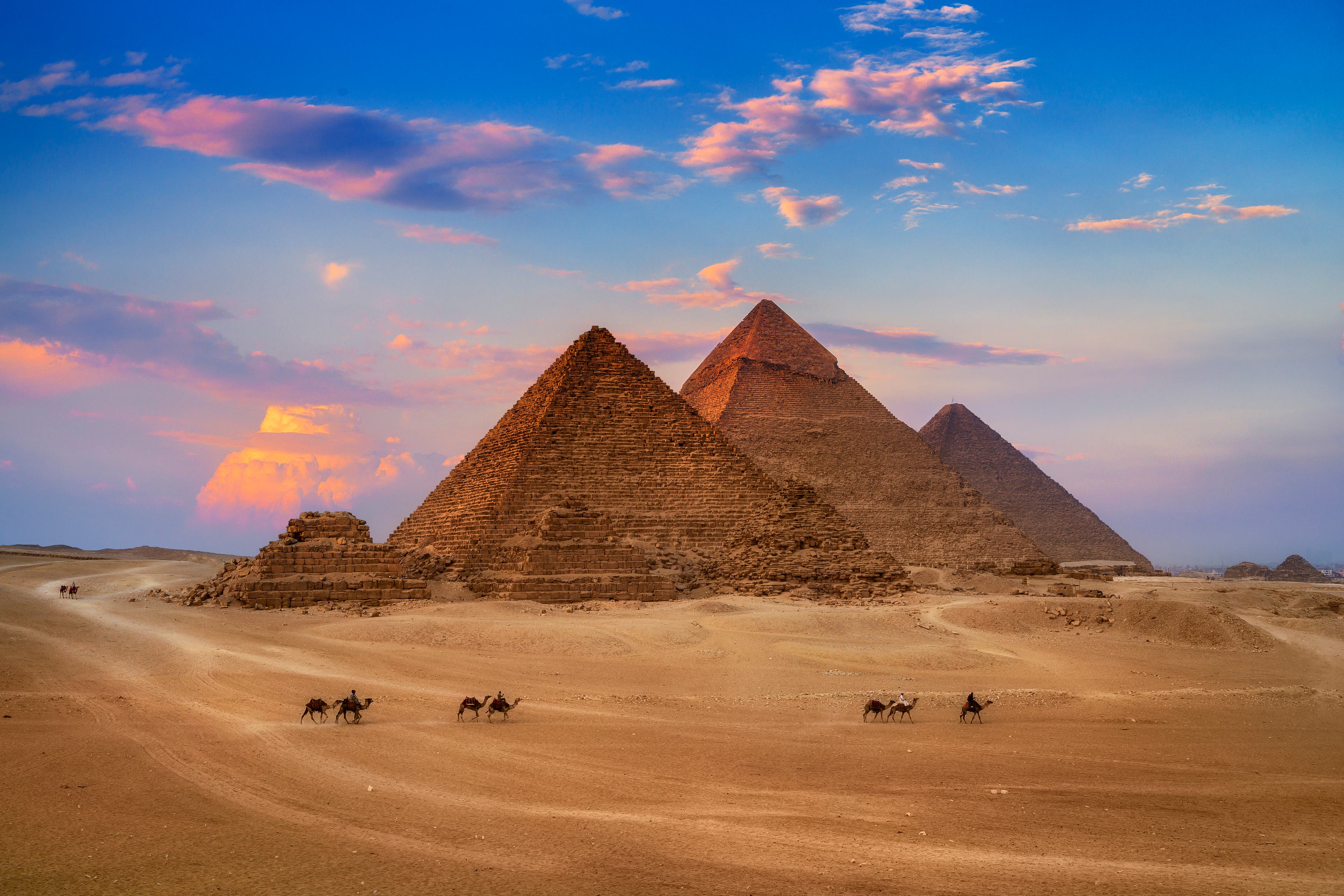
HISTORY Vault: Ancient History
From Egypt to Greece, explore fascinating documentaries about the ancient world.

Sign up for Inside History
Get HISTORY’s most fascinating stories delivered to your inbox three times a week.
By submitting your information, you agree to receive emails from HISTORY and A+E Networks. You can opt out at any time. You must be 16 years or older and a resident of the United States.
More details : Privacy Notice | Terms of Use | Contact Us
Ancient Egypt: History, dynasties, religion and writing
The rich history of ancient Egypt involves power struggles, amazing feats of engineering, advances in writing and art, and more.
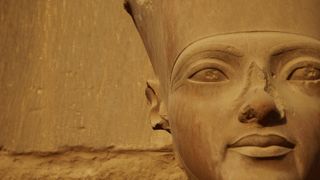
- Dynasties and pharaohs
- Religion and Gods
Egyptian writing
Additional resources.
Ancient Egypt in North Africa was one of the most powerful and influential civilizations in the region for over 3,000 years, from around 3100 B.C to 30 B.C. It left behind numerous monuments, documents and works of art that continue to be studied by scholars today.
However Egyptian civilization existed long before this period, and it has survived and flourished since. While the civilization's rulers, language, writing, climate, religion and borders have changed many times over the millennia, Egypt still exists as a modern-day country.
Ancient Egypt was closely connected with other parts of the world, bringing in and exporting goods, religions, food, people and ideas. At times ancient Egypt ruled territory outside the modern-day country's border, controlling territory in what is now Sudan, Cyprus, Lebanon, Syria, Israel and Palestine.
The country was also occupied by other powers in ancient times — the Persians , Nubians , Greeks and Romans all conquered Egypt at different points.
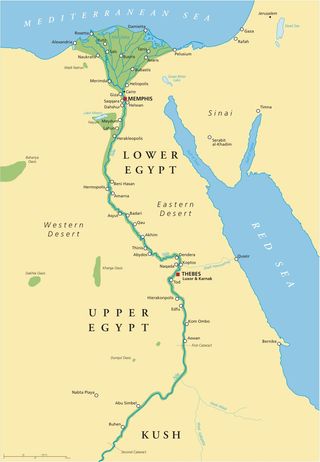
A number of names were used for Egypt. A popular ancient name for Egypt was "Kemet," which means the "black land." Scholars generally believe that this name derived from the fertile soil that was left over when the Nile flood receded in August.
The Nile flooded between June and August each year, and the fertile soil it created was vital to ancient Egypt's survival, with fertility playing an important role in Egyptian religion. The burial of Tutankhamun — in which his penis was mummified — is but one example of how important fertility was in the rituals and beliefs of the ancient Egyptians.
The country's ancient rulers are referred to today as "pharaohs," although in ancient times they each used a series of names as part of a royal titular, wrote Ronald Leprohon , a professor emeritus of Egyptology at the University of Toronto, in his book " The Great Name: Ancient Egyptian Royal Titulary " (Society of Biblical Literature, 2013). The word pharaoh originates from the Egyptian term "per-aa," which means "the Great House," Leprohon wrote. The term was first incorporated into a royal title during the rule of Thutmose III (reign circa. 1479 to 1425 B.C.), Leprohon wrote.
Ronald Leprohon received his doctorate from the University of Toronto. He has done archaeological work in Egypt for the Akhenaten Temple Project and the Dakhleh Oasis Project. He became the first director of the Canadian Institute in Egypt in 1981 and worked as a professor of Egyptology and was chair of the Department of Near and Middle Eastern Civilizations at the University of Toronto. He has published a two-volume study of the funerary stelae in the Boston Museum of Fine Arts (1985 and 1991) and "The Great Name. Ancient Egyptian Royal Titulary," a book on the 3,000-year history of the titulary of the pharaohs.
Egypt's Prehistory
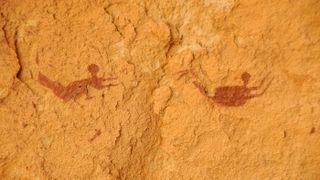
When exactly early hominids first arrived in Egypt is unclear. The earliest migration of hominids out of Africa took place almost 2 million years ago, with modern humans dispersing out of Africa about 100,000 years ago. Egypt may have been used to reach Asia in some of these migrations.
Villages dependent on agriculture began to appear in Egypt about 7,000 years ago. The civilization's earliest written inscriptions date back about 5,200 years and reveal information about the early rulers of Egypt. These early rulers include Iry-Hor, who, according to the inscriptions, founded Memphis, a city that served as Egypt's capital for much of its history. The inscriptions also document a queen named Neith-Hotep, who ruled as a regent for a young pharaoh named Djer sometime In the late predynastic period.
Related: How old is ancient Egypt?
How and when ancient Egypt was united into one kingdom is a matter of debate among archaeologists and historians. One possibility is that a number of smaller states coalesced into two kingdoms — Upper and Lower Egypt — and then these two kingdoms united. After Egypt was united pharaohs were often depicted wearing two crowns — one for Lower Egypt and another for Upper Egypt.
Egypt's climate was much wetter in prehistoric times than it is today, and some areas that are now barren desert were once fertile. One famous archaeological site where this can be seen is at the 6,000- to 9,000-year-old rock art at the "cave of swimmers," as it is called today, on the Gilf Kebir plateau in southwest Egypt. The cave is now surrounded by miles of barren desert; however, it has rock art showing what some scholars interpret as people swimming. After this wet period ended around 5,000 years ago , the deserts of Egypt have remained pretty similar to how they are now, Joseph Manning , the William K. and Marilyn Milton Simpson professor of classics at Yale University, previously told Live Science.
Joseph Manning specializes in Hellenistic history, with a focus on the legal and economic history of Ptolemaic Egypt. His studies governance, reforms of the state, legal institutions, formation of markets and the impact of new economic institutions (coinage, banking) on traditional socio-economic patterns in the ancient world.
Egypt's dynasties and pharaohs

Ancient Egypt's history has traditionally been divided into 30 (or sometimes 31) dynasties. However, "the 'dynasties' of Egypt are really just retrospective constructs ," Michael Dee , an associate professor of isotope chronology at the University of Groningen in the Netherlands, previously told Live Science in an email.
The Egyptian priest Manetho, who lived during the third century B.C., started the dynasty construct. His accounts of ancient Egyptian history were preserved by ancient Greek writers and, until hieroglyphic writing was deciphered in the 19th century, were among the few historical accounts that scholars could read.
Modern-day scholars often group these dynasties into several periods. Dynasties one and two date back around 5,000 years and are often called the "Early Dynastic" or "Archaic" period. The first pharaoh of the first dynasty was a ruler named Menes (or Narmer, as he is called in Greek). He lived over 5,000 years ago, and while ancient writers sometimes credited him as being the first pharaoh of a united Egypt, however archaeological research suggests that this is not true. Recently found inscriptions tell of rulers — such as Djer and Iry-Hor — who appear to have ruled earlier and other finds have been made which suggest that there were pharaohs before Menes who ruled a united Egypt . Scholars sometimes refer to these pre-Menes rulers as being part of a "dynasty zero."
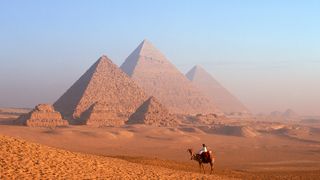
Dynasties three to six date from roughly 2650 to 2150 B.C. and are often grouped together into a time period called the "Old Kingdom" by modern-day scholars. During this time pyramid-building techniques were developed and the pyramids of Giza were built. Papyri that are still being deciphered suggest that groups of professional workers — sometimes translated as "work gangs" — played a major role in the construction of the pyramids, as well as other structures.
From 2150 to 2030 B.C. (a time period that encompassed dynasties seven to 10 and part of 11) the central government in Egypt was weak and the country was often controlled by different regional leaders. Why the Old Kingdom collapsed is a matter of debate among scholars, with research indicating that drought and climate change played a significant role . During this time, cities and civilizations in the Middle East also collapsed, with evidence at archaeological sites indicating that a period of drought and arid climate hit sites across the region.
The 12th, 13th and part of the 11th dynasties are often called the "Middle Kingdom" by scholars and lasted from around 2030 to 1640 B.C. At the start of this dynasty, a ruler named Mentuhotep II (who reigned until about 2000 B.C.) regained control of the whole country. Pyramid building resumed in Egypt, and a sizable number of texts of literature and science were created. Among the surviving texts is a document now known as the Edwin Smith surgical papyrus, which records a variety of medical treatments that modern-day medical doctors have hailed as being advanced for their time.
Dynasties 14 to 17 are often grouped together as the "Second Intermediate Period" by modern-day scholars. During this time, the central government again collapsed in Egypt, and a group called the "Hyksos" rose to power, controlling much of northern Egypt. While the Hyksos may have originally been from the Levant (an area that encompasses modern-day Israel, Palestine, Lebanon, Jordan and Syria), research indicates that they were already in Egypt at the time the government collapsed. One gruesome find from this time period is a series of severed hands , which were found at a palace at the city of Avaris, the capital of Hyksos-controlled Egypt. The severed hands may have been presented by soldiers to a ruler in exchange for gold.
Scholars often refer to dynasties 18 to 20 as encompassing the "New Kingdom," a period that lasted around 1550 to 1070 B.C. This period took place after the Hyksos had been defeated by a series of Egyptian rulers and the country reunited. Perhaps the most famous archaeological site from the New Kingdom is the Valley of the Kings , which holds the burial sites of many Egyptian rulers from this period, including Tutankhamun (reign circa 1336 to 1327 B.C.), whose rich tomb was found intact in1922. The pharaohs stopped building pyramids during the New Kingdom for a variety of reasons — one of which was to provide better security against tomb robbers.
The 21st to 24th dynasties (a period from around 1070 to 713 B.C.) are often called the "Third Intermediate Period" by modern-day scholars. The central government was sometimes weak during this time period, and the country was not always united. During this time cities and civilizations across the Middle East had been destroyed by people from the Aegean, whom modern-day scholars sometimes call the "Sea Peoples." While Egyptian rulers claimed to have defeated the Sea Peoples in battle, it didn't prevent Egyptian civilization from collapsing. The loss of trade routes and revenue may have played a role in the weakening of Egypt's central government.
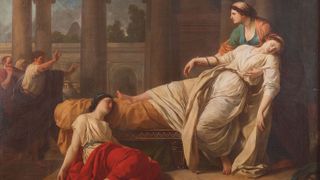
Dynasties 25 to 31 (from around 712 to 332 B.C.) are often referred to as the "Late Period" by scholars. Egypt was sometimes under the control of foreign powers during this time. The rulers of the 25th dynasty were from Nubia, an area located in modern-day southern Egypt and northern Sudan. The Persians and Assyrians also controlled Egypt at different times during the Late Period.
In 332 B.C. Alexander the Great drove the Persians out of Egypt and incorporated the country into the Macedonian Empire. After Alexander the Great's death, a line of rulers descended from Ptolemy Soter, one of Alexander's generals, came to power. The last of these "Ptolemaic" rulers (as scholars often call them) was Cleopatra VII , who died by suicide in 30 B.C after the defeat of her forces by Octavian, who would later be named the Roman emperor Augustus, at the Battle of Actium . After her death, Egypt was incorporated into the Roman Empire .
Although the Roman emperors were based in Rome, the Egyptians treated them as pharaohs. One excavated carving shows the emperor Claudius (reign A.D. 41 to 54) dressed as a pharaoh, Live Science reported . The carving has hieroglyphic inscriptions saying that Claudius is the "Son of Ra, Lord of the Crowns," and "King of Upper and Lower Egypt, Lord of the Two Lands."
Neither the Ptolemaic or Roman rulers are considered to be part of a numbered dynasty.
Ancient Egyptian Religion and Gods

Throughout much of Egypt's ancient history its people followed a polytheistic religion in which a vast number of gods and goddesses were venerated. One of the most important was Osiris, god of the underworld. Abydos was an important cult center for him, and numerous temples and shrines were constructed at the site in his honor.
Amun-Ra — a god associated with the sun — became particularly important during the New Kingdom and was associated with the city of Luxor (ancient Thebes). The Karnak Temple complex was built near Luxor in honor of this god.
Navigating the underworld was vital to the ancient Egyptians, who believed that the dead could reach a paradise of sorts, where they could live forever. Egyptian dead were sometimes mummified, preserving the body, and were sometimes buried with spells to aid them in navigating the underworld. These spells included excerpts from what are sometimes called the " Book of the Dead " — a 52-foot-long (16 meters) copy of which was recently found in a tomb at Saqqara .
In ancient Egyptian mythology, one of the first steps in navigating the underworld was to weigh a person's deeds against the feather of Maat, who was a god associated with truth, justice and order. If the person had committed a great deal of wrong, the person's heart would be heavier than the feather and the person's soul would be obliterated. On the other hand, if their deeds were generally good, they passed forward and had the opportunity to successfully navigate the underworld.
Figurines called shabti were often buried with the deceased. Their purpose was to do the deceased's work in the afterlife for them.
Egyptian religion did not remain static but changed over time. One major change occurred during the reign of the pharaoh Akhenaten (circa 1353 to 1335 B.C.), a ruler who unleashed a religious revolution that saw Egyptian religion become focused around the worship of "Aten" the sun disk. Akhenaten built an entirely new capital in the desert at Amarna and ordered the names of some of Egypt's deities to be defaced. After Akhenaten's death his son, Tutankhamun, denounced him and returned ancient Egypt to its previous polytheistic religion.
When Egypt came under Greek and Roman rule, the new rulers' gods and goddesses were incorporated into Egyptian religion. Another major change occurred after the first century A.D. when Christianity spread throughout Egypt. At this time Gnosticism, a religion that incorporated some Christian beliefs, also spread throughout Egypt, and a large corpus of Gnostic texts were discovered in 1945 in southern Egypt near the city of Nag Hammadi.
Islam spread throughout the country after A.D. 641, when the country was captured by a Muslim army. Today, Islam is practiced by the majority of Egypt's inhabitants, while a minority are Christian, many being part of the Coptic Church.
The earliest inscriptions date back about 5,200 years and were written in a hieroglyphic script.
"Ancient Egyptian was a living oral language, and most hieroglyphs represent the sounds of consonants and certain emphatically expressed vowels," wrote Barry Kemp, a professor of Egyptology at the University of Cambridge, England, in his book " 100 Hieroglyphs: Think Like an Egyptian " (Granta Books, 2005). Kemp noted that the ancient Egyptians also developed "an abbreviated 'long hand' form of writing which we call 'hieratic.'" During the first millennium A.D. this abbreviated hieratic script was supplanted by a new form of short-form writing called "Demotic."
Egyptian language changed over the millennia, with scholars often subdividing the surviving writings into categories such as "Old Egyptian," "Middle Egyptian" and "Late Egyptian."
The Greek language became widely used in the time after Egypt was conquered by Alexander the Great . In the late 19th century, archaeologists excavated half a million papyri fragments, most of which were written in Greek, at the ancient Egyptian town of Oxyrhynchus in southern Egypt, dating to the early centuries A.D.
Coptic, an Egyptian language that uses the Greek alphabet, was widely used after Christianity spread throughout Egypt. As Greek and Coptic grew in popularity, the use of the hieroglyphic writing style declined and became extinct during the fifth century A.D. After A.D. 641 the Arabic language spread in Egypt and is widely used in the country today.
- In this History Channel documentary , you'll learn how the ancient Egyptians harnessed the power of engineering to build an empire. The video is about 1.5 hours long.
- The Australian Museum put together a timeline of historic and other events in ancient Egypt, including a breakdown of each dynasty and the significant dates within that dynasty.
- This DK book " Ancient Egypt: The Definitive Visual History " could be a fun way to teach kids about the marvels of ancient Egypt.
Sign up for the Live Science daily newsletter now
Get the world’s most fascinating discoveries delivered straight to your inbox.

Owen Jarus is a regular contributor to Live Science who writes about archaeology and humans' past. He has also written for The Independent (UK), The Canadian Press (CP) and The Associated Press (AP), among others. Owen has a bachelor of arts degree from the University of Toronto and a journalism degree from Ryerson University.
Mysterious L-shaped structure found near Egyptian pyramids of Giza baffles scientists
See stunning reconstruction of ancient Egyptian mummy that languished at an Australian high school for a century
'Quantum-inspired' laser computing is more effective than both supercomputing and quantum computing, startup claims
Most Popular
- 2 EV batteries could last much longer thanks to new capacitor with 19-times higher energy density that scientists created by mistake
- 3 Can mirrors facing each other create infinite reflections?
- 4 'The most critically harmful fungi to humans': How the rise of C. auris was inevitable
- 5 2,500-year-old Illyrian helmet found in burial mound likely caused 'awe in the enemy'
- 2 Why can't we see the far side of the moon?
- 3 Space photo of the week: 'God's Hand' leaves astronomers scratching their heads
- 4 Papua New Guineans, genetically isolated for 50,000 years, carry Denisovan genes that help their immune system, study suggests
- 5 Massive study of 8,000 cats reveals which breeds live longest

The world of ancient Egypt
Few civilizations have enjoyed the longevity and global cultural reach of ancient Egypt. Their distinct visual expressions, writing system, and imposing monuments are instantly recognizable by viewers all around the world even today—put simply, their branding was on point.
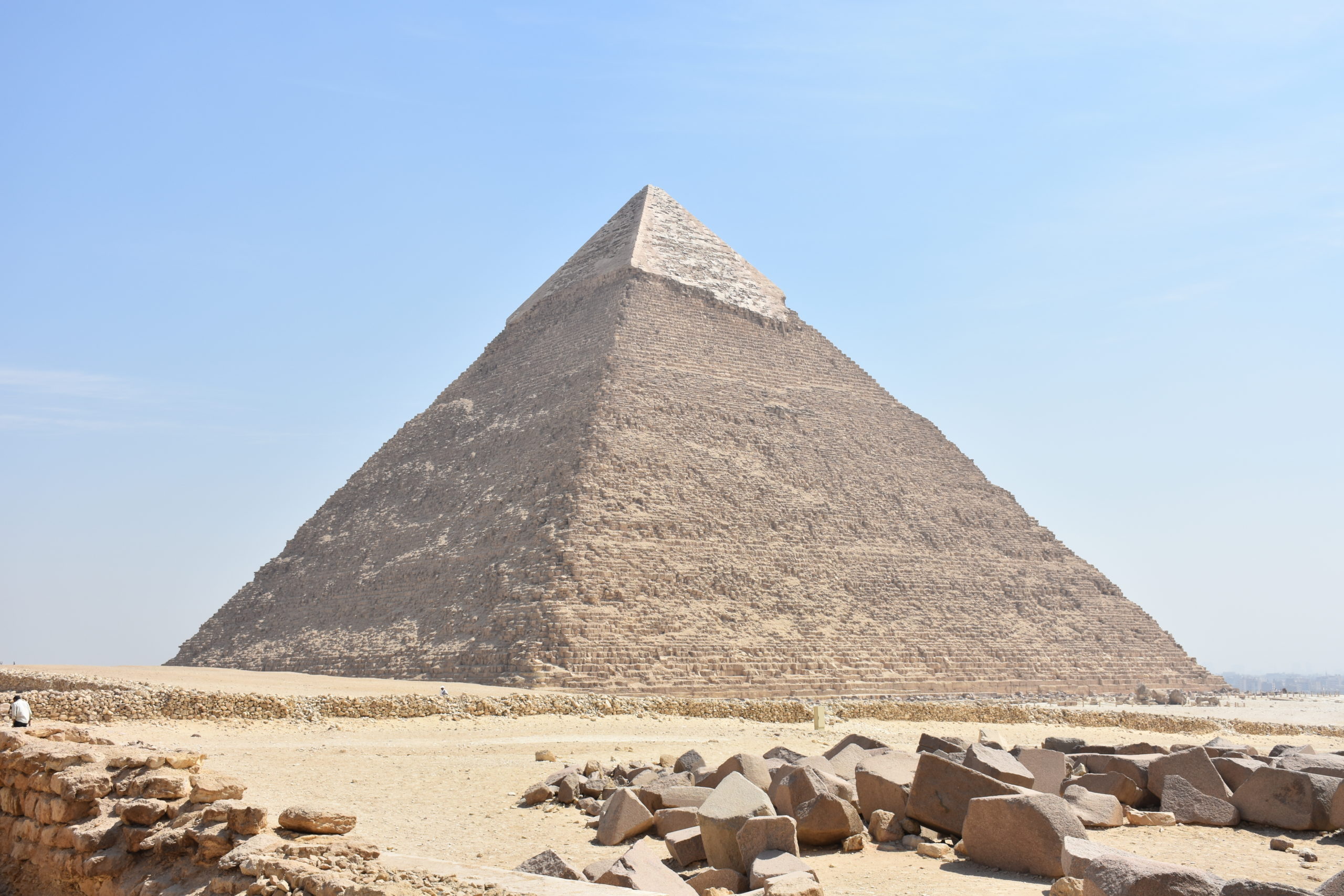
Pyramid of Khafre, Egypt (photo: MusikAnimal, CC BY-SA 3.0)
Despite portraying significant stability over a vast period of time, their civilization was not as static as it may appear at first glance, particularly if viewed through our modern eyes and cultural perspectives . Instead, the culture was dynamic even as it revolved around a stable core of imagery and concepts. The ancient Egyptians adjusted to new experiences, constantly adding to their complex beliefs about the divine and terrestrial realms, and how they interact. This flexibility, wrapped around a base of consistency, was part of the reason ancient Egypt survived for millennia and continues to fascinate.
Read an introductory essay about ancient Egypt
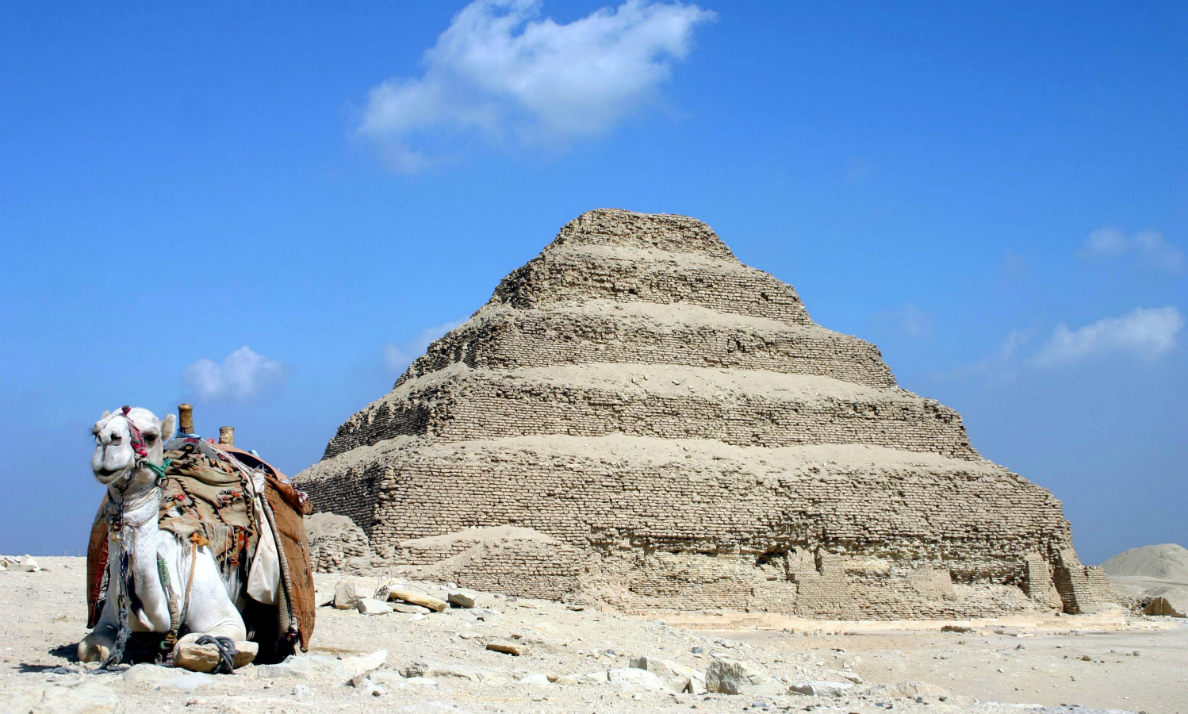
Ancient Egypt: an introduction
/ 1 Completed
The Natural World of Egypt
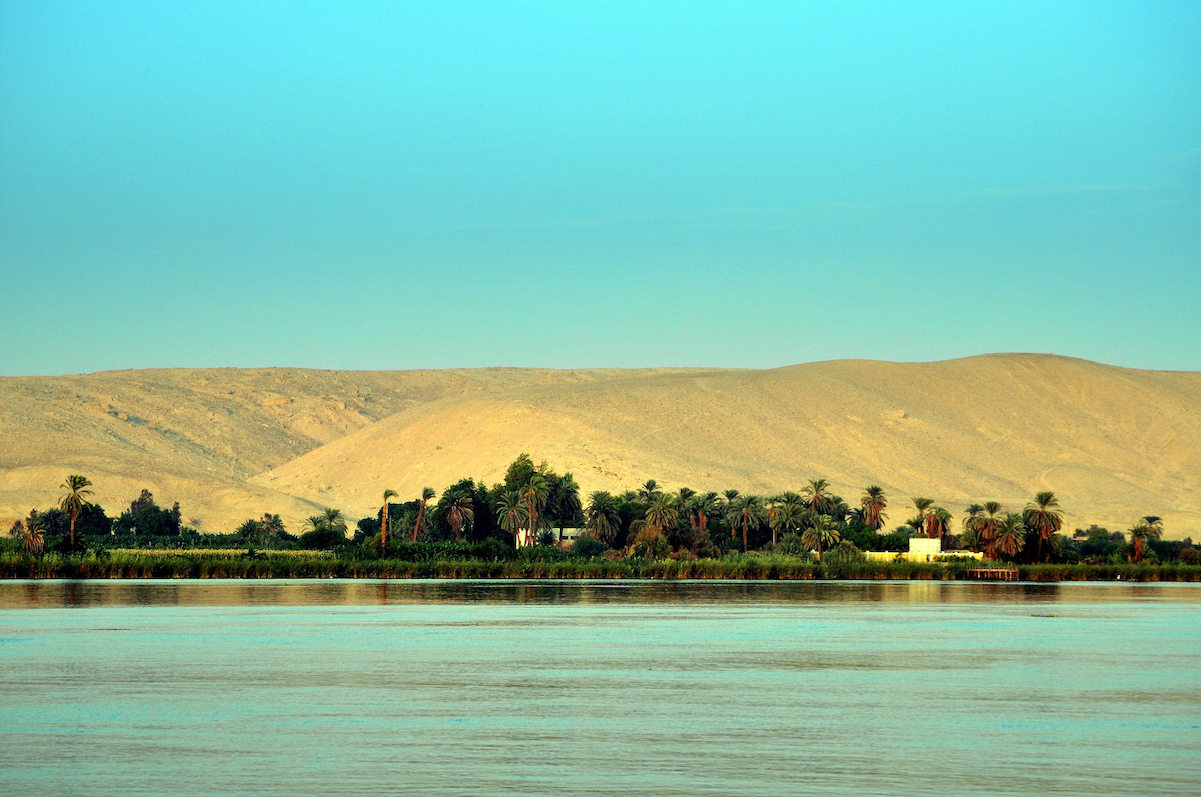
View of the Nile River, Egypt (photo: Badics, CC BY-SA 3.0)
With the blazing sun above, flanked by vast seas of shifting sand, and fed by the life-giving Nile River (which hid frightening creatures beneath its dark waters), the natural world of Egypt was inherently beautiful but also potentially deadly. Outside the lush river valley, there was little protection from the ever-dominant sun, whose intensity was both feared and revered. The deserts were home not only to many dangerous creatures, but the sands themselves were also unpredictable and constantly shifting. The clear night skies dazzled with millions of stars, some of which seemed to move of their own accord while others rose and fell at trackable intervals. The Nile, with its annual floods, brought fertility and renewal to the land, but could also overflow and wreak havoc on the villages that lined its banks. Careful observers of their environment, the Egyptians perceived divine forces in these phenomena and many of their deities, such as the powerful sun god Ra, were connected with elements from the natural world.
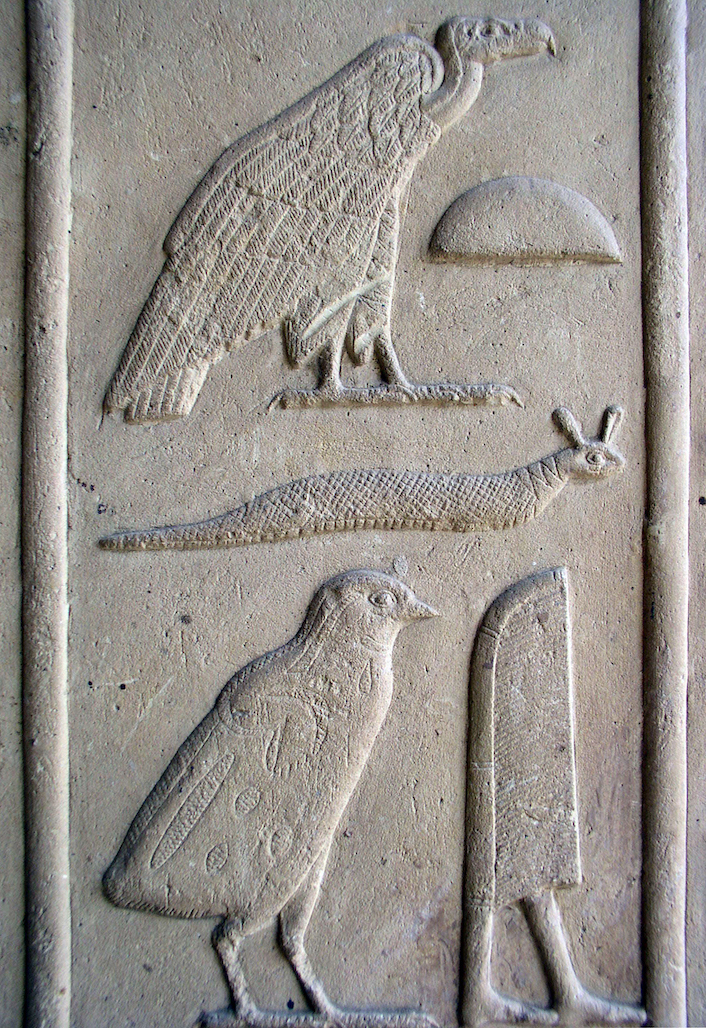
Hieroglyphs, detail from the White Chapel, Karnak (photo: Dr. Amy Calvert)
The perception of divine powers existing in the natural world was particularly true in connection with the animals that inhabited the region. There was an array of creatures that the Egyptians would have observed or interacted with on a regular basis and they feature heavily in the culture. One of the most distinctive visual attributes of Egyptian imagery is the myriad deities that were portrayed in hybrid form, with a human body and animal head. In addition, a wide range of birds, fishes, mammals, reptiles, and other creatures appear prominently in the hieroglyphic script —there are dozens of different birds alone.
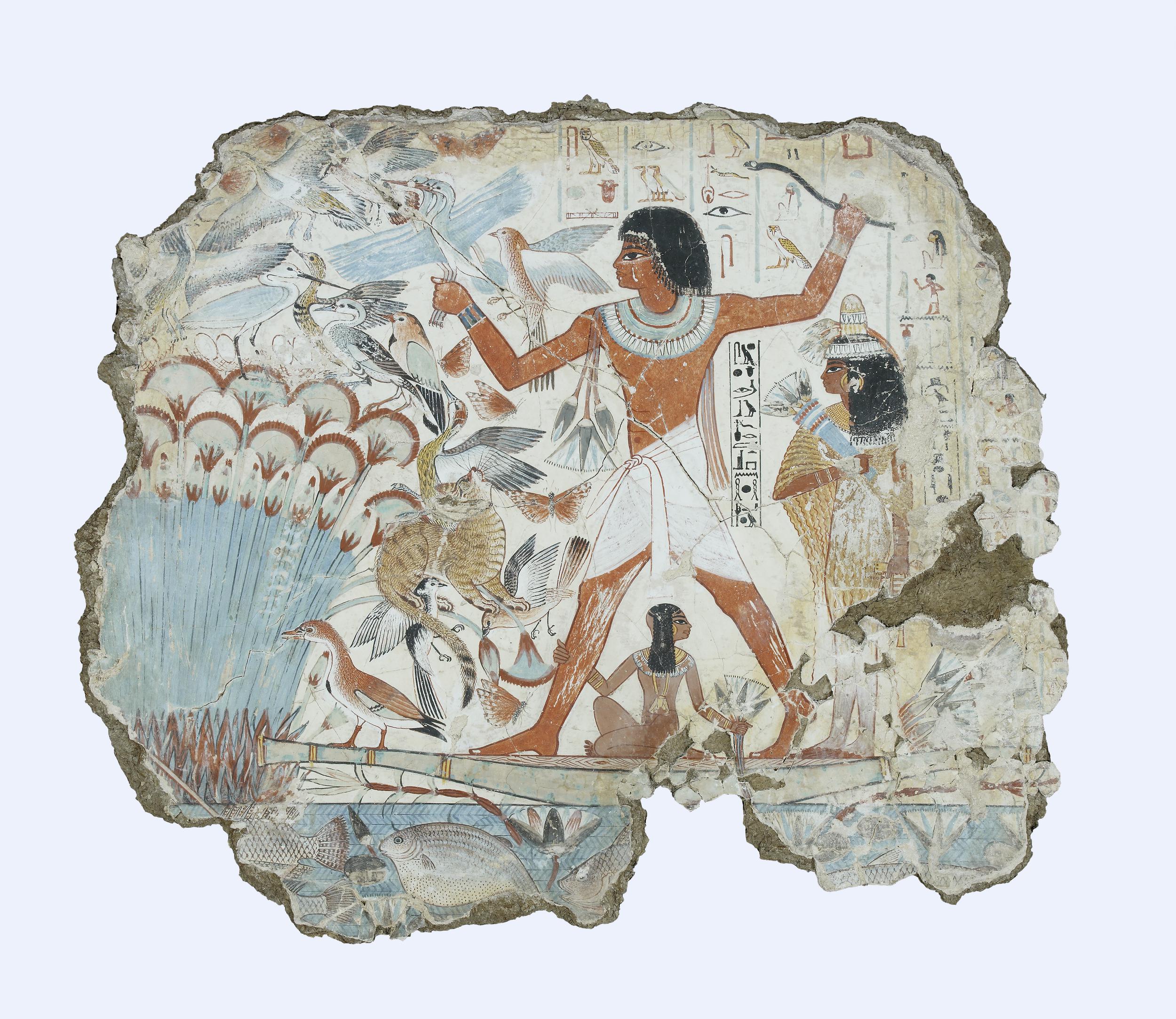
Nebamun fowling in the marshes, Tomb-chapel of Nebamun, c. 1350 B.C.E., 18th Dynasty, paint on plaster, 83 x 98 cm, Thebes (© Trustees of the British Museum)
The Nile was packed with numerous types of fish, which were recorded in great detail in fishing scenes that became a fixture in non-royal tombs. Most relief and painting throughout Egypt’s history was created for divine or mortuary settings and they were primarily intended to be functional. Many tomb scenes included the life-giving Nile and all it’s abundance with the goal of making that bounty available for the deceased in the afterlife. In addition to the array of fish, the river also teemed with far more dangerous animals, like crocodiles and hippopotami. Protective spells and magical gestures were used from early on to aid the Egyptians in avoiding those watery perils as they went about their daily lives.
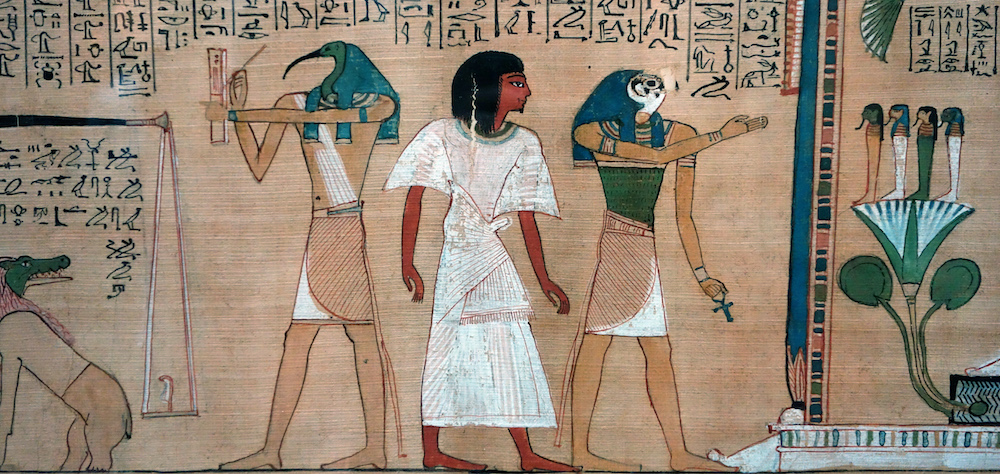
Hunefer (center) flanked by two deities: the ibis-headed Thoth (left) and the falcon-headed Horus (right), from Hunefer’s Judgement in the presence of Osiris, Book of the Dead of Hunefer, 19th Dynasty, New Kingdom, c. 1275 B.C.E., papyrus, Thebes, Egypt (British Museum)
The desert, likewise, was full of potentially dangerous creatures. Lions, leopards, jackals, cobras, and scorpions were all revered for their attributes and feared for their ferocity. Soaring above were birds of prey, like falcons who were sharp-eyed hunters, and massive vultures that consumed decaying flesh and fed it to their young. Scarab beetles also seemingly brought new life from decay and the sacred ibis with their curved beaks found sustenance hidden in the muddy banks of the Nile. All of these creatures (and many others) became closely associated with different deities very early in Egyptian history. The Egyptians did not worship animals; instead, certain animals were revered because it was believed that they were related to particular gods and thus served as earthly manifestations of those deities.
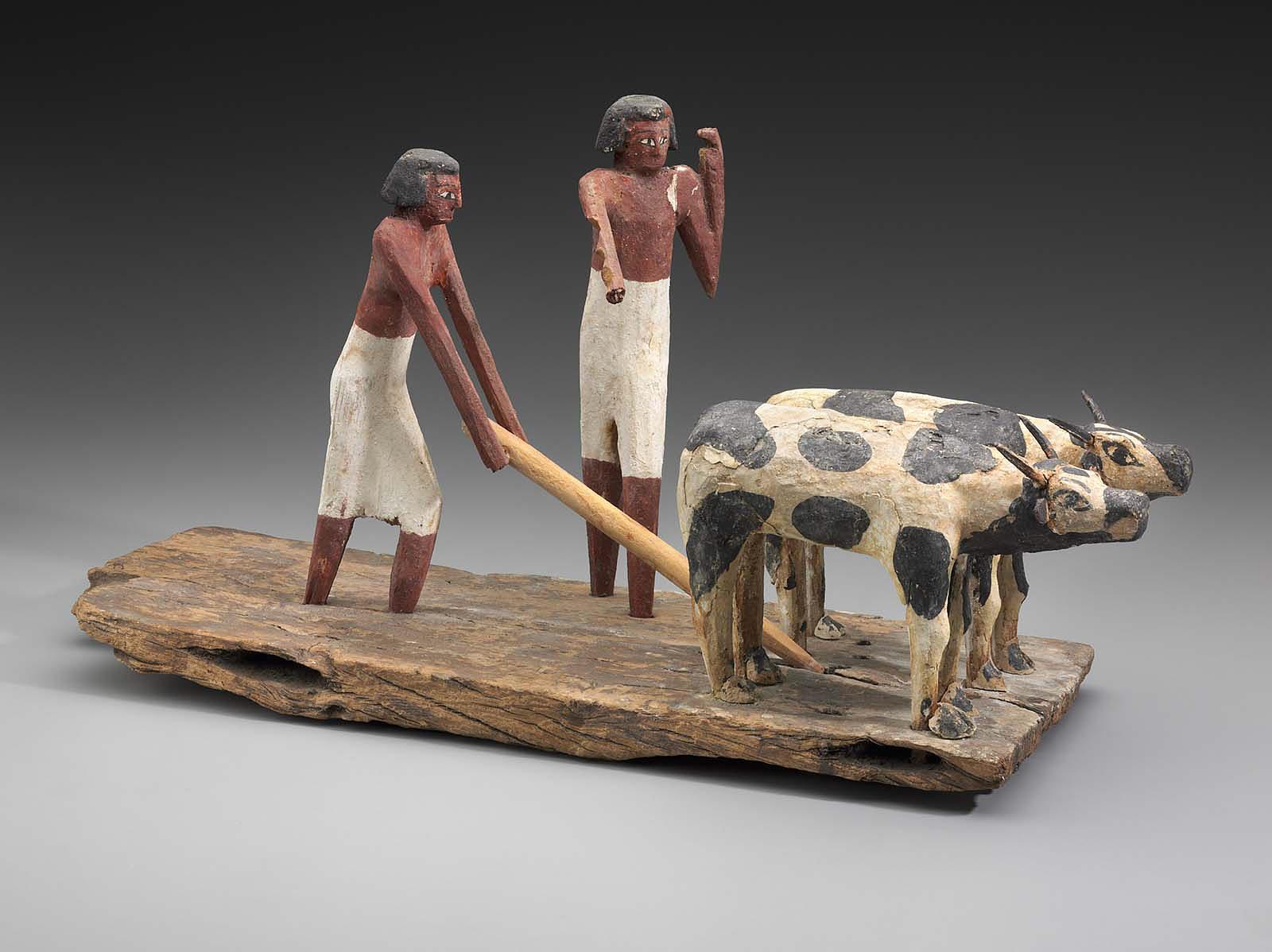
Model scene of workers ploughing a field, Middle Kingdom, late Dynasty 11, 2010–1961 B.C.E., wood, 54 cm (MFA Boston)
Even domesticated animals, such as cows, bulls, rams, and geese, became associated with deities and were viewed as vitally important. Cattle were probably the first animals to be domesticated in Egypt and domesticated cattle, donkeys, and rams appear along with wild animals on Predynastic and Early Dynastic votive objects , showing massive herds that were controlled by early rulers, demonstrating their wealth and prestige. Pastoral scenes of animal husbandry appear in numerous private tomb chapels and wooden models, providing detailed evidence of their daily practices. Herdsmen appear caring for their animals in depictions that include milking, calving, protecting the cattle as they cross the river, feeding, herding, and many other aspects of their day-to-day care.
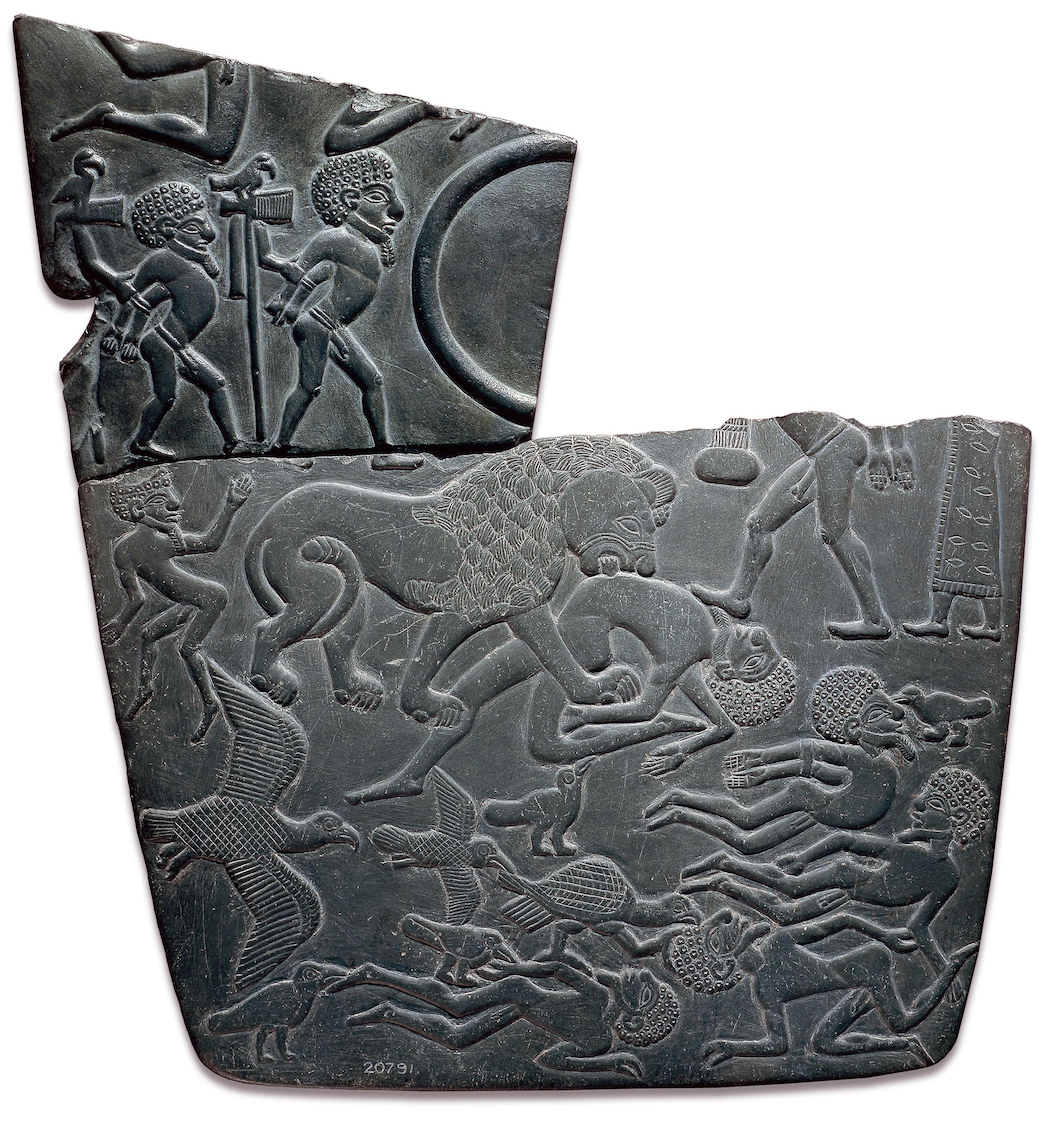
The Battlefield Palette , c. 3100 B.C.E., mudstone, found at el-Amarna, Egypt, 19.6 x 32.8 cm (© Trustees of the British Museum)
Already in the Predynastic period the king was linked with the virile wild bull, an association that continues throughout Egyptian history—one of the primary items of royal regalia was a bull tail, which appears on a huge number of pharaonic images. An early connection between the king and lions is also apparent. One scene on a Predynastic ceremonial palette ( The Battlefield Palette), shows the triumphant king as a massive lion devouring his defeated foes. First Dynasty kings appear to have kept lion cubs as pets.
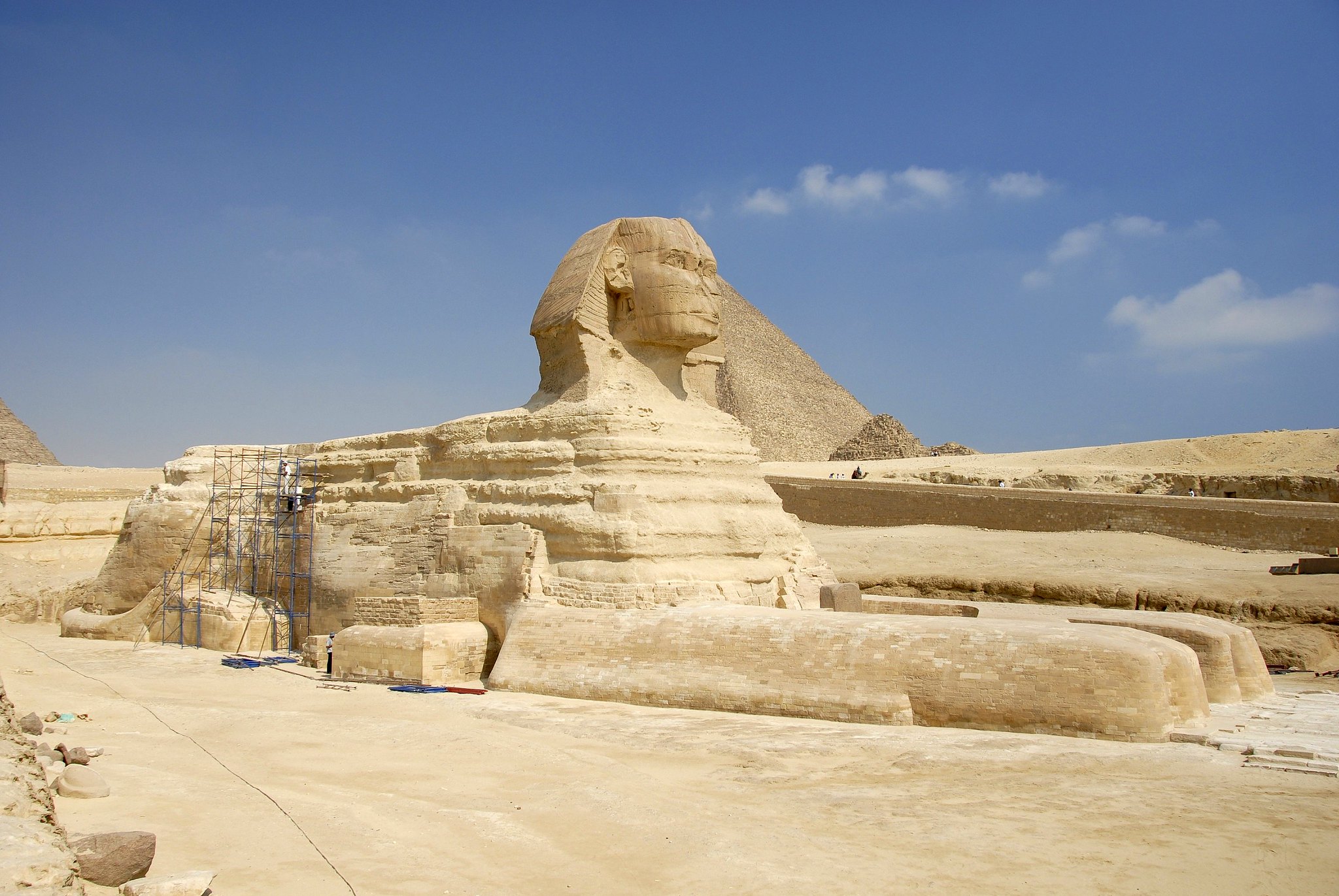
The Great Sphinx (photo: superblinkymac, CC BY-NC-ND 2.0)
In addition, lions (among other animals) were associated with the burials of some early rulers. One of the most iconic images from ancient Egypt is the massive Great Sphinx at Giza, which was sculpted from the living rock of the plateau. This fused form, with the body of a lion and the head of the king, became a common visual expression of royal power.
Historical Setting
While many of the religious and cultural characteristics of ancient Egypt were evident from very early on and continued all the way through the Roman era (contributing to overall cultural stability), sweeping conceptual developments and adoptions of external elements are also evident. Throughout ancient Egypt’s long history, periods of unified control were interspersed with moments of instability where parts of the country were controlled by different authorities. These repeated waves of political and cultural development create a decidedly complex history that spans thousands of years.
Read essays to understand the historical setting and basic characteristics of each era
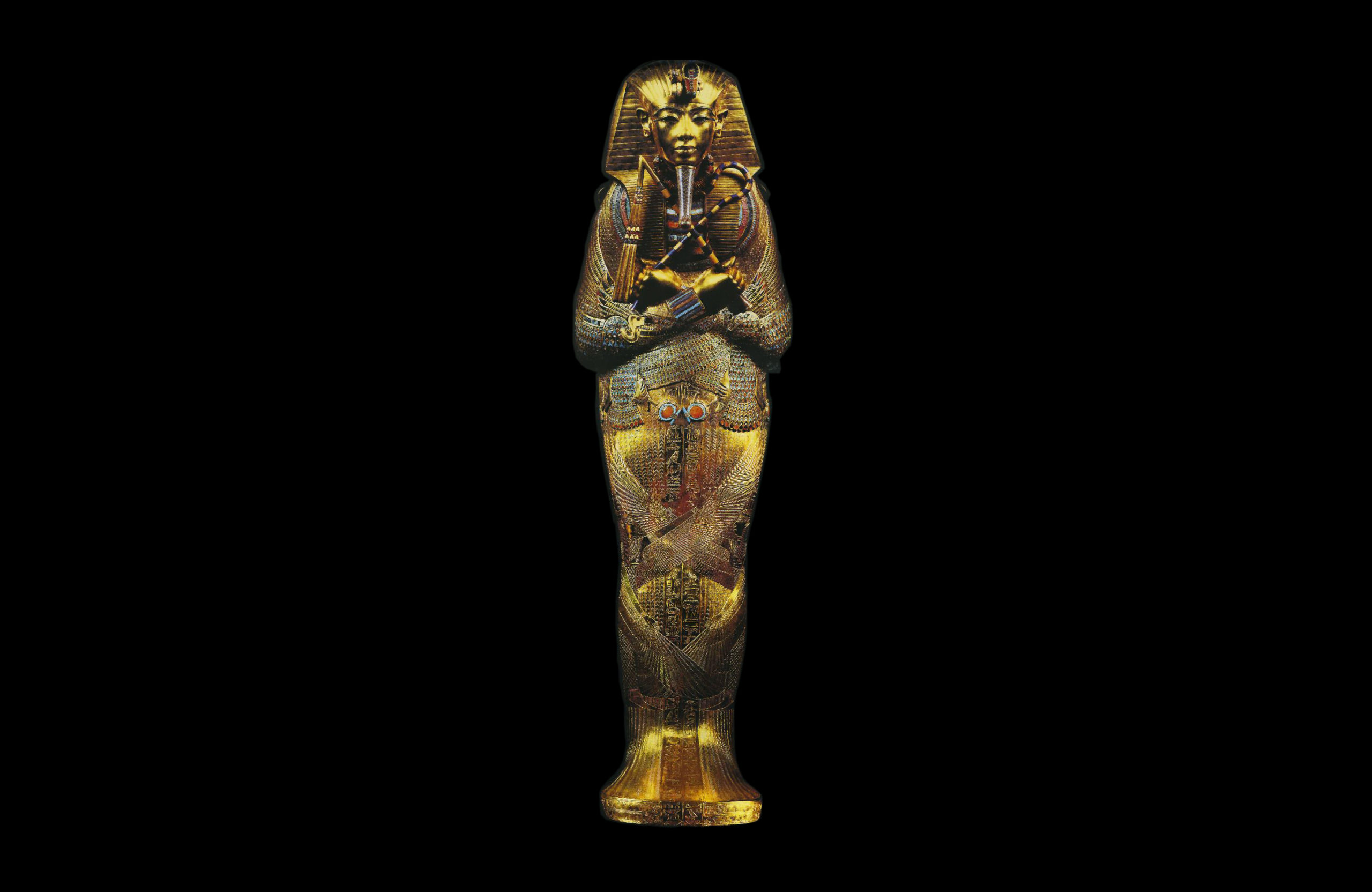
Ancient Egyptian chronology and historical framework: an introduction
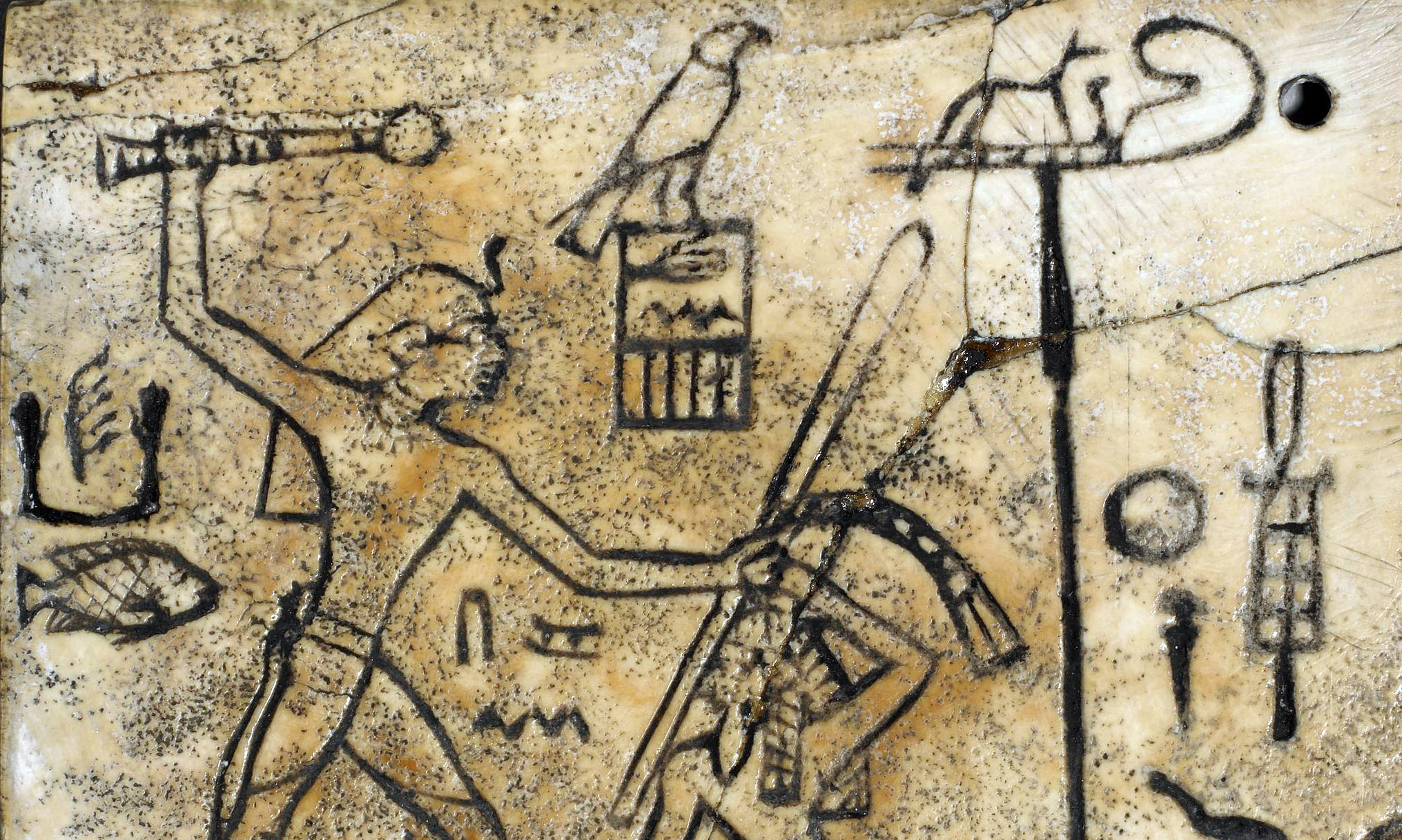
Predynastic and Early Dynastic: an introduction
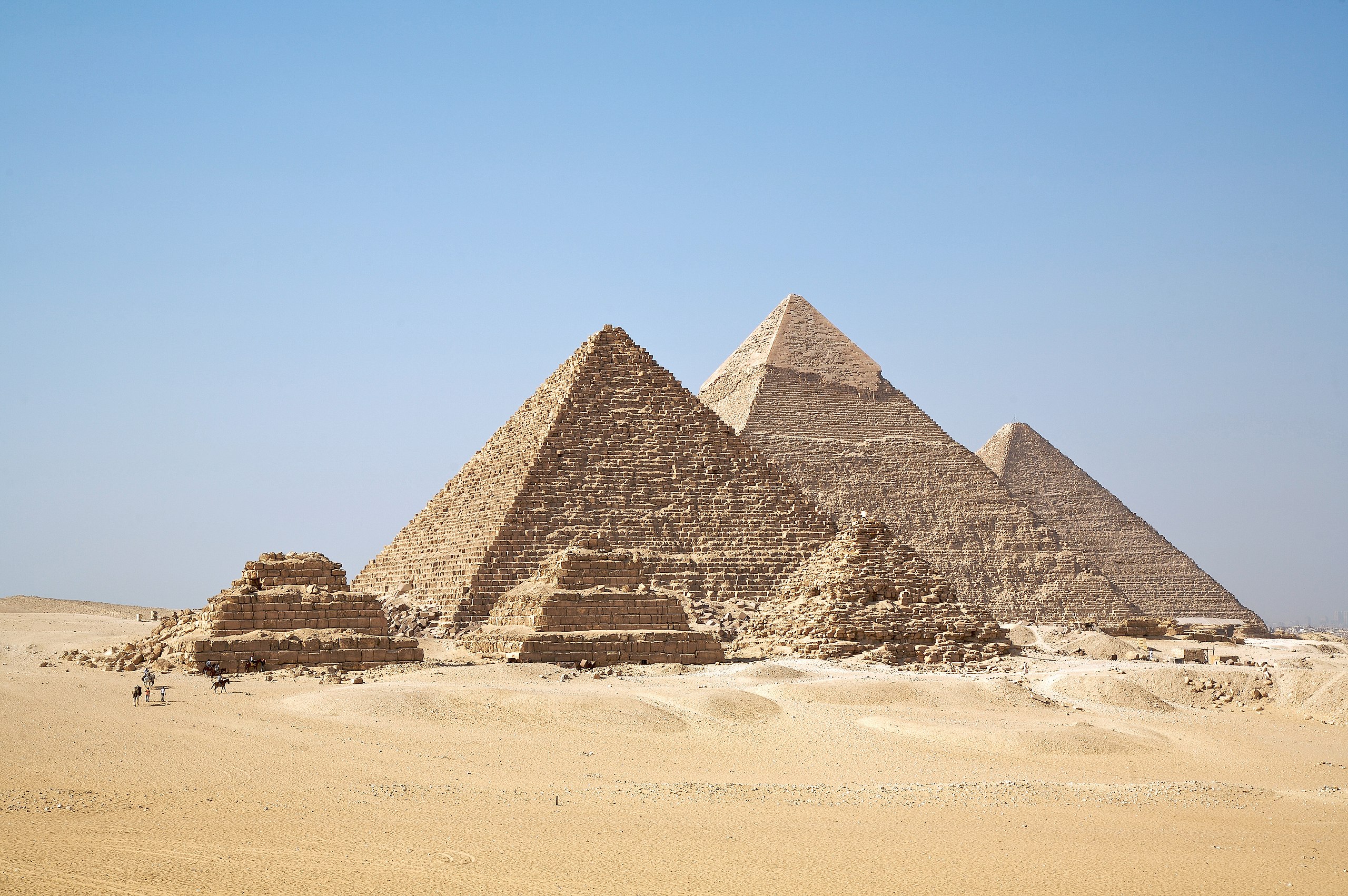
Old Kingdom and First Intermediate Period: an introduction
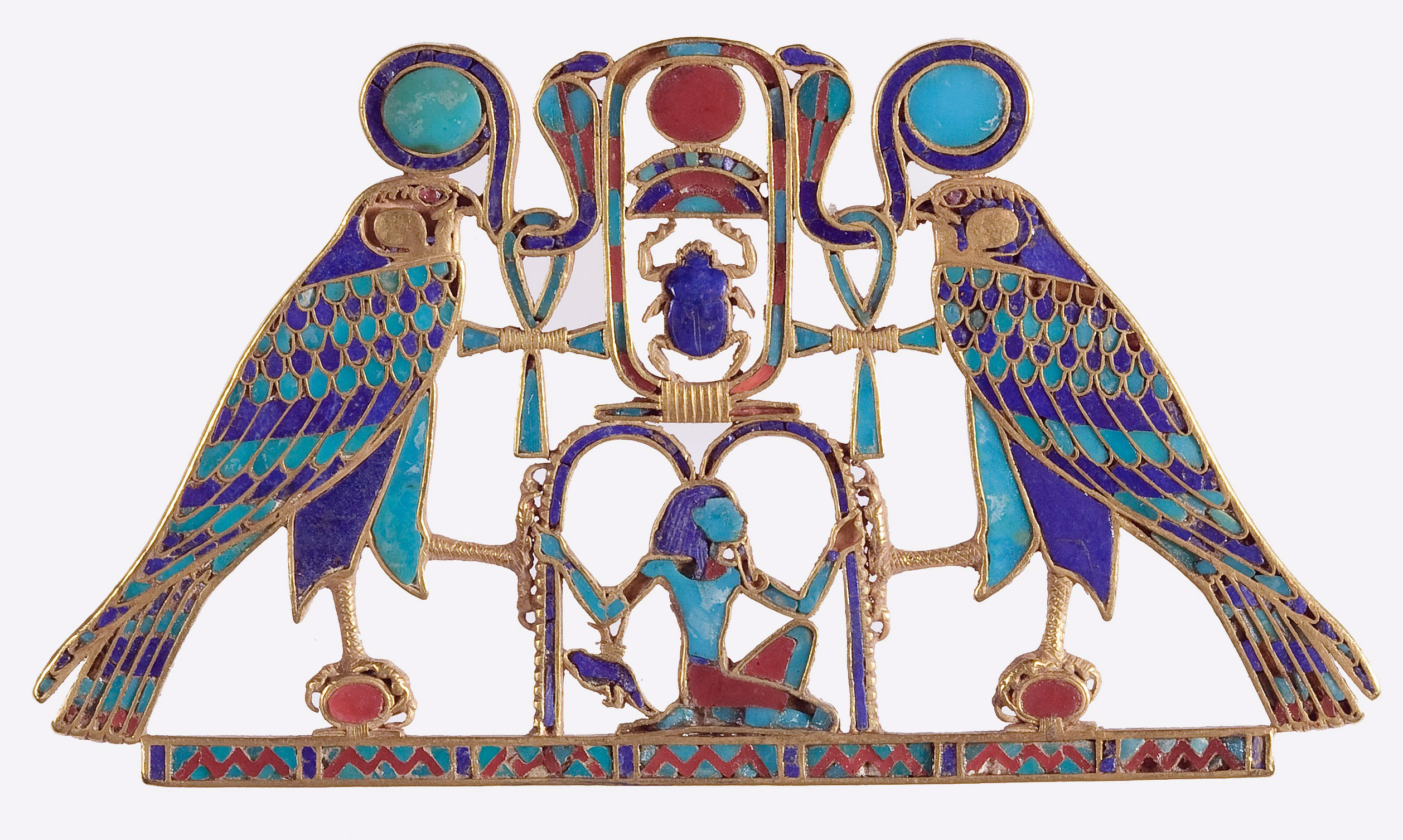
Middle Kingdom and Second Intermediate Period: an introduction
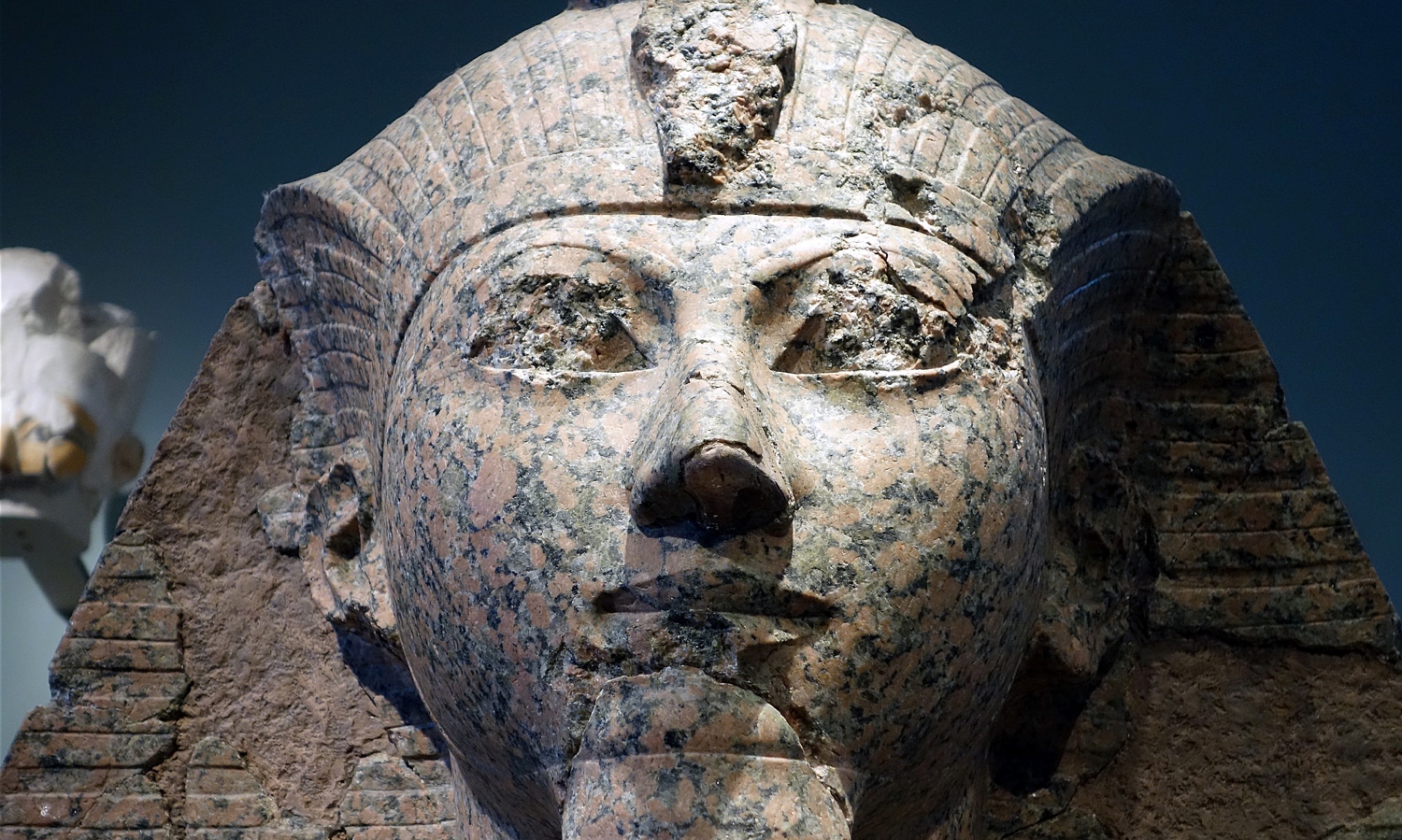
New Kingdom and Third Intermediate Period: an introduction
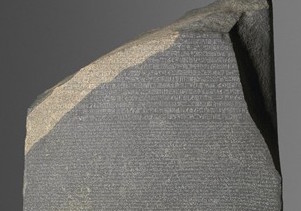
Late Period and the Ptolemaic and Roman Periods: an introduction
/ 6 Completed
Social Organization
Conceptually, the Egyptian state was an absolute monarchy where the office of pharaoh itself was considered divine. The pharaoh (king) was viewed as the earthly manifestation of the god Horus, and was responsible as the supreme commander for making all decisions affecting the nation. In reality, the king stood at the head of a hierarchical administrative structure with layers of civil officials that oversaw various systems and were responsible to the king for their success.
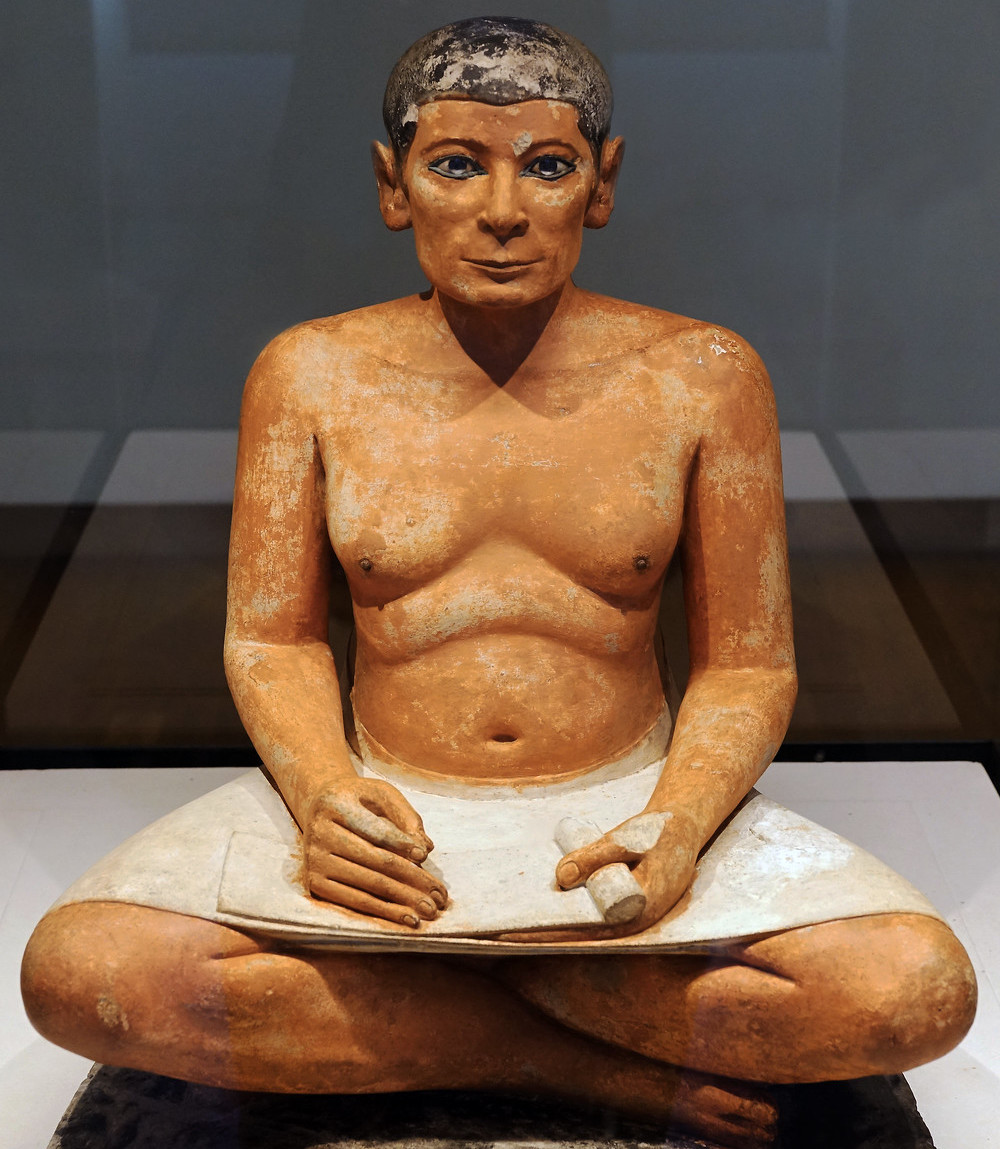
Seated Scribe , c. 2500 B.C.E., c. 4th Dynasty, Old Kingdom, painted limestone with rock crystal, magnesite, and copper/arsenic inlay for the eyes and wood for the nipples, found in Saqqara (photo: Steven Zucker, CC BY-NC-SA 2.0)
Most Egyptians followed the careers of their fathers and were taught by apprenticeship. Only the children of the higher classes, destined to become officials, were taught in schools and learned to read and write. Money in the modern sense did not exist in Egypt until the mid-fourth century B.C.E., so wages were usually paid in grain that could then be exchanged for copper or silver. Agriculture was the basis of the Egyptian economy and the foundation of the state, and produce was delivered to central storehouses to be administered and distributed.
Read essays about the various social strata in Egyptian society
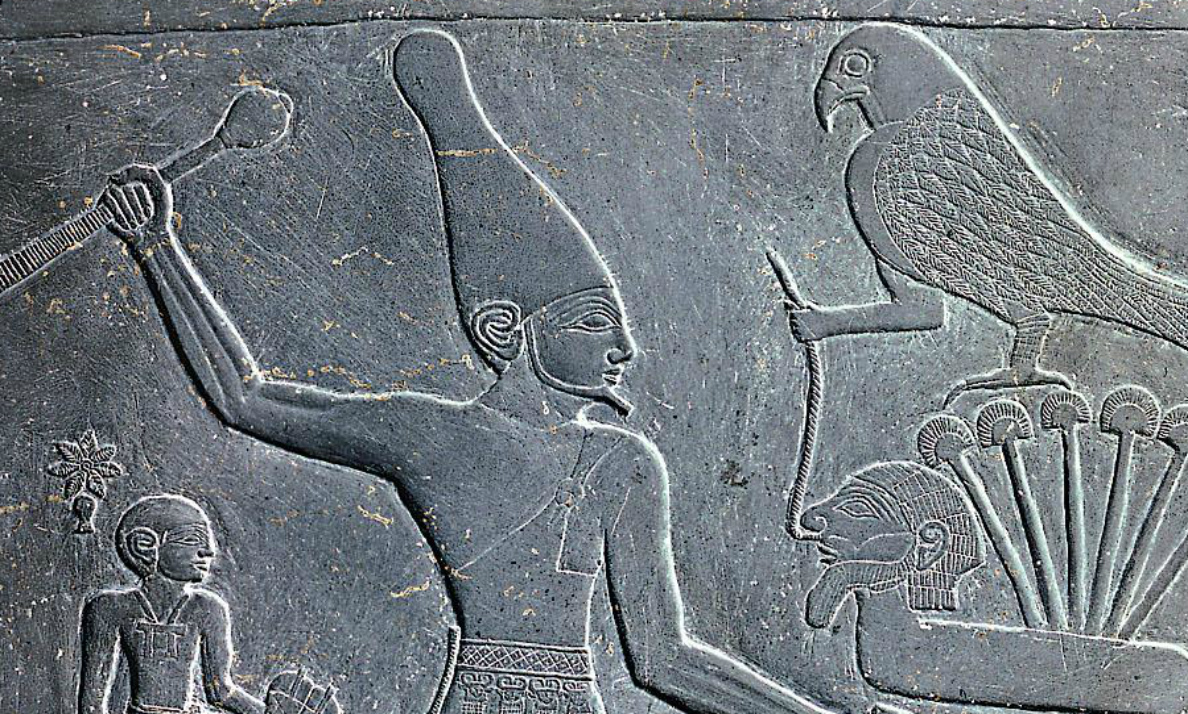
Egyptian Social Organization: The Pharaoh
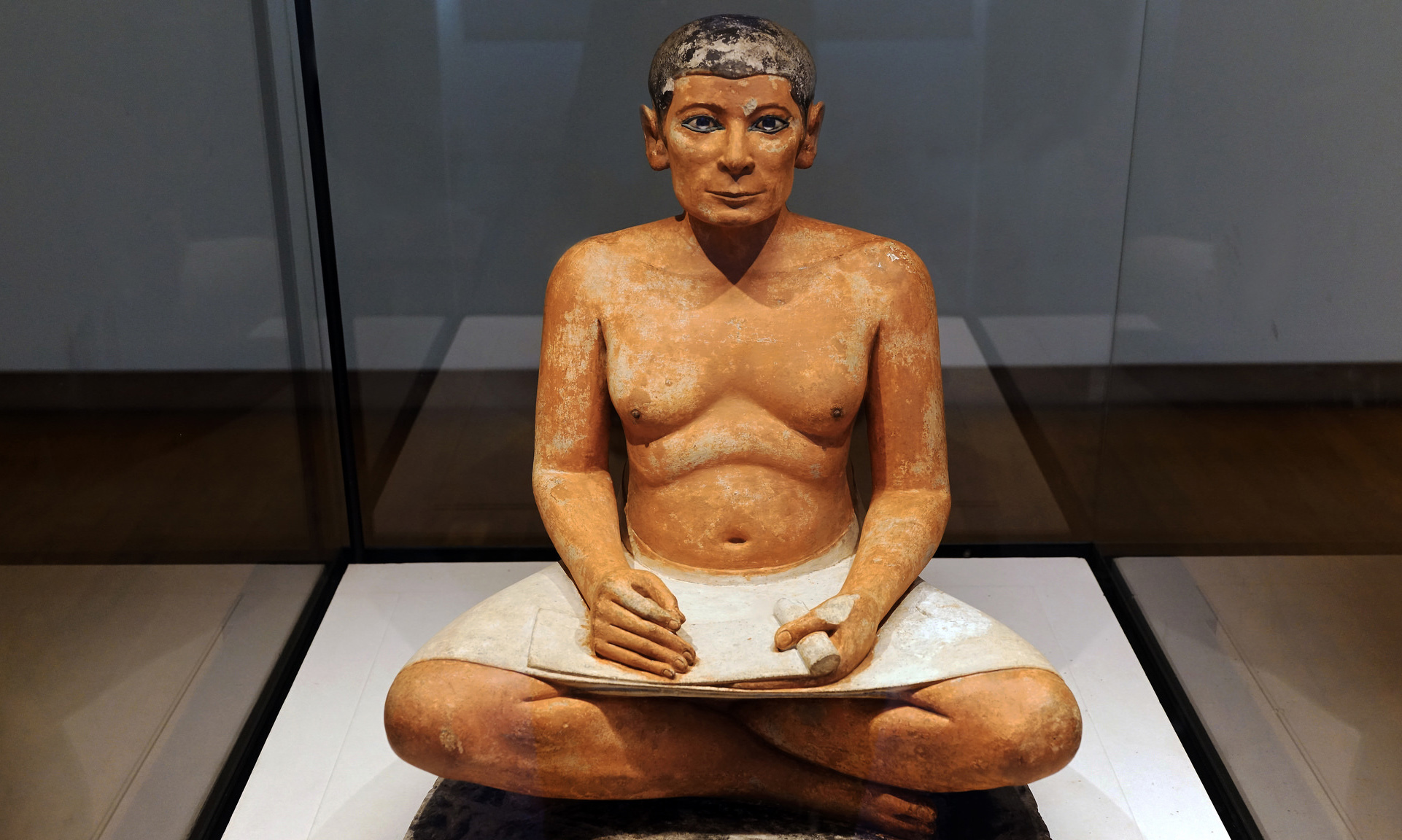
Egyptian Social Organization: Administrative officials, priests, ranks of the military, and the general population
/ 2 Completed
Art and Function
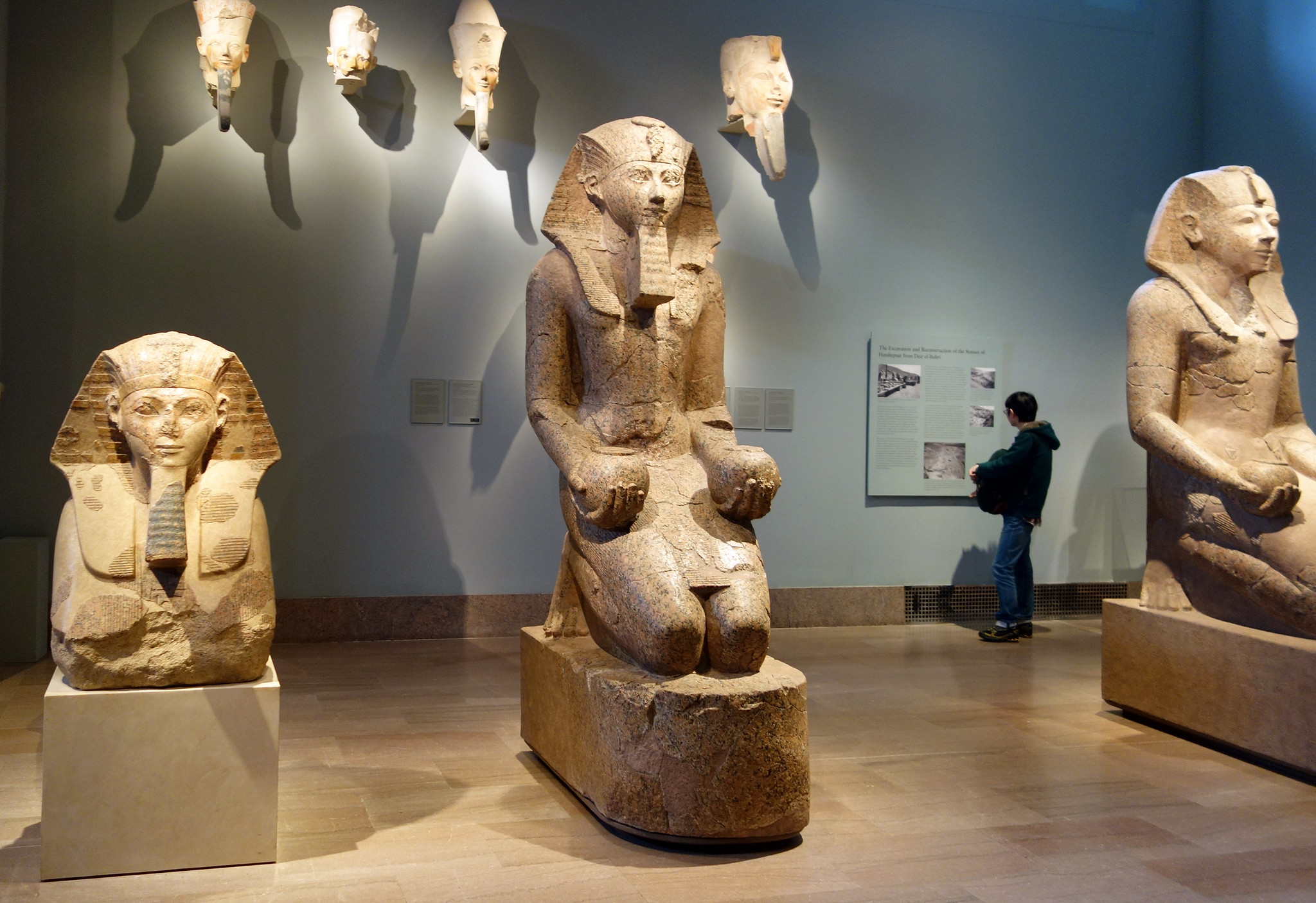
Large Kneeling Statue of Hatshepsut , c. 1479–1458 B.C.E., Dynasty 18, New Kingdom (Deir el-Bahri, Upper Egypt), granite, 261.5 x 80 x 137 cm (The Metropolitan Museum of Art)
Egyptian art is sometimes viewed as static and abstract when compared with the more naturalistic depictions of other cultures (ancient Greece for example). Much of Egyptian imagery—especially royal imagery—was governed by decorum (a sense of what was appropriate), and remained extraordinarily consistent throughout its long history. This is why their art may appear unchanging—and this was intentional. For the ancient Egyptians, consistency was a virtue and an expression of political stability, divine balance, and clear evidence of ma’at and the correctness of their culture. The Egyptians even had a tendency, especially after periods of disunion, towards archaism where the artistic style would revert to that of the earlier Old Kingdom which was perceived as a “golden age.”
Read essays about art and function
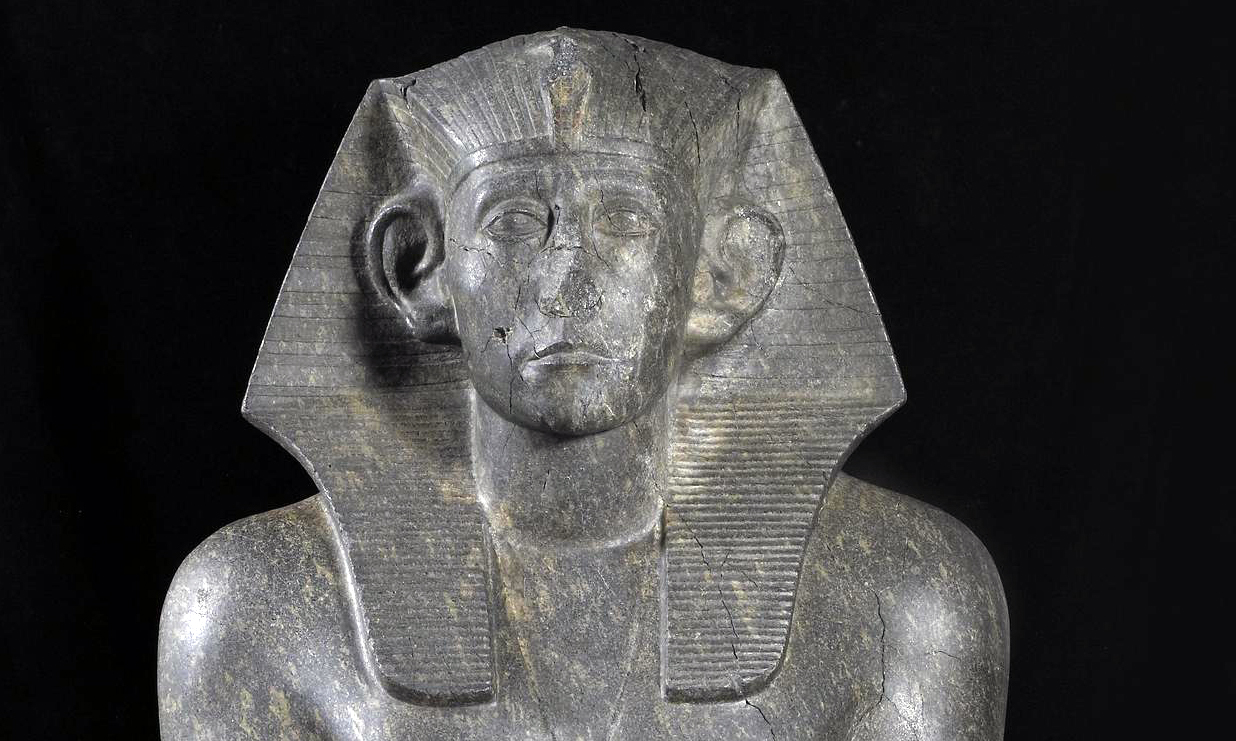
Ancient Egyptian art: an introduction its function and basic characteristics

Materials and techniques in ancient Egyptian art: an introduction
Consistency and balance
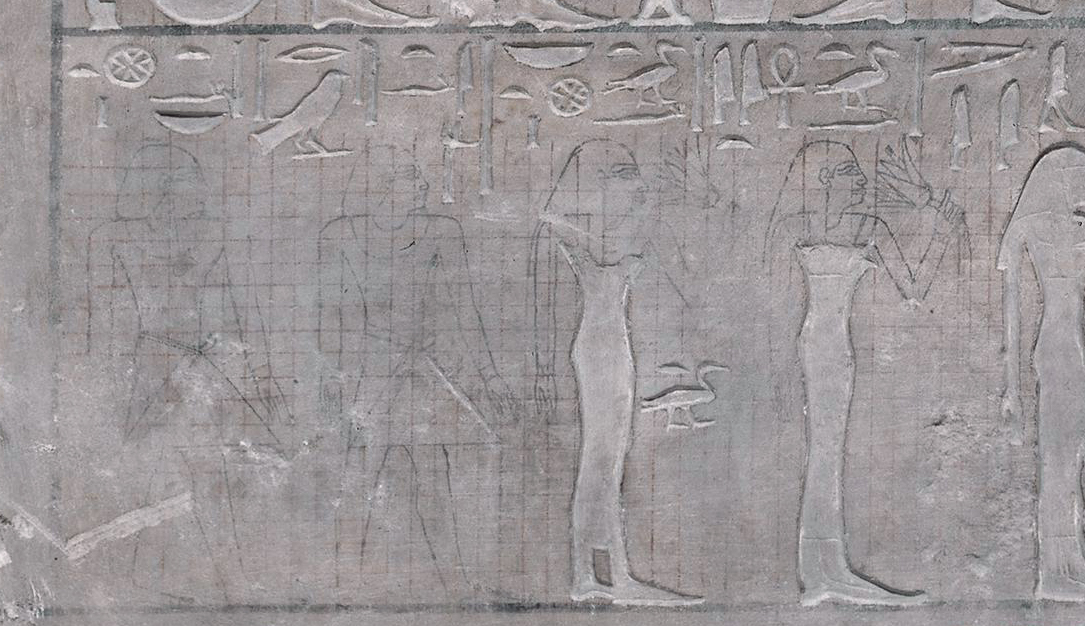
The canon of proportions grid is clearly visible in the lower, unfinished register of the Stela of Userwer, and the use of hieratic scale (where the most important figures are largest) is evident the second register that shows Userwer, his wife and his parents seated and at a larger scale than the figures offering before them. Detail of the stela of the sculptor Userwer, 12th dynasty, limestone, from Egypt, 52 x 48 cm wide (© Trustees of the British Museum)
Consistency in representation was closely related to a fundamental belief that depictions had an impact beyond the image itself. This belief led to an active resistance to changes in codified depictions. Even the way that figures were planned and laid out by the artists was codified. During the Old Kingdom, the Egyptians developed a grid system, referred to as the canon of proportions, for creating systematic figures with the same proportions. Grid lines aligned with the top of the head, top of the shoulder, waist, hips, knees, and bottom of the foot (among other body joints).
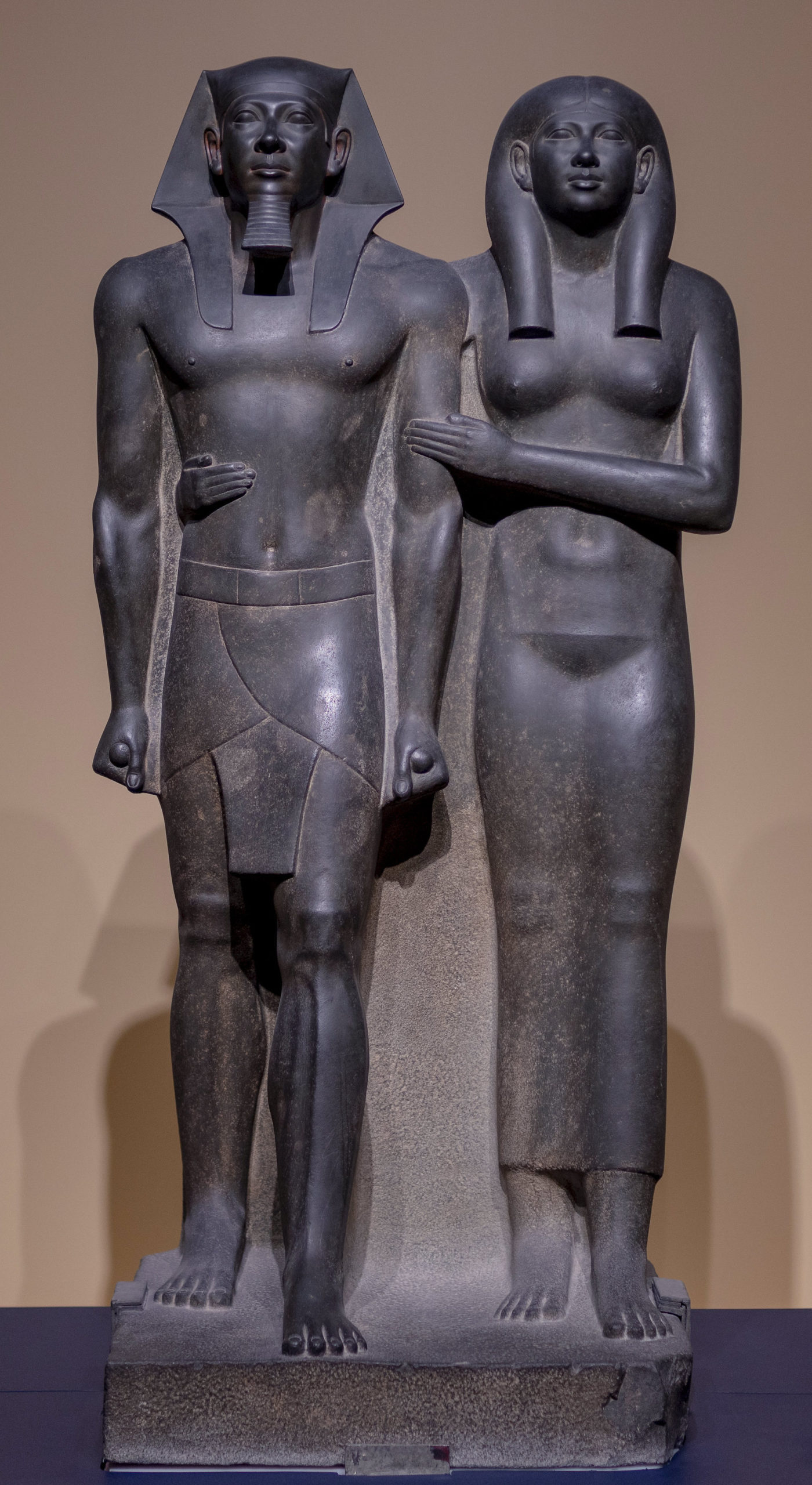
King Menkaura (Mycerinus) and Queen, 2490–2472 B.C.E., Old Kingdom, Dynasty 4, greywacke, Menkaura Valley Temple, Giza, Egypt, 142.2 x 57.1 x 55.2 cm, 676.8 kg (Museum of Fine Arts, Boston; photo: Steven Zucker, CC BY-NC-SA 2.0)
The grid aided the artist in ensuring that the proportions of their figures were correct, but those proportions shifted over time. For example, although 18 squares was the standard used for much of Egypt’s history, in the Amarna period 20 squares were used, resulting in figures with more elongated proportions.

Thutmose, Model Bust of Queen Nefertiti , c. 1340 BCE, limestone and plaster, New Kingdom, 18th dynasty, Amarna Period (Egyptian Museum and Papyrus Collection/Neues Museum, Berlin)
Below are several examples of Egyptian art that demonstrate their primary stylistic characteristics. These include:
- the use of hierarchical scale
- the use of registers
- use of the canon of proportions (described above)
- a preference for balance
- the integration of perspectives.
Read essays and watch videos about consistency and balance
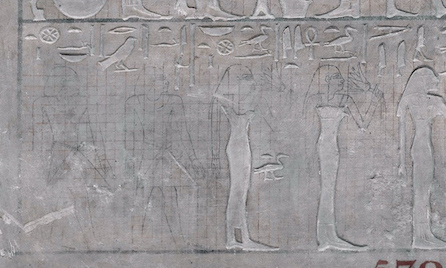
Stela of the sculptor Userwer: The lower part is still covered with the grid used for ensuring that the proportions of the figures were correct.
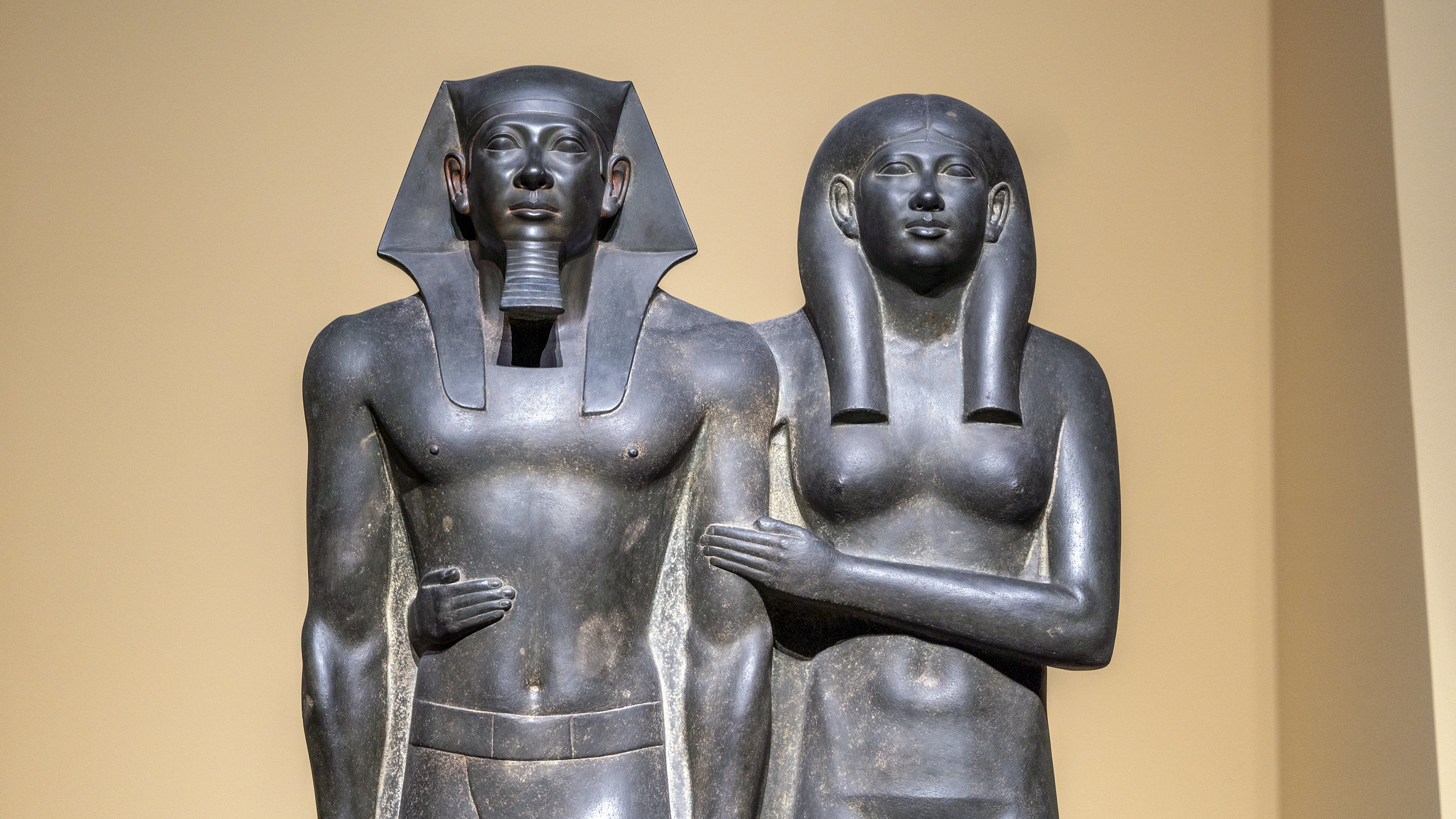
King Menkaure (Mycerinus) and queen: They both look beyond the present and into timeless eternity, their otherworldly visage displaying no human emotion whatsoever.

Thutmose, Model Bust of Queen Nefertiti : This stunning bust exemplifies a change in style.
The Seated Scribe: This painted statue differs from the ideal statues of pharaohs.
/ 4 Completed
Creative details
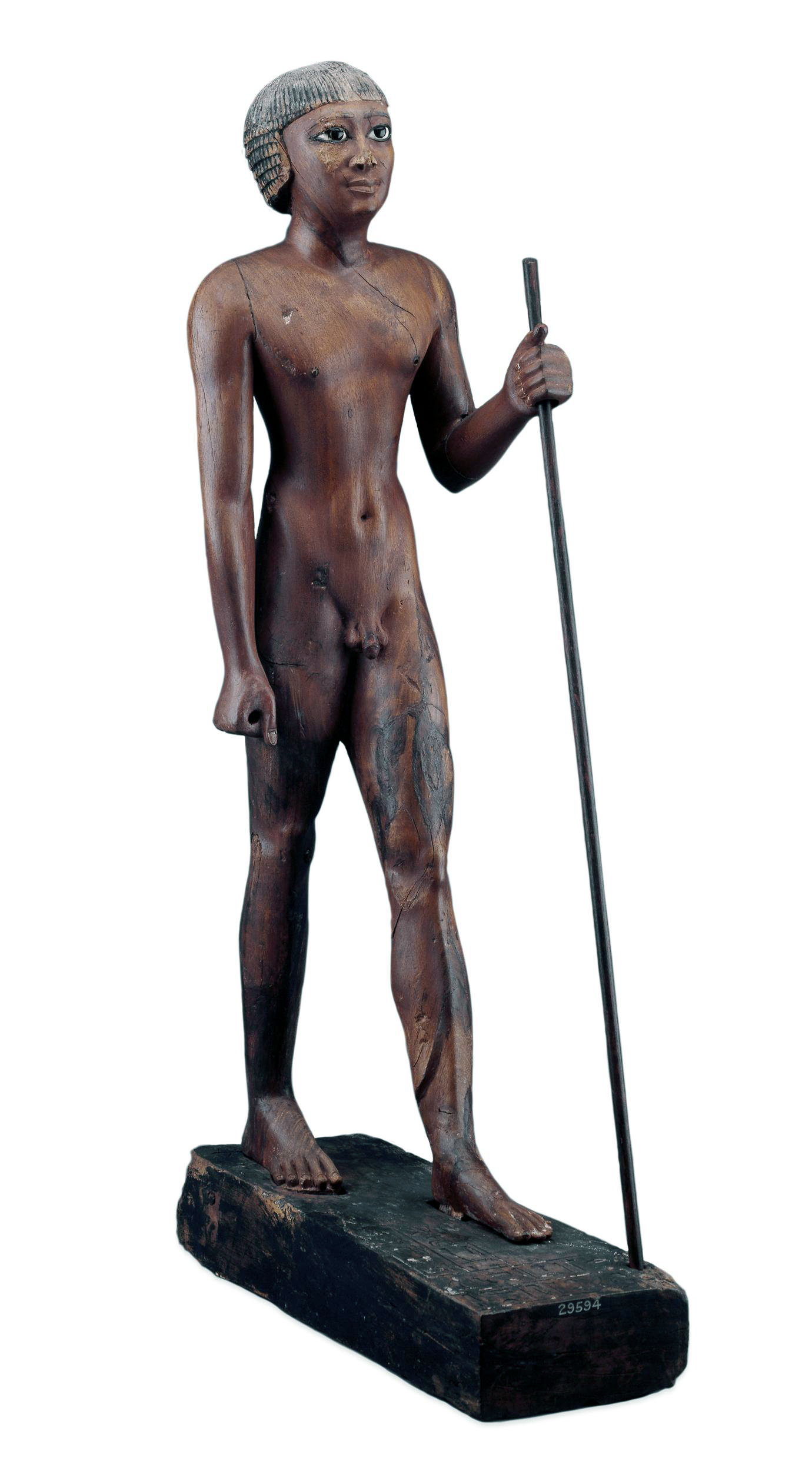
Nude figure of the Seal Bearer Tjetji, 2321 B.C.E.–2184 B.C.E. (6th Dynasty), from Akhmim, Upper Egypt, wood, obsidian, limestone, and copper, 75 cm high (© Trustees of the British Museum)
Although much Egyptian art is formal, many surviving examples of highly expressive depictions full of creative details prove that the ancient Egyptian artists were fully capable of naturalistic representations. Note, for example, the sensitive modeling of the musculature and close attention paid to realistic physical detail evident in a wood statue of a high official (the Seal Bearer Tjetji) from a Late Old Kingdom tomb. These very unusual and enigmatic statuettes of nude high officials, which are depicted in a standard pose of striding forward with left leg advanced and holding a long staff, were often painted and had eyes of inlaid stone set in copper.
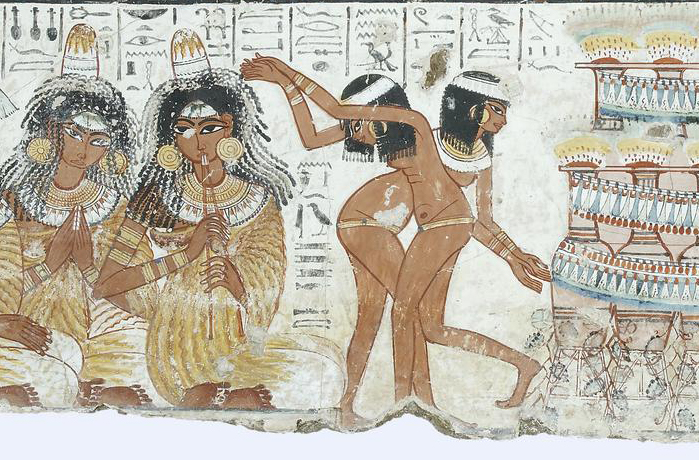
Musicians and dancers (detail), A feast for Nebamun, Tomb-chapel of Nebamun, c. 1350 B.C.E., 18th Dynasty, paint on plaster, whole fragment: 88 x 119 cm, Thebes © Trustees of the British Museum
Nebamun’s tomb, with its spectacular paintings, includes several examples that demonstrate a careful observation of the natural world—especially notable in the energetic hunting cat and the sinuous dancing of the entertainers at the banquet. A marvelous wooden head of Queen Tiye presents a woman of strong personality with details that hint at her formidable character.
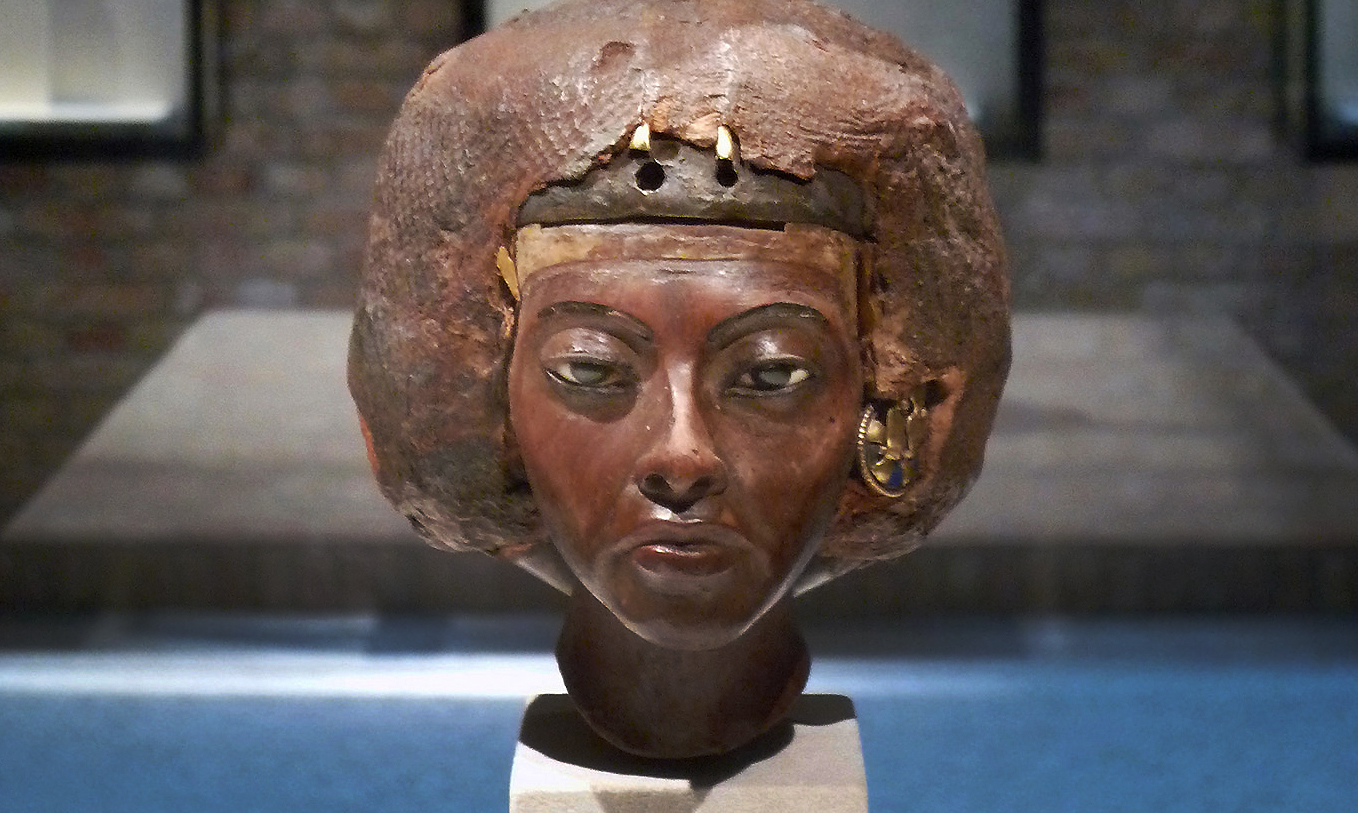
Portrait Head of Queen Tiye with a Crown of Two Feathers , c. 1355 B.C.E., Amarna Period, Dynasty 18, New Kingdom, Egypt, yew wood, lapis lazuli, silver, gold, faience, 22.5 cm high (Egyptian Museum and Papyrus Collection at the Neues Museum, Berlin)
Read essays about creative details
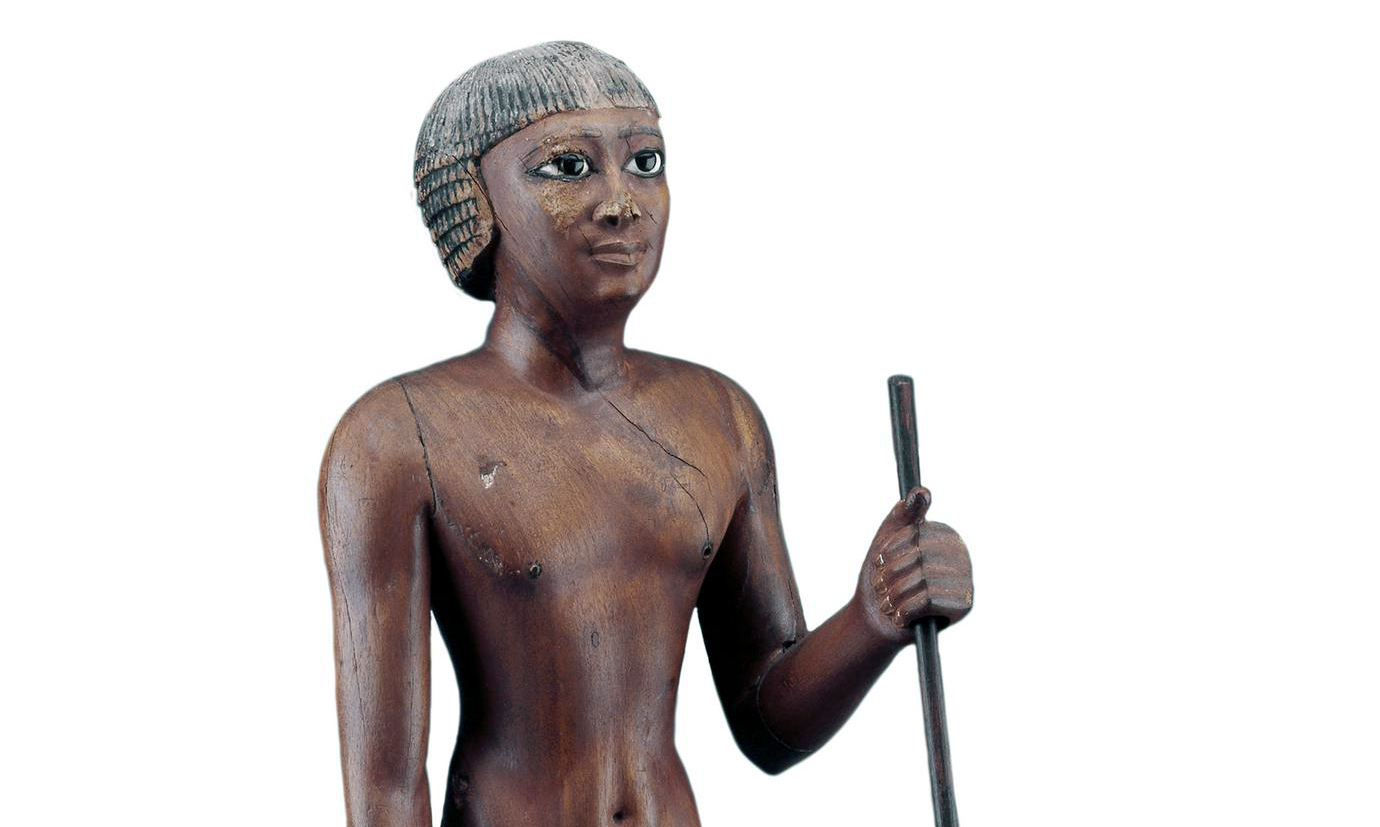
Wooden tomb statue of Tjeti: T he sculptor of this example has carefully modeled the muscles on the torso and legs, and paid close attention to the detail of the face.
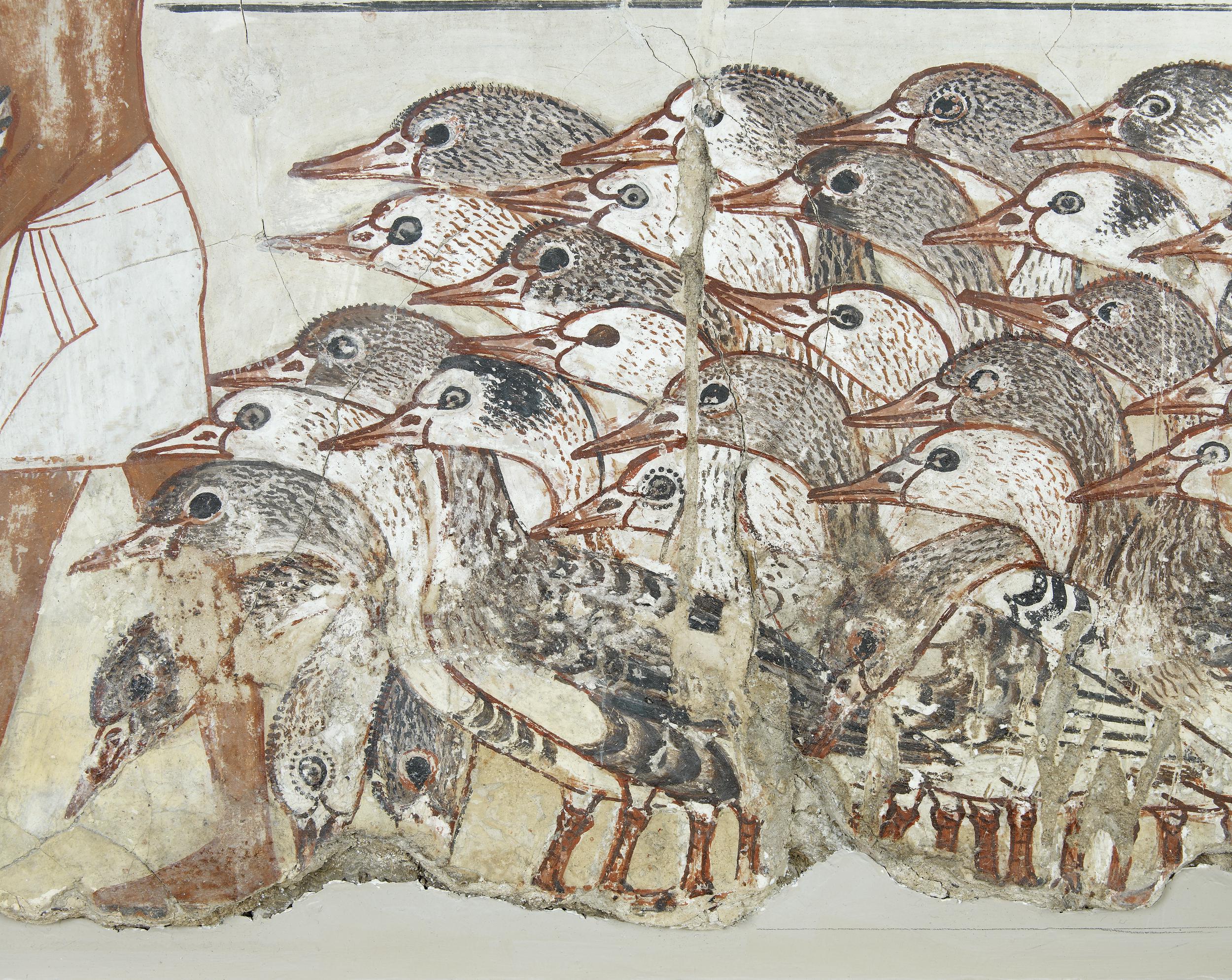
Paintings from the Tomb-chapel of Nebamun: He is shown hunting birds from a small boat in the marshes of the Nile with his wife Hatshepsut and their young daughter.
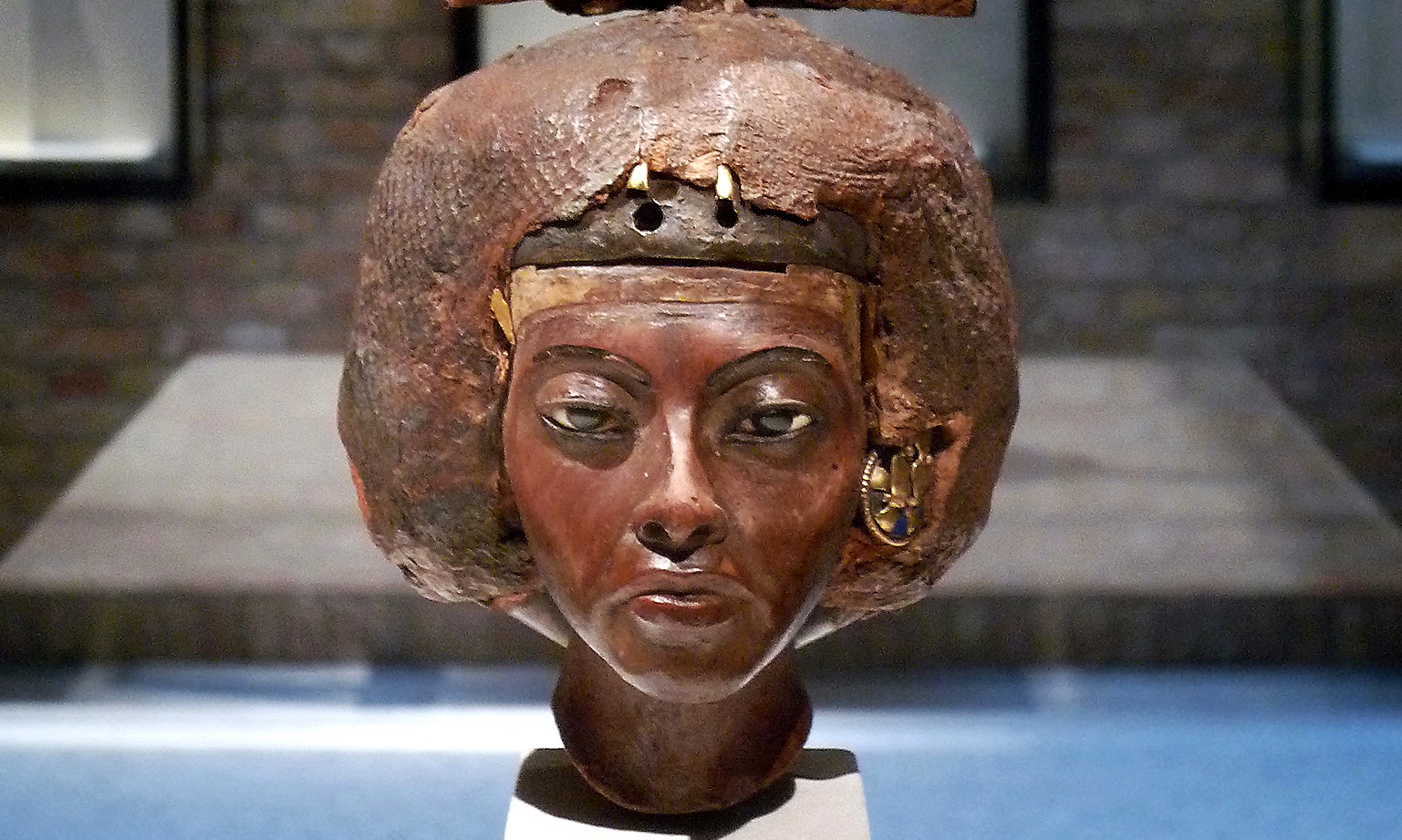
Portrait Head of Queen Tiye: She was a powerful figure, but her royal life was complicated, as demonstrated through this changing statue.
/ 3 Completed
Metalworking Traditions
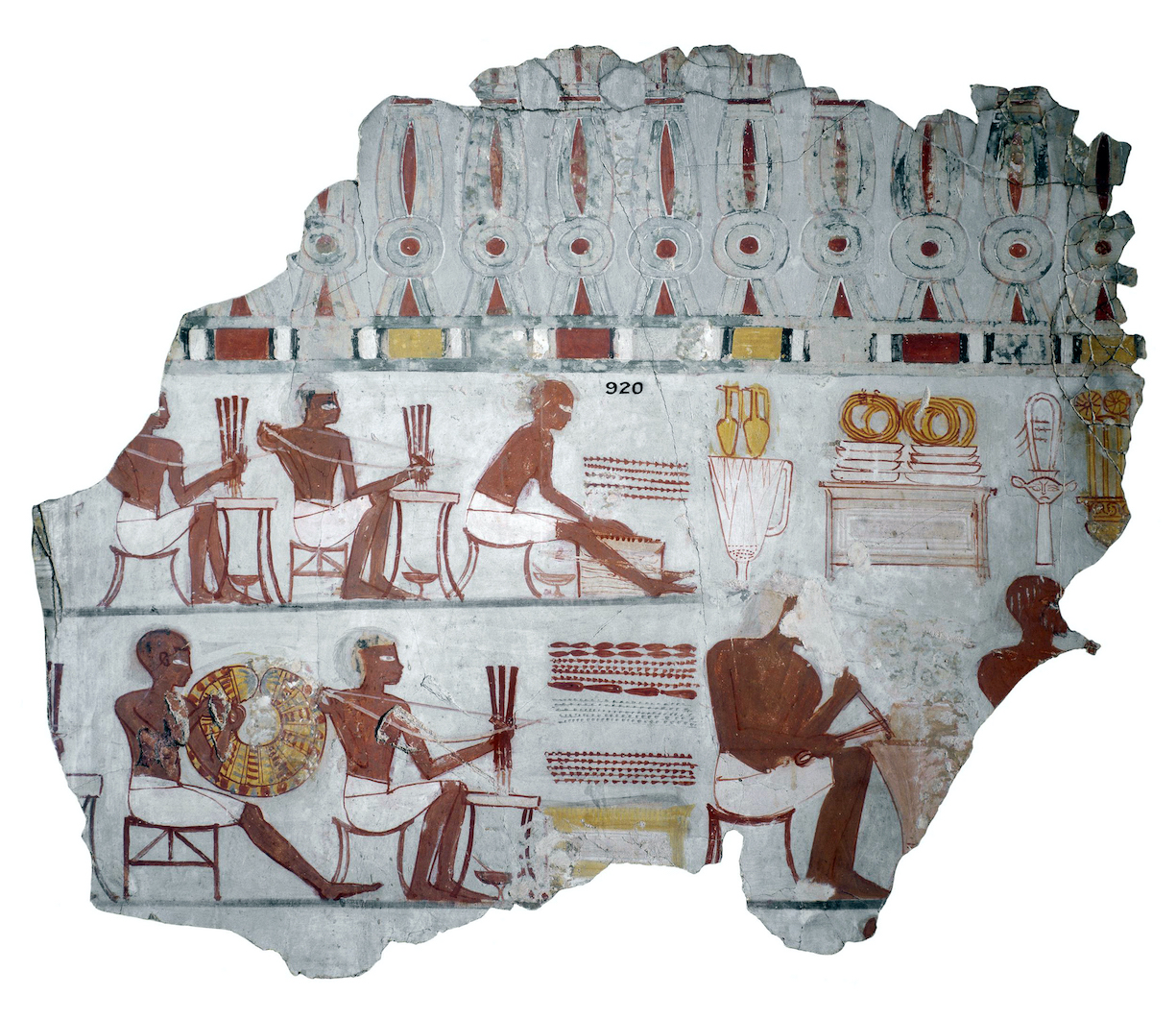
Scene showing the manufacture of valuable items, such as jewelry. Wall-painting, probably from the tomb of Sobekhotep, Thebes, c. 1400 B.C.E., New Kingdom, reign of Thutmose IV, painted stucco, 60 x 58.5 (© Trustees of the British Museum)
Egyptian artisans were highly skilled metalworkers from early times; although few metal sculptures have survived, those that are preserved show an incredible level of technical achievement. As with other types of craft, like woodworking, preserved images of artisans in their workshops found in private tombs provide information about the processes of production For instance, we can see a group of jewelers at work in a painting from the tomb of Sebekhotep.

Pectoral and Necklace of Sithathoryunet with the Name of Senwosret II, Middle Kingdom, Dynasty 12, reign of Senwosret II, c. 1887–1878 B.C.E., Egypt, Fayum Entrance Area, el-Lahun (Illahun, Kahun; Ptolemais Hormos), Tomb of Sithathoryunet (BSA Tomb 8), EES 1914, Gold, carnelian, feldspar, garnet, turquoise, lapis lazuli
The most beautifully crafted pieces of jewelry display elegant designs, incredible intricacy, and astonishingly precise stone-cutting and inlay, reaching a level that modern jewelers would be hard-pressed to achieve. The jewelry of a Middle Kingdom princess, found in her tomb at el-Lahun in the Fayum region is one spectacular example.
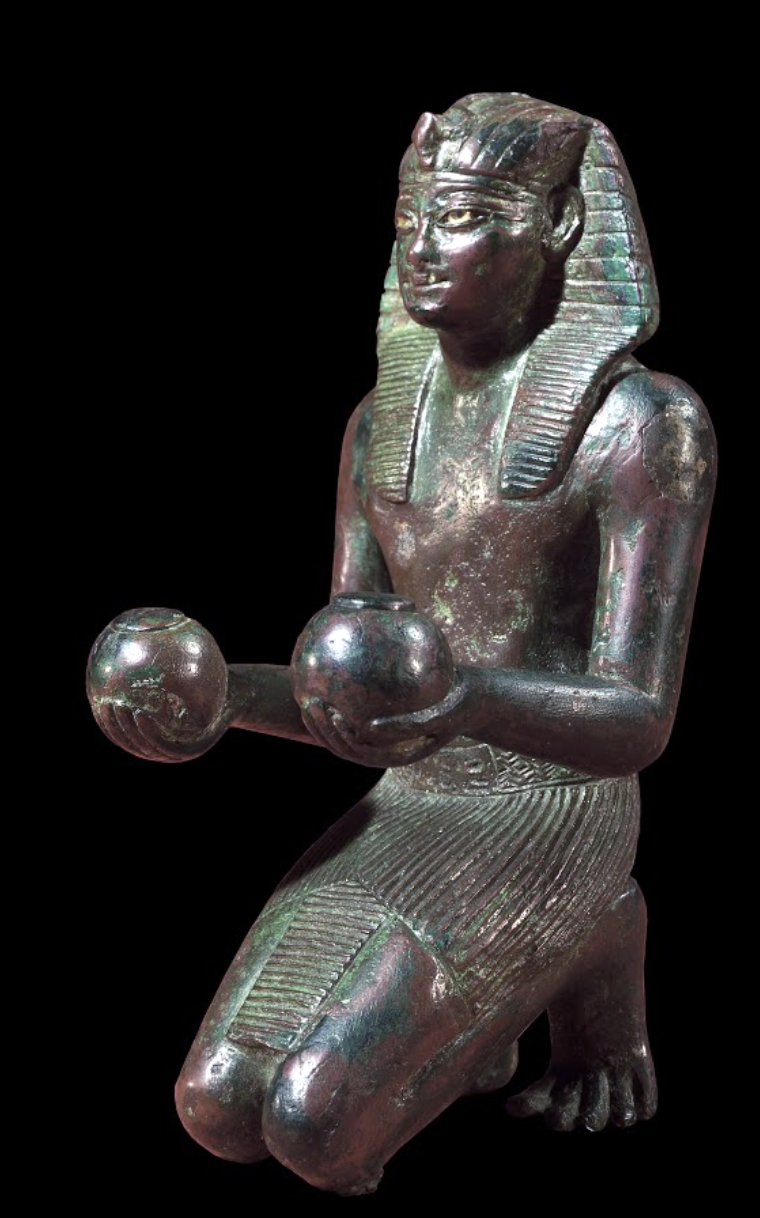
Statuette of Thutmose IV, 1400–1390 B.C.E., 19th Dynasty, ancient Egypt, bronze, silver, calcite, 14.7 x 6.4 cm (© Trustees of the British Museum)
The metal statues that survive demonstrate a high level of skill in both sheet working/metal forming and casting in copper and bronze. This marvelous hollow-cast bronze statuette of a kneeling Thutmosis IV, presenting an offering of wine, provides a peek into the abilities of Egypt’s craftsmen. Note that the arms were created separately and joined to the body on tenons and the eyes were originally inlaid.

Read essays and watch a video about metalworking traditions

Paintings from the tomb of Sebekhotep: Images show jewelers at work.
Pectoral and necklace of Sithathoryunet: Fashioned delicately in gold, carnelian, feldspar, garnet, turquoise, and lapis lazuli.
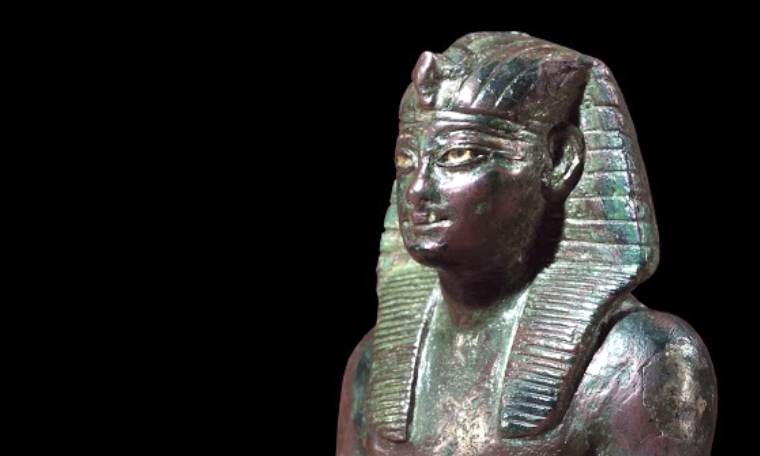
Bronze statuette of Thutmose IV: Very few metal statues survive that date from before the Late Period, though the Egyptians did have the technology to make large copper statues as early as the Old Kingdom.
This brief glimpse at the world of ancient Egypt is just a springboard for gaining an understanding of this compelling and complex culture.
A final note
The wonder of the internet is the astonishing access to information; one of the big problems with the internet is that anyone, regardless of knowledge or training, can post whatever they like and that information is presented at the same level as content put out by the experienced and trained. Information about ancient Egypt should always come from a well-vetted source, as there is a great deal of misinformation. The culture is astonishing enough on its own. Egypt remains highly influential across different areas of culture and vast swaths of time and space—Egyptian glass beads have been excavated in Viking tombs and revivals of Egyptian style still happen on an almost cyclical basis, even millenia later. We are surrounded by Egyptian imagery and concepts even if we don’t realize it; those emojis we use with such abandon are decidedly hieroglyphic. The more we know about what came before, the better we can grasp everything that has happened since. Only by understanding the past can we really envision the possibilities of the present and plan for the future.
Key questions to guide your reading
How did the annual flooding of the nile help form the egyptian view of the world, how might the regular behavior of certain animals—like falcons, vultures, snakes, and scarab beetles— suggest "heavenly wisdom" to the careful observer, how would you want to be depicted for eternity what identifying symbols would you want to include, terms to know and use.
canon of proportions
hierarchical scale
Need teaching images? Here is a Google Slideshow with many of the primary images in this chapter
Read a chapter about Ancient Egyptian religious life and afterlife
Collaborators
Dr. Amy Calvert
Dr. Beth Harris
Dr. Steven Zucker
The British Museum
The Metropolitan Museum of Art
Your donations help make art history free and accessible to everyone!
Ancient Egypt 101
The ancient Egyptian civilization, famous for its pyramids, pharaohs, mummies, and tombs, flourished for thousands of years. But what was its lasting impact? Watch the video below to learn how ancient Egypt contributed to modern-day society with its many cultural developments, particularly in language and mathematics.
Anthropology, Archaeology, Social Studies, Ancient Civilizations
Idea for Use in the Classroom
The world of ancient Egypt is different from students’ contemporary lives in many respects. The Ancient Egypt 101 video (above) is an ideal place to start them on their exploration of that civilization . Before they watch the video, have student volunteers to share any information they already know about ancient Egypt . Ask: What do you know about the pyramids ? Are you familiar with any Egyptian pharaohs ? After watching the video once, as a whole class, watch it a second time, section by section, and make a list of topics reflecting the major themes of the video. Discuss how students’ prior knowledge fits into this schema. Your class list may look something like this:
- Development into an empire
- Important leaders and their roles
- Religious beliefs
- Practices related to religious beliefs
- STEM innovations and their uses
- Writing system innovations and their uses
- How the empire ended
For each topic, discuss how thorough students feel their knowledge is after the video. Divide the class into three groups to brainstorm ancient Egyptian topics they would like to know more about. Ask: What are some topics that the video did not cover, or covered only a little? For example, the students may note that they would like to know about ancient Egyptian economics, relationships with neighboring states, social structures, or the arts beyond pyramids and tombs. Have each group record the results of their brainstorming in a list. After each group presents its list to the class, have each student use the discussion to generate a research question to explore during the study of ancient Egypt.
Media Credits
The audio, illustrations, photos, and videos are credited beneath the media asset, except for promotional images, which generally link to another page that contains the media credit. The Rights Holder for media is the person or group credited.
Production Managers
Program specialists, last updated.
October 19, 2023
User Permissions
For information on user permissions, please read our Terms of Service. If you have questions about how to cite anything on our website in your project or classroom presentation, please contact your teacher. They will best know the preferred format. When you reach out to them, you will need the page title, URL, and the date you accessed the resource.
If a media asset is downloadable, a download button appears in the corner of the media viewer. If no button appears, you cannot download or save the media.
Text on this page is printable and can be used according to our Terms of Service .
Interactives
Any interactives on this page can only be played while you are visiting our website. You cannot download interactives.
Related Resources

Essay on Egyptian Civilization
Periods of Egyptian civilization
The Egyptian civilization is not only viewed as one of the oldest civilizations, but also as one of the most durable ones. It is traditionally divided into the following major periods:
1) Pre-Dynastic period (Prior to 3100 BC). During this period 42 territorial and political unities were formed. As a result of political, economic and military cooperation, they were merged creating the two major political formations: Upper Egypt (south) and Lower Egypt (north). Those, in turn, become part of a single Egyptian state. 2) Early Dynastic Period (1st–2nd Dynasties). Ancient Egyptian pharaoh Menes, the founder of the 1st Dynasty united Egypt in a whole. The integrity of the country was strengthened by establishing a centralized irrigation system and an administrative apparatus of the invention and spread of hieroglyphic writing. 3) Period of the Old Kingdom (3rd–6th Dynasties). Egypt is considered to be a powerful state based on economic and political factors. Economic prosperity and political stability have made possible the improvement of the irrigation system, as well as the construction of the pyramids such as Khufu, Khafre and Menkaure – symbols of Egyptian civilization. 4) The first transitional period (VII-X Dynasties). This is a time of the internal strife and the collapse of the centralized state. The city of Thebes became one of the major centers that played a huge role in Ancient Egypt. 5) Period of the Middle Kingdom (XI-XIII Dynasties). The country was reunited, and the power of the prefecture leaders was limited. Egypt increased its territory, particularly in the south. In addition to this, it launched glass manufacturing and started a proliferation of tools made of bronze. 6) The second transitional period (XIV-XVII Dynasties). Egyptian states collapsed due to the invasion of the Hyksos – nomadic tribes of Semitic origin, invaded from Asia and conquered the northern and central parts of the country. The rulers of Thebes led national liberation struggles that ended the expulsion of the Hyksos. As a result, “the Hyksos attacked Egypt and occupied the Egyptian lands. Yet, the princes of Thebes, led by Ahmos I, managed to expel them out of Egypt” (“Pharaonic Era,” 2009, para. 9). 7) Period of the New Kingdom (XVIII-XX Dynasties). The era of the heyday of Egyptian civilization. Egypt expanded its ownership to the Euphrates in the east and the third cataract of the Nile in the south. Pharaohs put more effort to keep their land in the fight against the Hittite Empire, and later with the Sea Peoples. 8) Late Period (XXI-XXVI Dynasties). The time of strife, invasions and alien dominations: Libyan, Nubian, Assyrian. During this period, Egypt survived its last ascent. 9) The period of Persian rule (XXVII Dynasties). The Persian Empire conquered Egypt, but the increase in the tax oppression and abuse led to the Persians, the Egyptians revolted and liberated the country. 10) The last period of the independence of Egypt (XXVIII-XXX Dynasties). The union reduced to the internal strife that caused the weakening of the state and the restoration of Persian influence. 11) The period of the Persian, Greek, Roman and Byzantine domination (342 BC. – 646 BC.). In 332 BC, Persians were driven out by Alexander the Great. After the collapse of the empire Alexander the Great in Egypt established the Hellenistic Ptolemaic dynasty, which lasted until the time of the Roman conquest.
However, “the end of the Old Kingdom was not the end of Egyptian civilization…The calamity triggered by low Nile floods was the impetus to radical social changes and a reformulation of the notion of kingship. The legacy of this period is still with us today” (Hassan, 2011, para. 20).
Hence, as we can see Ancient Egypt started with the primary association of tribes in the valley of the River Nile in 3150 BC and ended around 31 BC, when the Roman Empire conquered Egypt. The latter event is not the first period of foreign Dominion, but the arrival of the Romans marked significant changes in the cultural and religious life of Egypt, as well as the termination of Egypt as a unified civilization. Ancient Egypt developed over three and a half thousand years. It all started with the primary association of tribes in the valley of the River Nile in 3150 BC and ended around 31 BC, when the Roman Empire conquered Egypt. The latter event is not the first period of foreign reign, but the arrival of the Romans marked the significant changes in the cultural and religious life of Egypt, as well as the termination of Egypt as a unified civilization.
The significance of the Nile River
The basis of the existence of ancient Egypt was a constant control of balance of natural and human resources , which primarily meant control over the irrigation of the fertile valley of the Nile , the use of minerals occurring in the valley and surrounding desert regions, the development of independent systems of writing and literature, the organization of collective projects, trade with neighbors in eastern and central Africa and the eastern Mediterranean, and, finally, military campaigns, which demonstrated the strength and power of the empire, as well as the territorial advantage over neighboring cultures at different periods of time. Those actions were organized and motivated by socio-political and economic elite that reached a social consensus through a system of religious means. For administrative purposes, Egypt was divided into different districts. Starting from the pre-dynastic period (3100 BC) ‘noma’ represented an individual city. In the days of the Pharaohs a whole country was divided into 42 nomes.
In Egypt, different taxes were paid according to the type of activity. The vizier controlled revenues from the people in the budget and plans for the collection. The householders also have to pay taxes, as annually they were engaged in social work for at least several weeks. There is no doubt that Egyptian civilization is widely known for its major achievements. This was “a time of a spectacular development in mathematics, astronomy, transport, government organization, and food production” (Kozma, 2006, p. 303). It was a civilization that has reached a very high standard of production and intellectual activity as well as art and engineering (surveying), which led to the creation of the pyramids. Egyptians invented the hydraulic cement. In fact, “the first pyramid ever built in Egypt was Zoser’s, then Midum’s pyramid. However, the Giza pyramids together with the Sphinx, built during the 4th Dynasty, are the most famous of the 97 pyramids built to be tombs for Pharaohs” (“Pharaonic Era,” 2009, para. 12). Thanks to the irrigation system, Egypt became the breadbasket of the ancient world. Lake Fayoum was used by Pharaohs as a reservoir for the storage of excess water, which was very important during droughts.
Egyptians’ cultures and worldviews were mainly based on the River Nile. Their view of the world, unlike most other nations, was focused not on the north and south, but mostly on the origins of the river. In addition, the river itself determined the three main seasons. Each of them consisted of four months: 1) July – October; 2) November – February; and 3) March – June – the harvest period and the lowest water level. Hapi as the god of the annual flooding of the Nile was portrayed as a fat man who brings gifts to the gods of the earth. Many pharaohs and the local nobility compared themselves with this divinity. In fact, “the Nile River brought an unlimited supply of water to the desert and the yearly flood built a fertile valley along the riverbanks. The almost regular and predictable pattern of yearly flooding of the Nile River guaranteed irrigation of the fields and adequate food production which caused the civilization to flourish” (Kozma, 2006, p. 303). Thus, it is possible to sum up that “the Nile valley is one of the oldest places in the world where its ancient inhabitants husbanded the water resources that engendered the valley a cradle of civilization, thereby creating ancient polities and empires” (Arsano, 2007, p. 25). The Nile River was an important shipping thread connecting Upper and Lower Egypt with Nubia (Ethiopia). In such favorable conditions, Egypt began the construction of irrigation canals. The need to service an extensive irrigation network has led to the emergence of polynomials – large territorial associations of early farming communities. This particular area is denoted as a nome, written in the ancient Egyptian language depicting the land, and divided into sections of the irrigation network of the correct form. The system of Egyptian nomes, formed in the 4th millennium BC, remained the basis for Governorates of Egypt to the end of its existence. Creating a unified system of irrigated agriculture has become a prerequisite for the emergence of a centralized state in Egypt. At the end of the 4th century BC and at the beginning of the 3rd millennium BC the process of unification of certain polynomials has been implemented. This distinction throughout Egyptian history preserved in the division of the country into Upper and Lower Egypt and was reflected even in the titles of the Pharaohs, who were called “Kings of Upper and Lower Egypt.”
Egyptian people venerated many different gods. Some of them were very old and looked more like animals – cats, bulls, and crocodiles – and thus they were kept in special rooms, ponds or stalls. Any insult to animals was punishable by death. Each nome had its own gods (sometimes unknown outside it), but there were various deities accepted throughout the country: Gore, Ra, Osiris, Isis, and others. As a result, Egyptians associated myths about the gods with the phenomena of nature, the major seasons, the flooding of the Nile River.
In addition to the above-mentioned information, it is possible to add that thanks to Ancient Egypt, many contemporary people can use various inventions in their everyday lives, such as the invention of the alphabet and calendar. Like other nations, the Egyptians first took a time-calculation basis for the lunar year (354 days). But they soon realized that such a system did not have sufficient accuracy and prevented the smooth functioning of complex administrative machinery.
Thus, taking the above-mentioned information into consideration, it is possible to draw a conclusion that Egypt is not only considered to be one of the oldest civilizations, but also one of the most durable ones. The major reason is, first of all, its location: the country as it stands alone, apart from other states and empires. As a result, Egypt got the opportunity to grow in the fertile valley of the Nile, without any outside interference and influence. Like a long stem of the papyrus, it stretches from the south to the north, where the river flows into a series of flows in the Mediterranean Sea. In addition, Egyptian civilization is widely recognized for its major achievements in different aspects of our life. This was a time of various developments in various fields such mathematics, astronomy, food production, and more. Indeed, it was a civilization that has reached very high standards of production and intellectual activity as well as art and engineering processes (surveying), which resulted in the creation of the different pyramids known all over the world.
The flooding of the Nile is like a gift for many farmers in Egypt. In addition, it is an important natural cycle in Egypt because it is presented in the form of brown sludge on the farmers’ lands. Moreover, Egypt itself has developed as a centralized state with its own system of writing. It soon became the center of a highly developed civilization where philosophy and literature, architecture and art, science and medicine have been flourished, as well as the management systems and the organizations of society have been formed. All in all, due to its geographical location and access to the Mediterranean Sea, the Egyptians had a brilliant opportunity to contact with Europe, which is constantly expanding, and the influence of Egypt on the western culture has enriched the entire world civilization.
Do you like this essay?
Our writers can write a paper like this for you!
Order your paper here .
Visiting Sleeping Beauties: Reawakening Fashion?
You must join the virtual exhibition queue when you arrive. If capacity has been reached for the day, the queue will close early.
Heilbrunn Timeline of Art History Essays
Egypt in the old kingdom (ca. 2649–2130 b.c.).
Wall tiles from the funerary apartments of king Djoser
West wall of the chapel of Nikauhor and Sekhemhathor
False door from the tomb of Metjetji
The King's Acquaintances Memi and Sabu
King Sahure Accompanied by a Divine Figure
Nikare with his Wife and Daughter
Nikare as a scribe
Striding Figure
Sistrum Inscribed with the Names of King Teti
Two Vases in the Shape of a Mother Monkey with her Young
Kneeling captive
Corner of niche from the tomb of Akhtihotep
Statue of Tjeteti in middle age
Statue of Tjeteti as a young man
Tara Prakash Department of Egyptian Art, The Metropolitan Museum of Art
February 2019
The Old Kingdom (ca. 2649–2130 B.C.) was an incredibly dynamic period of Egyptian history. While the origin of many concepts, practices, and monuments can be traced to earlier periods, it was during the Old Kingdom that they developed into the forms that would characterize and influence the rest of pharaonic history. A number of broad artistic, historical, and religious trends distinguished this period. Yet, the specific elements and manifestations of these overarching commonalities changed dramatically over time, and the end of the Old Kingdom differed remarkably from the beginning. Although several important settlement sites provide some insight into everyday life, our knowledge of Old Kingdom material culture is largely based on funerary evidence.
Dynasty 3 (ca. 2649–2575 B.C.) Dynasty 3 began with king Netjerikhet (r. ca. 2649–2630 B.C.), who would later be called Djoser. Djoser’s funerary complex at Saqqara exemplifies the notable architectural and cultural developments that occurred during his reign. This was the earliest stone structure in Egypt, and at its center stood Egypt’s first pyramid, the Step Pyramid. The complex consisted of multiple cult buildings and an enormous series of underground apartments within a large rectangular enclosure that was oriented from north to south ( 48.160.1 ). Symbolically, it aligned the deceased king with the circumpolar stars and the gods, enabled him to eternally celebrate the rituals of kingship, and provided a place for his funerary cult to be performed.
Dynasty 3 high officials built mud-brick rectangular superstructures, known today as mastabas, above their tombs in Saqqara, continuing the practice of the previous dynasty. In many of these, what had before been offering niches were enlarged into small chapels that were lined with stone and decorated. An offering scene, which depicted the tomb owner seated before a table of bread, with lists of food and other provisions, was usually depicted inside the chapel. This scene magically provided for the deceased in the afterlife, thus guaranteeing his continued existence. Such scenes were ubiquitous for the remainder of Egyptian history ( 08.201.2a–g ; 64.100 ).
Dynasty 4 (ca. 2575–2465 B.C.) Pyramid building reached its height during early Dynasty 4. Snefru (r. ca. 2575–2551 B.C.), who had three massive pyramids constructed in Meidum and Dahshur, transformed the stepped pyramid into a true, smooth-sided one. The Great Pyramid at Giza, which is the largest Egyptian pyramid, belongs to his son and successor, Khufu (r. ca. 2551–2528 B.C.). Around this time, the basic elements of the pyramid complex became standardized. These were aligned along an east-west axis and included the pyramid itself in the west marking the king’s tomb; the pyramid temple (also sometimes referred to as the funerary temple or the mortuary temple), which was directly adjacent to the east side of the pyramid; the valley temple in the east and at the edge of cultivation; and the causeway, which connected the temples and led from the cultivation toward the pyramid in the desert.
While these elements were reproduced with remarkable consistency throughout the rest of the Old Kingdom, the plan of each element could vary widely. The walls of the temples and causeway were covered with painted reliefs, and multiple statues were placed inside. Particularly during the reigns of Khafre (ca. 2520–2494 B.C.) and Menkaure (ca. 2490–2472 B.C.), who built the other two pyramids at Giza, there seems to have been great interest in royal statuary, as both kings had many statues set in their monuments. With smooth, fleshy faces and muscular bodies, their images epitomize the highly idealized artistic style of Dynasty 4 and early Dynasty 5 ( 58.123 ; 48.111 ; 08.201.2a–g ; 18.2.4 ).
The changes in the layout and structure of the royal funerary complex reflected the sun god’s increased prominence and evolving beliefs of kingship. The pyramid was a solar symbol, thought to mimic the sacred benben stone in Heliopolis, where the solar cult was centered. The close relationship between the king and the sun god was further emphasized in a new royal epithet that asserted the king as the sun god’s son. The king was essentially a living god, who held all power and was at the apex of a highly stratified society. Indeed, the administration was extremely centralized, and most top-level high officials were close relatives of the king, often his own sons. Many officials were buried within two vast cemeteries of stone mastabas that the state planned out and constructed around Khufu’s pyramid, and their afterlife may have been dependent on the king’s.
Dynasty 5 (ca. 2465–2323 B.C.) The solar cult’s importance continued to increase during early Dynasty 5. Six kings had sun temples in Abusir. This was a new type of monument that these kings built in addition to their pyramid complexes. While the worship of the sun god was the primary purpose of these temples, they were also closely connected to the cult of the deceased, and possibly the living, king.
Already by the reign of Menkaure, pyramid size had declined and become less significant. During Dynasties 5 and 6, kings invested in other aspects of their monuments, particularly the decoration of the associated temples, which became larger. The pyramid complex of Sahure (r. ca. 2458–2446 B.C.) is particularly well preserved and offers an excellent example of the types of reliefs that usually covered the temple walls. These depicted the king triumphing over foreign enemies, interacting with deities, and receiving long lines of offering bearers.
In the middle of Dynasty 5, several major social and cultural changes mark an important turning point in Old Kingdom history. For example, the wealth and power of high officials seem to have increased around this time. Unlike during the previous dynasty, Dynasty 5 high officials were usually drawn from elite private families, and the increased size of their mastabas reflect their growing influence. These tomb complexes, erected in Saqqara, Giza, and Abusir, had more rooms, expanded relief decoration with new scene types, and multiple statues of the deceased representing him in different compositions, poses, or materials ( 52.19 ; 48.67 ). Scenes of daily life, which could depict hunting, agricultural activities, or butchering, became extremely common and ensured that the deceased successfully transitioned to and was provided for in the afterlife ( 08.201.2a–g ).
The artistic style changed dramatically toward the end of Dynasty 5, and this is likely linked to other contemporaneous cultural developments. The expressionistic late Old Kingdom style, or the so-called Second Style, which features large eyes, slightly upturned lips, narrow shoulders, and a lack of musculature, was common throughout Dynasty 6 ( 64.100 ; 64.260 ).
By the end of Dynasty 5, the cult of the new god Osiris had gained momentum. The last two kings chose not to build sun temples, and the royal cemetery was moved back to Saqqara. Perhaps most significantly, Unis (r. ca. 2353–2323 B.C.) had Pyramid Texts carved on the walls of the funerary apartments inside his pyramid. Although these texts and spells include solar and stellar references, the Osirian religion is dominant, and thus they epitomize the decline in the prominence of the sun god and the rise of Osiris within the funerary realm.
Dynasty 6 (ca. 2323–2150 B.C.) and the End of the Old Kingdom The funerary apartments of all subsequent Old Kingdom kings were inscribed with Pyramid Texts, and by the end of Dynasty 6, queens’ pyramids had them as well. This is one sign of the changing role of the king, which further evolved over Dynasty 6 as the men and women who surrounded him became increasingly wealthy and powerful. Both Pepi I (r. ca. 2289–2255 B.C.) and Pepi II (r. ca. 2246–2152 B.C.) seem to have married an unusually large number of women, probably between six and eight, with many being from outside the royal family. At the same time, the status of kings’ wives seems to have increased. Their funerary temples became larger and more complex, and they could be buried under pyramids, a practice that had formerly been limited to queen mothers.
The state’s interest in the provinces grew throughout Dynasty 6, and the wealth and influence that had previously been localized among high officials at the capital spread across the country as the prominence of officials residing in and governing the provinces increased. By the reign of Merenre I (ca. 2255–2246 B.C.), many of these men were choosing to be buried there, often in rock-cut tombs. While Upper Egyptian officials had used this type of architecture before, the size and decoration of late Dynasty 6 provincial tombs was greatly expanded. Scholars debate whether this trend was a sign of a weak central government with high officials acting on their own outside of the king’s grasp, or part of the state’s effort to extend its authority by sending agents to establish its presence in the countryside. However, to some degree, it could reflect a gradual decline in central power and influence during Dynasty 6 even as the state maintained control over these regions and attempted to exploit provincial resources.
Effectively, the last king of Dynasty 6 was Pepi II, who, according to tradition, ruled for more than ninety years. Though recent scholars have questioned this, his reign was undoubtedly long, and it is often cited as a primary reason for the subsequent breakdown of the central government. Yet, while dynastic issues may have played a role in the collapse of the Old Kingdom, there were many contributing factors, including increasing decentralization, provincial policies, growing hostility and pressure from Nubian populations to the south, and climate change and the desiccation of the region. Several ephemeral kings followed Pepi II and comprise Dynasties 7 and 8 (ca. 2152–2100 B.C.), but the degree to which the capital retained control of the rest of the country during this time is debatable. As the governors of the provinces became autonomous, the Old Kingdom came to an end.
Prakash, Tara. “Egypt in the Old Kingdom (ca. 2649–2130 B.C.) .” In Heilbrunn Timeline of Art History . New York: The Metropolitan Museum of Art, 2000–. http://www.metmuseum.org/toah/hd/oking/hd_oking.htm (February 2019)
Further Reading
Arnold, Dorothea, Krzysztof Grzymski, and Christiane Ziegler, eds. Egyptian Art in the Age of the Pyramids . New York: The Metropolitan Museum of Art, 1999. See on MetPublications
Lehner, Mark. The Complete Pyramids . London: Thames & Hudson, 2008.
Malek, Jaromir. In the Shadow of the Pyramids: Egypt during the Old Kingdom . Norman: University of Oklahoma Press, 1986.
Robins, Gay. The Art of Ancient Egypt . Cambridge, Mass.: Harvard University Press, 1997.
Verner, Miroslav. Abusir: The Necropolis of the Sons of the Sun . Cairo: American University in Cairo, 2017.
Related Essays
- Egypt in the Late Period (ca. 664–332 B.C.)
- Egypt in the Middle Kingdom (ca. 2030–1650 B.C.)
- Egypt in the New Kingdom (ca. 1550–1070 B.C.)
- Egyptian Red Gold
- Egyptian Revival
- Gold in Ancient Egypt
- Minoan Crete
- Telling Time in Ancient Egypt
- Tutankhamun’s Funeral
List of Rulers
- List of Rulers of Ancient Sudan
- Egypt, 8000–2000 B.C.
- Sudan, 2000–1000 B.C.
- Sudan, 8000–2000 B.C.
- Ancient Egypt in the Old Kingdom
- 3rd Millennium B.C.
- Ancient Egyptian Art
- Archaeology
- Cosmetic Implement
- Egyptian Art in the Middle Kingdom
- Egyptian Art in the Old Kingdom
- Egyptian Mythology
- First Intermediate Period of Egypt
- Funerary Art
- Immortality
- Inlay / Marquetry
- Personal Ornament
- Plant Fiber
- Relief Sculpture
- Sculpture in the Round
- Wall Painting
Online Features
- The Artist Project: “Sarah Sze on the Tomb of Perneb”
- Connections: “Survival” by Dorothea Arnold

Presentations made painless
- Get Premium
115 Ancient Egypt Essay Topic Ideas & Examples
Inside This Article
Ancient Egypt is one of the most fascinating civilizations in history, with a rich culture, impressive architecture, and numerous achievements that still amaze us today. If you're studying this ancient civilization or simply have a keen interest in it, you may find yourself needing essay topic ideas. To help you out, here are 115 Ancient Egypt essay topic ideas and examples that cover various aspects of this captivating civilization:
- The significance of the Nile River in Ancient Egypt's development.
- The role of pharaohs in Ancient Egypt's political structure.
- Comparing and contrasting the roles of men and women in Ancient Egyptian society.
- The construction and purpose of the pyramids.
- The religious beliefs and practices of Ancient Egyptians.
- The process of mummification and its importance in Ancient Egypt.
- The significance of hieroglyphics in Ancient Egyptian communication.
- The influence of Ancient Egyptian art on other civilizations.
- The impact of trade and commerce on Ancient Egypt's economy.
- Exploring the social hierarchy in Ancient Egyptian society.
- The role of priests and temples in Ancient Egyptian religious life.
- The importance of the afterlife in Ancient Egyptian beliefs.
- The contributions of Ancient Egyptian mathematics and astronomy.
- The role of women in religion and worship in Ancient Egypt.
- The influence of Ancient Egyptian medicine on modern practices.
- The cultural significance of Ancient Egyptian jewelry.
- The process of deciphering hieroglyphics and its impact on our understanding of Ancient Egypt.
- The role of animals in Ancient Egyptian religion and symbolism.
- The impact of the annual flooding of the Nile on Ancient Egyptian agriculture.
- The evolution of Ancient Egyptian architecture over time.
- The use of magic and amulets in Ancient Egyptian society.
- The significance of the Rosetta Stone in decoding Ancient Egyptian hieroglyphics.
- The role of music and dance in Ancient Egyptian culture.
- The impact of foreign invasions on Ancient Egypt's decline.
- The portrayal of Ancient Egypt in popular culture and media.
- The importance of Ancient Egyptian literature and storytelling.
- The influence of Ancient Egyptian fashion on later civilizations.
- The role of scribes in Ancient Egyptian society.
- The impact of climate change on Ancient Egypt's civilization.
- The significance of obelisks in Ancient Egyptian architecture.
- The role of Nubia in Ancient Egypt's trade and cultural exchange.
- The importance of Ancient Egyptian festivals and celebrations.
- The influence of Ancient Egyptian beliefs and practices on modern spirituality.
- The significance of the Book of the Dead in Ancient Egyptian funerary rituals.
- The role of women as rulers in Ancient Egypt.
- The impact of Ancient Egyptian inventions on later civilizations.
- The process of creating papyrus and its importance in Ancient Egyptian writing.
- The role of Ancient Egyptian gods and goddesses in everyday life.
- The impact of the Hittite-Egyptian peace treaty on Ancient Egypt's foreign relations.
- The significance of Ancient Egyptian tombs and burial rituals.
- The role of Ancient Egyptian education and learning.
- The impact of natural resources on Ancient Egypt's economy.
- The development of Ancient Egyptian military strategies and weapons.
- The significance of the Valley of the Kings in Ancient Egyptian history.
- The role of Ancient Egyptian queens in the royal family.
- The impact of Ancient Egyptian agriculture on food production.
- The significance of the Sphinx in Ancient Egyptian mythology.
- The role of magic and spells in Ancient Egyptian daily life.
- The influence of Ancient Egyptian architecture on Greek and Roman structures.
- The significance of the Amarna Period in Ancient Egyptian history.
- The impact of Ancient Egyptian trade routes on cultural exchange.
- The role of Ancient Egyptian priests in maintaining social order.
- The significance of the Great Sphinx in relation to pharaohs.
- The influence of Ancient Egyptian hairstyles and cosmetics on fashion trends.
- The impact of Ancient Egyptian astronomy on navigation.
- The significance of Ancient Egyptian chariots in warfare.
- The role of Ancient Egyptian priests in healing and medicine.
- The impact of Ancient Egyptian hieroglyphics on writing systems.
- The significance of the Temple of Luxor in Ancient Egyptian religion.
- The role of Ancient Egyptian queens as regents.
- The influence of Ancient Egyptian architecture on modern-day buildings.
- The significance of Ancient Egyptian amulets in protection and symbolism.
- The impact of Ancient Egyptian textiles on fashion and design.
- The role of Ancient Egyptian pharaohs as divine rulers.
- The significance of Ancient Egyptian animal mummies in religious rituals.
- The influence of Ancient Egyptian musical instruments on later civilizations.
- The impact of Ancient Egyptian irrigation systems on agriculture.
- The role of Ancient Egyptian artisans in creating beautiful artwork.
- The significance of Ancient Egyptian boats in trade and transportation.
- The importance of Ancient Egyptian mirrors and cosmetics in daily life.
- The impact of Ancient Egyptian temples on tourism today.
- The role of Ancient Egyptian priests in performing rituals and ceremonies.
- The significance of Ancient Egyptian board games in leisure activities.
- The influence of Ancient Egyptian hairstyles on beauty standards.
- The impact of Ancient Egyptian jewelry on fashion trends.
- The role of Ancient Egyptian scribes in record-keeping and administration.
- The significance of Ancient Egyptian canopic jars in mummification.
- The influence of Ancient Egyptian perfume on the fragrance industry.
- The impact of Ancient Egyptian courtship and marriage rituals.
- The role of Ancient Egyptian dancers in religious ceremonies.
- The significance of Ancient Egyptian wall paintings in tombs.
- The importance of Ancient Egyptian ophthalmology in eye treatments.
- The impact of Ancient Egyptian boats on maritime navigation.
- The role of Ancient Egyptian musicians in entertainment.
- The significance of Ancient Egyptian love poetry in literature.
- The influence of Ancient Egyptian hairstyles on modern hairdressing.
- The impact of Ancient Egyptian pottery on ceramics.
- The role of Ancient Egyptian embalmers in the mummification process.
- The significance of Ancient Egyptian scarab beetles in symbolism.
- The importance of Ancient Egyptian tattoos in body art.
- The impact of Ancient Egyptian agricultural practices on sustainable farming.
- The role of Ancient Egyptian architects in city planning.
- The significance of Ancient Egyptian animal worship in religion.
- The influence of Ancient Egyptian fashion on costume design.
- The impact of Ancient Egyptian musical notation on music composition.
- The role of Ancient Egyptian dancers in storytelling.
- The significance of Ancient Egyptian magical spells in daily life.
- The importance of Ancient Egyptian mirrors in personal grooming.
- The impact of Ancient Egyptian naval warfare on maritime history.
- The role of Ancient Egyptian queens as political advisors.
- The significance of Ancient Egyptian funeral processions in honoring the deceased.
- The influence of Ancient Egyptian hairstyles on modern hair accessories.
- The impact of Ancient Egyptian pottery on trade and cultural exchange.
- The role of Ancient Egyptian embalmers in preserving the dead.
- The significance of Ancient Egyptian scarab amulets in protection.
- The importance of Ancient Egyptian tattoos in social status.
- The influence of Ancient Egyptian agricultural techniques on modern farming.
- The impact of Ancient Egyptian architecture on urban planning.
- The role of Ancient Egyptian priests in animal worship.
- The significance of Ancient Egyptian fashion in expressing identity.
- The role of Ancient Egyptian musicians in religious ceremonies.
- The impact of Ancient Egyptian magical spells on daily life.
- The significance of Ancient Egyptian mirrors in reflecting beauty ideals.
- The importance of Ancient Egyptian naval technology in maritime exploration.
- The influence of Ancient Egyptian queens on political decision-making.
These essay topic ideas provide a broad range of choices for exploring various aspects of Ancient Egypt. Whether you're interested in its art, religion, social structure, or technological advancements, there's a topic here to suit your interests. Dive into the enchanting world of Ancient Egypt and discover the wonders of this ancient civilization through your essays.
Want to create a presentation now?
Instantly Create A Deck
Let PitchGrade do this for me
Hassle Free
We will create your text and designs for you. Sit back and relax while we do the work.
Explore More Content
- Privacy Policy
- Terms of Service
© 2023 Pitchgrade
Egyptian Civilization’s History Research Paper
Introduction, the old kingdom, first intermediate period (2181–1991 bc), middle kingdom, second intermediate period, new kingdom, third intermediate period, late period (672–332 bc), works cited.
Egypt is one of the first countries in the world to undergo civilization. Civilization in Egypt is also the longest, and thus it has attracted the attention of many scholars. Egypt under the rule of Alexander the Great was one of the most powerful states in the period between 612 and 525 BC (Shaw 312). Alexander was crowned as the first pharaoh in 305 BC, which is a clear indication that such kings played a key role in the Egyptian civilization (Wilkinson 37).
One of the factors that boosted civilization in Egypt is the existence of the Nile River (Wenke 187). People along the river practiced farming, and thus they had to invent new methods and equipment to improve their husbandry activities. Income from farming was used to fund the government and in the construction of pyramids and temples. However, the process of civilization faced challenges due to food insecurity, which was caused by droughts that ravaged the country at times. Ancient Egypt was run under the “leadership of pharaohs who were regarded as both political and religious leaders and the Egyptians regarded the pharaohs as gods who acted as intermediaries between the living and spirits” (Kemp 142).
The pharaohs worked in conjunction with the elite in society who gave political advice regarding governance. The occupation of the Nile Valley by the Romans in 31 BC marked the beginning of change in the culture of the Egyptians (Shaw 398). This paper will analyze the Egyptian civilization. The paper will evaluate the occurrences that favored civilization across the country as well as the setbacks that arose along the way.
The Old Kingdom was in place between 2686 and 2181 BC (Wenke 132). During this kingdom, the country achieved major advancements in architecture and arts. Agriculture was the main activity in the country and it facilitated the aforementioned developments. In addition, revenues realized from agriculture were used to fund the central government. The popular Giza pyramids and Great Sphinx were constructed during this period (Wilkinson 37).
The construction of these pyramids required mathematical skills and the designers were qualified to meet the requirements. The Old Kingdom experienced the development of tax laws that facilitated tax collection by the government (Kemp 123). Revenue collected through taxation was used to make agriculture highly productive through the development of irrigation projects. In the same period, a justice system was developed by the government of the day in an attempt to maintain peaceful coexistence amongst the Egyptians (Shaw 322). With the rising need for a central administration, a group of elites emerged to provide certain important services to the government in exchange of estates granted to them by the pharaohs as compensation for their services (Wenke 45).
Pharaohs had control over land and thus they could allocate pieces for the construction of mortuaries and local temples that served as worshiping centers (Wilkinson 37). However, it is alleged that the pharaohs of the Old Kingdom mismanaged funds, thus leading to the inability of the economy to support a large centralized administration (Kemp 166). Consequently, governors, who were traditionally known as monarchs, challenged the pharaohs’ administration. The challenge from governors “coupled with a severe drought, which was experienced in the period between 2200 and 2150 BC, led to the first intermediate period that was equally characterized by a severe drought” (Shaw 366).
The intermediate period denotes the period between 2181 and 1991 BC. The Old Kingdom, which failed due to lack of sufficient funds to support a central government, predated this period (Kemp 111). Owing to the need to provide important services to the public and cut the overdependence on the central government, governors initiated projects aimed at developing their respective provinces (Shaw 327). Civil wars were evident during this period as governors struggled to control large sections. Through the decentralized form of government, the provinces accumulated great wealth, and thus they could afford better burials for all social classes (Wenke 157).
The governors came up with creative styles to rule their provinces and managed to create an entirely different culture from that of the old kingdom. By this period, the country had been divided into two with the Herakleopolis controlling the Lower Egypt and the Intef family clan governing the Upper Egypt (Kemp 122). The two clans engaged in civil wars, in the quest for a unified control for the two regions until 2055 BC when the Intefs finally defeated the Herakleopolis, hence reuniting the two regions.
The Middle Kingdom existed between 2134BC and 1690 BC (Wilkinson 37). The pharaohs of this period restored people’s confidence on the governance of the day, thus reestablishing the nation’s affluence and solidity (Wenke 121). Additionally, the pharaohs reinitiated the architectural and monumental building projects (Shaw 344). At first, the country’s capital city was established in Thebes, but it was later transferred to Itjtawy City after Vizier Amenemhat I assumed power around 1985 BC (Kemp 131). Amenemhat I and his successors focused mainly on land reclamation and development of irrigation projects in a bid to ensure food security in the country (Kemp 134).
In the same period, the country conquered Nubia, which was rich in valuable minerals (Shaw 333). During the middle kingdom, the government of the day facilitated the construction of a self-protective structure in the Eastern Delta that would prevent the invasion of the country by foreigners (Wenke 223). The country’s vast agricultural and mineral resources facilitated population increase and the development of arts. Religion was also impacted by the developments in this period. A belief that people possessed a soul that would survive the body after death came to being during the Middle Kingdom. Writing became eloquent and meaningful, which facilitated documentation (Wilkinson 37). Due to the rising demand for labor in Egypt, Semitic-speaking Canaanites were allowed into the country to supplement the labor market (Shaw 378). The Middle Kingdom just like the Old Kingdom faced challenges, which led to its collapse.
The collapse of the Middle Kingdom paved way for the second intermediate period. This phase occurred between 1674 and 1549 BC (Kemp 156). During this period, the Semitic Canaanite seized the governance of the day and took control of the country. Under their rule, “new weapons such as the composite bow and the horse-drawn chariot were introduced into the country” (Shaw 347). The leadership integrated the Egyptian culture with their culture, and thus the Egyptian culture survived.
The New Kingdom was in place between 1549 and 1069 BC (Wenke 152). It came up due to efforts by the natives to cause the fall of the Semitic Canaanite leadership (Shaw 323). The natives finally managed to repossess their country and pharaohs took control of the government. The pharaohs strengthened their borders and established good relations with their neighbors. Trade links between the country and foreigners was established during this period, thus paving way for the importation of certain critical items such as wood and bronze (Kemp 170). During this period, war broke out and it led to the signing of a peace treaty around 1279 BC. In this period, Egypt had acquired great wealth including mineral deposits that had been taken from the Nubians (Wilkinson 37).
The wealth made the country a target for invasion by foreigners. The Egyptian military managed to secure its territories from invaders. However, the Egyptians lost the southern Canaan territories to foreigners later on. During this kingdom, the government was characterized by corruption, robbery of tombs, and other malpractices that weakened the military’s ability to secure the country’s territories.
This period underscores as the time between 1069 and 653 BC (Wenke 116). The capital of the country was moved to Tanis city. The Berber community from Libya entered the country and occupied the western delta (Shaw 347). Their influence was unparalleled and they managed to take control of the delta around 945 BC. The delta remained under the control of Libya for a period of 200 years. The Egyptians attempted to regain control over the delta, but the Berbers thwarted such efforts (Wilkinson 37).
However, around 727 BC, the then pharaoh of Egypt managed to acquire the southern Egypt and reunited the country once again. This accomplishment marked the beginning of restoration of the architectural and traditional Egyptian religion in the land. Projects to build large pyramids were established during this period. During the same period, Egypt struggled to control Near East, which was under the control of the Assyrians. The attempts by the country to defeat the Assyrians failed and they started invading Egypt at around 674 BC and they took control of the southern part (Wilkinson 37).
Upon the control of the southern Egypt, the Assyrians established a kingship style of governance (Shaw 312). The Assyrians did not intend to conquer the southern Egypt permanently and they were peacefully driven away at around 653 BC (Kemp 157). Egypt hired mercenaries from Greece and Libya who facilitated the process of driving out the Assyrians. The Greek mercenaries were then recruited in the country’s navy. This move brought in additional Greeks into the country and this aspect caused a great influence on the Egyptian culture (Wenke 136). The country strived hard to maintain a good relation with the Assyrians and it even assisted Assyria in a war against the Babylonians in 609 BC.
Egypt is one of the earliest countries to undergo civilization. Initially, the pharaohs, who were regarded as both political and religious leaders, ruled the country. The country had a centralized government at first, but the system was criticized for inefficiencies. The presence of the Nile River played a key role in the civilization process in Egypt as it acted as an economic hub for the country. Funds realized from farming were used to fund the government as well as promote arts. The country acquired extra wealth when it conquered Nubia, which had plenty of minerals. With the invasion of the country by foreigners, Egypt recorded notable cultural and religious changes.
Kemp, Barry. Ancient Egypt: anatomy of a civilization , New York: Routledge, 2006. Print.
Shaw, Ian. The Oxford History of Ancient Egypt, Oxford: Oxford University Press, 2000. Print.
Wenke, Robert. Ancient Egyptian State , Cambridge: Cambridge University Press, 2008. Print,
Wilkinson, Toby. The rise and fall of Ancient Egypt: The History of a Civilization from 3000BC to Cleopatra, London: Bloomsbury, 2010. Print.
- Chicago (A-D)
- Chicago (N-B)
IvyPanda. (2020, June 16). Egyptian Civilization's History. https://ivypanda.com/essays/egyptian-civilizations-history/
"Egyptian Civilization's History." IvyPanda , 16 June 2020, ivypanda.com/essays/egyptian-civilizations-history/.
IvyPanda . (2020) 'Egyptian Civilization's History'. 16 June.
IvyPanda . 2020. "Egyptian Civilization's History." June 16, 2020. https://ivypanda.com/essays/egyptian-civilizations-history/.
1. IvyPanda . "Egyptian Civilization's History." June 16, 2020. https://ivypanda.com/essays/egyptian-civilizations-history/.
Bibliography
IvyPanda . "Egyptian Civilization's History." June 16, 2020. https://ivypanda.com/essays/egyptian-civilizations-history/.
- Black Pharaohs of Ancient Egypt
- History of the Nile River
- The Pyramids of Giza
- Medicine and Religion in Ancient Civilizations
- The Fall of Rome and the Barbarian Expansion
- Ancient Greek and Roman Myth Characters
- Mummification in Egypt: Nature of the Process
- The History of Ancient India Analysis
The Duration of Ancient Egypt’s Civilization
This essay about the duration of Ancient Egypt’s civilization outlines its extensive three-millennia span from roughly 3100 BCE to 332 BCE. It describes how Egypt’s history is divided into periods such as the Old, Middle, and New Kingdoms, each marked by significant cultural, architectural, and political developments. The essay details the pivotal events and rulers of these eras, from the pyramid constructions in the Old Kingdom to the expansive conquests in the New Kingdom. It also discusses the periods of decline and foreign dominations that led up to the eventual end of Ancient Egyptian rule with Alexander the Great’s conquest. The essay underscores the civilization’s enduring legacy attributed to its innovative administrative systems and monumental architecture.
How it works
The civilization of Ancient Egypt, renowned for its remarkable architectural and cultural achievements, spanned a period that is often difficult to comprehend in its entirety due to its extensive duration. This civilization thrived for approximately three millennia, a testament to its resilient structure and adaptive culture.
Ancient Egypt’s timeline is typically divided into several periods, but for a general understanding, it can be categorized broadly into the Old, Middle, and New Kingdoms, punctuated by intermediate periods of comparative instability and decentralization.
The civilization began to coalesce around 3100 BCE with the political unification of Upper and Lower Egypt under the first pharaoh, Narmer, often identified with Menes. This marked the commencement of the Early Dynastic Period and set the stage for the age of pyramid-building during the Old Kingdom.
The Old Kingdom, often referred to as the “Age of the Pyramids,” is most famous for the construction of the pyramids at Giza. Lasting from around 2686 to 2181 BCE, this period is characterized by the strong centralized rule of the pharaohs and the development of a sophisticated system of administration that supported the extensive construction projects and the religious life of the state. The end of this period was marked by increased power of regional governors and eventual instability that led to the First Intermediate Period, a time of political fragmentation.
Following this was the Middle Kingdom (c. 2055–1650 BCE), which is often considered the renaissance of Egyptian culture. Pharaohs such as Senusret III and Amenemhat III are notable for their reforms and efforts to centralize administrative power and boost economic prosperity. This era is also marked by a surge in arts, literature, and architectural achievements, including the expansion of temple complexes and fortresses.
The New Kingdom (c. 1550–1070 BCE), Egypt’s most prosperous and powerful period, saw the empire reach its zenith. It was during this period that pharaohs such as Ramses II and Thutmose III expanded the empire’s borders through military conquests into present-day Sudan, Libya, and the Levant. The era is noted for its extensive temple buildings and the rich, detailed records left on temple walls detailing military campaigns and diplomatic interactions. This period also includes the famous religious revolution under Akhenaten, who temporarily converted Egypt to monotheism by worshipping the sun disk, Aten.
Following the New Kingdom was the Third Intermediate Period, during which Egypt’s power waned, leading to a division between the north, governed from Tanis, and the south, ruled from Thebes. This decline set the stage for a series of foreign dominations, beginning with the Nubians, followed by the Persians, and eventually leading to Alexander the Great’s conquest in 332 BCE, which marked the end of ancient Egyptian rule and the beginning of the Ptolemaic dynasty.
The longevity of Ancient Egypt’s civilization is striking, not only for its duration but for its ability to adapt and reinvent itself through various periods of both prosperity and adversity. Its sophisticated bureaucratic system, innovative agricultural techniques, and monumental architecture allowed it to thrive in an environment that was often unforgiving. The civilization’s decline was gradual and influenced by both internal factors, such as political fragmentation and economic difficulties, and external pressures from invading forces.
In conclusion, the civilization of Ancient Egypt lasted from approximately 3100 BCE until the conquest by Alexander the Great in 332 BCE. Its ability to sustain itself for nearly three thousand years is a profound testament to its societal, administrative, and religious innovations, which continue to fascinate scholars and enthusiasts alike to this day.
Cite this page
The Duration of Ancient Egypt's Civilization. (2024, May 12). Retrieved from https://papersowl.com/examples/the-duration-of-ancient-egypts-civilization/
"The Duration of Ancient Egypt's Civilization." PapersOwl.com , 12 May 2024, https://papersowl.com/examples/the-duration-of-ancient-egypts-civilization/
PapersOwl.com. (2024). The Duration of Ancient Egypt's Civilization . [Online]. Available at: https://papersowl.com/examples/the-duration-of-ancient-egypts-civilization/ [Accessed: 16 May. 2024]
"The Duration of Ancient Egypt's Civilization." PapersOwl.com, May 12, 2024. Accessed May 16, 2024. https://papersowl.com/examples/the-duration-of-ancient-egypts-civilization/
"The Duration of Ancient Egypt's Civilization," PapersOwl.com , 12-May-2024. [Online]. Available: https://papersowl.com/examples/the-duration-of-ancient-egypts-civilization/. [Accessed: 16-May-2024]
PapersOwl.com. (2024). The Duration of Ancient Egypt's Civilization . [Online]. Available at: https://papersowl.com/examples/the-duration-of-ancient-egypts-civilization/ [Accessed: 16-May-2024]
Don't let plagiarism ruin your grade
Hire a writer to get a unique paper crafted to your needs.

Our writers will help you fix any mistakes and get an A+!
Please check your inbox.
You can order an original essay written according to your instructions.
Trusted by over 1 million students worldwide
1. Tell Us Your Requirements
2. Pick your perfect writer
3. Get Your Paper and Pay
Hi! I'm Amy, your personal assistant!
Don't know where to start? Give me your paper requirements and I connect you to an academic expert.
short deadlines
100% Plagiarism-Free
Certified writers

Humans Shaped Ancient History Across 3 Ages: The Stone, Bronze, and Iron Age
P artitioning history into multiple ages has helped us comprehend human developments and events throughout time, but what decides when one age transitions to the next? It turns out that the answer isn't so clear-cut. Civilizations across the ancient world progressed at varying rates, complicating the task of drawing a clean divide between ages.
Scholars have relied on overarching themes, though, to explain how human history changed trajectory over time. This is embodied by the three ages of prehistory that are so often mentioned in essays and textbooks alike - the Stone Age, the Bronze Age, and the Iron Age. The three-age model does the unthinkable, taking millions of years of history and squeezing them into these distinct categories in which tool-making materials stand front and center as the driving force of societal growth.
The move from stone to bronze to iron makes for a useful synopsis of prehistory, but in truth, these ages require a bit more attention to truly understand their importance.
1. The Stone Age
Out of the three ages, the Stone Age covers the widest spread of time by far. Its nebulous starting point may cause confusion; the beginning of this age correlates with the earliest evidence of archaic humans using stone tools.
In present-day Tanzania and Ethiopia, 2.6 million-year-old tools likely created by Homo habilis - an early member of the Homo genus - were discovered. Even older stone tools dating back as far as 3.3 million years ago have been found, yet it was likely another hominid that used them since H. habilis hadn't been around yet.
The Stone Age itself is separated into three additional categories - the Paleolithic, the Mesolithic, and the Neolithic.
The Paleolithic
Cavemen personify the Paleolithic , a roughly 2 million-year-long stretch that saw the ancestors of humans - and then anatomically modern humans themselves - invent tools as their technical acumen grew. Further subdivisions in the Paleolithic trace the path of human ingenuity, going from crude pebble tools to increasingly complex handaxes and blades. Early humans' control of fire about 1 million years ago became a watershed moment that opened up new paths in our development.
The Mesolithic
Innovation continued into the Mesolithic , which was somewhat of an in-between period. It started at different points in regions throughout Eurasia, generally between 20,000 and 10,000 B.C.E. This period is known for the rise of pottery cultures , the apex of the hunter-gatherer culture, and an emerging preference for permanent settlements toward its end.
The Neolithic
The Stone Age culminated in the Neolithic , starting around 10,000 BCE at the onset of the most remarkable human-led revolution: agriculture . Farming allowed humans to settle and sow the seeds of organized society that would follow later in prehistory. The Neolithic blossomed in the Fertile Crescent - considered the cradle of civilization - and spread through Europe, Africa, and Asia.
Read More: What Is the Difference Between Early Modern Humans and Ancient Humans?
2. The Bronze Age
The next leap in history occurred around 3000 B.C.E. when several cultures discovered the perks of producing bronze. After initially using copper for tools, humans turned to the more durable bronze , created by smelting copper along with tin and other metals.
Bronze became the lynchpin for nascent civilizations in Mesopotamia, Egypt, and elsewhere in the Fertile Crescent, where it was fashioned into weapons and ornamental objects. Other parts of the Old World - Europe (Aegean civilizations), India (Indus Valley Civilization), and China (Shang dynasty) - would also adopt metallurgy and rely on bronze for tools.
During the Bronze Age, many fundamental building blocks of society arose, such as writing systems, centralized governments, and medicine.
The unprecedented expansion of civilizations didn't come without violence, however. Organized warfare became a bloody yet effective way of strengthening a city-state with acquired resources and territory.
Still, contact among the powers of the Bronze Age - through trade and the transmission of knowledge, skills, and technology - showed the promise of a globalized world at times. Networks were spun, and peaceful alliances were forged, much like a microcosm of today's world.
When Did the Bronze Age End?
It might seem the prosperous Bronze Age would last forever, but around 1200 B.C.E., something went terribly wrong; calamity swept through the Mediterranean, and most of the leading civilizations (Mycenaean Greece, the Minoans, the Hittite Empire in Anatolia) toppled, leaving entire cities abandoned and destroyed. The circumstances surrounding the collapse are perplexing, but several problems probably put too much stress on these civilizations.
One 2023 study brought attention to a multi-year drought that occurred in Anatolia, suggesting that climatic conditions were partially to blame. Climate change may have triggered political instability and mass migrations that burdened already unstable societies.
Oddly, accounts of hostile "Sea Peoples" in Egyptian documents reveal wars with a traveling group whose true identity remains a mystery. Wherever they were from, clashes against the Sea Peoples probably delivered a critical blow to civilizations that were reeling from other issues.
Read More: 5 of the Most Unique and Luxurious Bronze Age Artifacts
3. The Iron Age
Out of the ashes of the Bronze Age rose the Iron Age, beginning around 1200 B.C.E. in Southwestern Europe and the Middle East. Iron had already been used to some extent during the Bronze Age, but new metallurgy techniques propelled it to new heights.
Iron is not as durable as bronze, and it is more difficult to smelt, but its abundance made it a worthy replacement; shortages of tin and the dismantling of established trade networks meant bronze was no longer the most efficient material for tools.
Certain civilizations experienced rough patches at the beginning of the Iron Age, especially ancient Greece. Immediately following the collapse of the Late Bronze Age, Greece was plunged into the Dark Ages , as connections among cities broke down and written records virtually disappeared. However, Greece would rebound around 800 B.C.E., and then around 500 to 300 B.C.E., it flourished with Athens as a renowned center of learning and democracy.
Other influential cultures during the Iron Age include the Etruscans in Italy (as well as the fledgling Roman Republic), the Celts in Western Europe, and the Phoenicians in the Levant.
The span of the Iron Age differed among regions of the world, so it is difficult to say exactly when it ended. Some consider the advent of written historical records (specifically in Greece, covering the Greco-Persian Wars and the Peloponnesian War ) between 500 and 400 B.C.E. to be a cut-off point for the Iron Age in the Mediterranean. The Iron Age tapered off as late as 800-1000 C.E. in Northern Europe as Vikings were going on their conquests.
Read More: From Stone Tools to Guns: A Timeline of Ancient Weapons
What Came After the Iron Age?
The era known as Classical Antiquity partially overlapped with the Iron Age; it went from the 8th century B.C.E. to the 5th century C.E., containing the sensational rise and fall of both Ancient Greece and Rome. This led into the Middle Ages, a time of intense lows ( the Bubonic Plague ) and, eventually, highs (the Renaissance, a transition into modernity).
During the Renaissance, people started to study the ancient world and use it as a springboard for new philosophy and art . Centuries later, during the 18th and 19th centuries, archaeology expanded into a budding field of science as relics of the Stone Age, Bronze Age, and Iron Age were discovered.
The three-age system has received its fair share of criticism for a variety of reasons; some have targeted its simplicity and Eurocentrism as significant shortcomings. It's true that some parts of the world, such as the Americas , didn't go through the traditional three-age system and are classified in other ways. Despite this, the Stone, Bronze, and Iron Ages continue to be taught and live on as memorable markers of history.
Read More: 7 Groundbreaking Ancient Civilizations That Influence Us Today
Article Sources
Our writers at Discovermagazine.com use peer-reviewed studies and high-quality sources for our articles, and our editors review for scientific accuracy and editorial standards. Review the sources used below for this article:
Science. World's oldest stone tools discovered in Kenya
Britannica. Paleolithic Period
Britannica. Mesolithic
Journal of Archaeological Research. The Provenance, Use, and Circulation of Metals in the European Bronze Age: The State of Debate
Proceedings of the Prehistoric Society. Connected Histories: the Dynamics of Bronze Age Interaction and Trade 1500–1100 BC
Nature. Severe multi-year drought coincident with Hittite collapse around 1198–1196 BC
University of Gothenburg. The Collapse of Bronze Age Societies in the Eastern Mediterranean: Sea Peoples in Cyprus?
Journal of Education Humanities and Social Sciences. A Critical Analysis of the Role of Herodotus's Histories in Representing the Conflicts between the Persian Empire and the Greek States
University of Bristol. Thucydides: reception, reinterpretation and influence
The Met. The Rediscovery of Classical Antiquity
National Park Service. Deep History & Archeological Periods
Jack is an assistant editor at Discover with a strong interest in environmental science and history. Before joining Discover in 2023, he studied journalism at the Scripps College of Communication at Ohio University and previously interned at Recycling Today magazine.

- Share full article
Advertisement
Supported by
Critic’s Pick
‘Kingdom of the Planet of the Apes’ Review: Hail, Caesar
The latest installment in an excellent series finds mythology turning into power.
‘Kingdom of the Planet of the Apes’ | Anatomy of a Scene
The director wes ball narrates a sequence from his film..
I’m Wes Ball, director of “Kingdom of the Planet of the Apes.” This is a little sequence in the very beginning of the movie after our trio of apes here, Noa, Soona and Anaya, have just had a little adventure and they’re on their way back to their village, where we get to meet the life of Eagle Clan and where Noa and his family reside, this little isolated existence. And we get to see the way the apes live in this world with their eagles. And and how this ritual of collecting their egg, which they’re going to raise as companions, which is part of the way the Eagle Clan kind of works in their culture. And the goal was really just to set up a world that was wonderful, that was ultimately going to be forever changed when the course of events leads to Noa’s village being attacked for the most part, everything you see here was actually shot with the actors. We shoot it twice, we shoot it once with the actors and all of their little performance things and the camera movement and everything. So we are shooting a regular movie. It just happens to be that these guys are wearing these kind of strange suits along with the cameras and the dots on their face that captures all the performance. And then I have to go in and then re- duplicate those shots without the apes, which is where I choose. Whatever performance I choose now gets dropped into the scene itself. So this isn’t something where we just kind of animate the characters after the fact. We’re actually on location and they’re there in their digital costumes, essentially, acting out everything you see on camera, with the exception of, say, background action, there’s a group of apes in the background playing what we called monkey ball, and just we did that all on stage. So that’s kind of the beauty of the power of this process, is that we can populate this whole scene with hundreds of apes. But we only needed a handful of apes on set. This is Dar, Noa’s mother, who’s a fantastic character, played by Sara Wiseman, who did a great job. “I knew you would climb well.” “He waits.” And this character of Noa here, you kind start to see this relationship that he has with his father, which is an interesting kind of relationship that I imagine a lot of people could relate to. They don’t know quite how to communicate with each other, but there’s obviously still love there. It’s an interesting process where I can take all these different little elements and layer them all together and stack them into this — what you see is the end result here, this little idyllic community.

By Alissa Wilkinson
For a series with a goofy premise — what if talking apes overthrew humanity — the “Planet of the Apes” universe is uncommonly thoughtful, even insightful. If science fiction situates us in a universe that’s just different enough to slip daring questions past our mental barriers, then the “Apes” movies are among the best examples. That very premise, launched with talking actors in ape costumes in the 1968 film, has given storytellers a lot to chew on, contemplating racism, authoritarianism, police brutality and, in later installments, the upending of human society by a brutal, fast-moving virus. (Oops.)
Those later virus-ridden installments, a trilogy released between 2011 and 2017, are among the series’ best, and well worth revisiting. The newest film, “Kingdom of the Planet of the Apes,” picks up exactly where that trilogy left off: with the death of Caesar, the ultrasmart chimpanzee who has led the apes away from what’s left of humanity and into a paradise. (The scene was a direct quotation of the story of Moses leading the Israelites to the Promised Land, but dying before he could set foot there.) The apes honor his memory and vow to keep his teachings, especially the first dictum — “ape not kill ape.” Caesar preached a gospel of peacefulness, loyalty, generosity, nonaggression and care for the earth; unlike the humans, they intend to live in harmony.
The teachings of peaceful prophets, however, tend to be twisted by power-seekers, and apparently this isn’t just a human problem. “Kingdom of the Planet of the Apes,” directed by Wes Ball from a screenplay by Josh Friedman, leaps forward almost immediately by “many generations” (years matter less in this post-human world), and the inevitable has happened. The apes have fractured into tribes, while Caesar has passed from historical figure to mythic one, a figure venerated by some and forgotten by most.
That there even was a Caesar is unknown to Noa (Owen Teague), a young chimpanzee whose father, Koro (Neil Sandilands) is leader of his clan and an avid breeder of birds. That clan has its own laws, mostly having to do with how to treat birds’ nests, and that’s all that Noa and his friends Anaya (Travis Jeffery) and Soona (Lydia Peckham) have known.
But then one day tragedy strikes, in the form of an attack on the clan by the soldiers of Proximus Caesar (Kevin Durand), the leader of a clan of coastal apes. Noa finds himself alone, searching for his clan, who have been carted away. On his journey Noa meets a human (Freya Allen) who, like the other humans, doesn’t speak.
At this point in the evolution of the virus, mutations have rendered any surviving humanity speechless and dull-witted, living in roving bands and running from predators; to the apes it’s as preposterous to imagine a talking human as a talking ape is to us. But he also meets Raka (Peter Macon), who believes himself to be the last of the faithful followers of Caesar’s peaceful teachings, even wearing Caesar’s diamond-shaped symbol around his neck. (Eagle-eyed viewers will recall that the symbol echoes the shape of the window in the room in which Caesar was raised as a baby.) Noa learns from Raka. And when he finds what he’s looking for, he realizes he has an important job to do.

“Kingdom of the Planet of the Apes” is not quite as transporting as the previous trilogy, perhaps because the apes now act so much like humans that the fruitful dissonance in our minds has mostly been mitigated. It’s simpler to imagine the apes as just stand-in humans when they’re all talking, and thus easier to just imagine you’re watching, say, “The Lion King” or something.
But there’s still a tremendous amount to mull over here, like Proximus Caesar, who borrows the idea of Caesar to prop up his own version of leadership. The real Caesar was undoubtedly strong and brave, but Proximus Caesar has mutated this into swagger and shows of force, an aggression designed to keep his apes in line. He is not brutal, exactly; He is simply insistently powerful and more than a bit of a fascist. Every morning, he greets his subjects by proclaiming that it is a “wonderful day,” and that he is Caesar’s rightful heir, and that they must all work together as one to build their civilization ever stronger.
Visual cues indicate that Proximus Caesar’s kingdom is modeled partly on the Roman Empire, with its colonizing influence and its intention to sweep the riches of the ancient human world — its history, its labor, its technology — into its own coffers. By telling his version of Caesar’s legacy, Proximus Caesar makes the apes believe they are part of some mighty, unstoppable force of history.
But of course, history has a habit of repeating itself, whether it’s ancient Rome or Egypt, and in Proximus Caesar’s proclamations one detects a bit of Ozymandias : Look on his works, ye mighty, and despair! “Kingdom of the Planet of the Apes” is set in the future, but like a lot of science fiction — “Dune,” for instance, or “Battlestar Galactica,” or Walter Miller’s “A Canticle for Leibowitz” — there’s a knowing sense that all this has happened before, and all this will happen again.
That’s what makes “Kingdom of the Planet of the Apes” powerful, in the end. It probes how the act of co-opting idealisms and converting them to dogmas has occurred many times over. What’s more, it points directly at the immense danger of romanticizing the past, imagining that if we could only reclaim and reframe and resurrect history, our present problems would be solved. Golden ages were rarely actually golden, but history is littered with leaders who tried to make people believe they were anyhow. It’s a great way to make people do their bidding.
There are some hints near the end of “Kingdom of the Planet of the Apes” of what might be next for the franchise, should it be fated to continue. But the uneasy fun of the series is we already know what happens, eventually; it was right there in the first movie, and the warning it poses remains bleak.
At the start of the 1968 film, the star Charlton Heston explains, “I can’t help thinking somewhere in the universe there has to be something better than man.” You might have expected, from a movie like this, that “better” species would be these apes. But it turns out we might have to keep looking.
Kingdom of the Planet of the Apes Rated PG-13, for scenes of peril and woe and a couple of funny, mild swear words. Running time: 2 hours 25 minutes. In theaters.
Alissa Wilkinson is a Times movie critic. She’s been writing about movies since 2005. More about Alissa Wilkinson

IMAGES
VIDEO
COMMENTS
Egyptian civilization developed along the Nile River in large part because the river's annual flooding ensured reliable, rich soil for growing crops. Repeated struggles for political control of Egypt showed the importance of the region's agricultural production and economic resources. The Egyptians kept written records using a writing system ...
Ancient Egypt, civilization in northeastern Africa that dates from the 4th millennium BCE. Its many achievements, preserved in its art and monuments, hold a fascination that continues to grow as archaeological finds expose its secrets. Learn more about ancient Egypt in this article.
Ancient Egypt, with its rich history and fascinating culture, has long captivated the imagination of people around the world. From the towering pyramids to the intricate hieroglyphics, the civilization of ancient Egypt is a testament to the ingenuity and creativity of its people. In this essay, we will delve into the key aspects of ancient ...
Ancient Egypt was the preeminent civilization in the Mediterranean world for almost 30 centuries—from its unification around 3100 B.C. to its conquest by Alexander the Great in 332 B.C.
Civilization in Ancient Egypt Essay. Exclusively available on IvyPanda. The basic element of ancient civilization in Egypt besides its geography is religion. The government, literature, astronomy, medicine and arts formed their basis on religion. We will write a custom essay on your topic. 809 writers online.
Ancient Egypt was a civilization of ancient Northeast Africa.It was concentrated along the lower reaches of the Nile River, situated in the place that is now the country Egypt.Ancient Egyptian civilization followed prehistoric Egypt and coalesced around 3100 BC (according to conventional Egyptian chronology) with the political unification of Upper and Lower Egypt under Menes (often identified ...
Egypt's impact on other cultures was undeniably immense. From the earliest periods of Predynastic Egypt, there is evidence of trade connections that extended as far east as the Indus Valley.These trade routes passed through the Near East, resulting in an early exchange of motifs and ideas between the civilizations of Mesopotamia and Egypt. The New Kingdom brought even more active connections ...
The rich history of ancient Egypt involves power struggles, amazing feats of engineering, advances in writing and art, and more. Ancient Egypt in North Africa was one of the most powerful and ...
Few civilizations have enjoyed the longevity and global cultural reach of ancient Egypt. Their distinct visual expressions, writing system, and imposing monuments are instantly recognizable by viewers all around the world even today—put simply, their branding was on point. ... Read an introductory essay about ancient Egypt. Ancient Egypt: an ...
The first Egyptian chronology was created by the Egyptian priest and scribe Manetho in the 3rd century BCE. After hieroglyphics were deciphered in the 19th century, archaeologists then developed his dating system. Scholars proposed different systems for the chronology of ancient Egypt with many agreeing on so-called Middle Chronology.
civilization in northeastern Africa, lasting from 3200 BCE to about 400 CE. complex way of life that developed as humans began to develop urban settlements. having to do with the present time period. ruler of ancient Egypt. three-dimensional shape with a square base and triangular sides that meet in a point.
We will write a custom essay on your topic a custom Essay on Egypt's History, Culture, Religion, and Economy. 808 writers online . Learn More . History. ... Egyptian civilization reached its height under the Old Kingdom, which lasted from about 2686 to 2181 BCE. This was a time of great prosperity, as the Egyptians developed new technologies ...
Essay on Egyptian Civilization. Periods of Egyptian civilization. The Egyptian civilization is not only viewed as one of the oldest civilizations, but also as one of the most durable ones. It is traditionally divided into the following major periods: 1) Pre-Dynastic period (Prior to 3100 BC). During this period 42 territorial and political ...
Heilbrunn Timeline of Art History Essays Egypt in the Old Kingdom (ca. 2649-2130 B.C.) Wall tiles from the funerary apartments of king Djoser ... The Old Kingdom (ca. 2649-2130 B.C.) was an incredibly dynamic period of Egyptian history. While the origin of many concepts, practices, and monuments can be traced to earlier periods, it was ...
To help you out, here are 115 Ancient Egypt essay topic ideas and examples that cover various aspects of this captivating civilization: The significance of the Nile River in Ancient Egypt's development. The role of pharaohs in Ancient Egypt's political structure.
Ancient History of Mesopotamia and Egypt. Both Mesopotamian and Egyptian rulers employed art as one of the methods to reinforce their ideology and remain in the cultural memory. Ancient Egyptians' Ethics of War. The initial religion of ancient Egypt was to realize the Gods in the form of birds and beasts.
The Egyptian Civilization Essay Janetta Rebold Benton from Pace University in New York describes the earlier civilizations of man from various regions that are well known for developments. She talks about ancient civilizations in Egypt, as well as the famous Greece and Rome.
Ancient Egypt was one of the oldest cultures that ever existed. It was around 5000 years ago! This land flourished because of the Nile River. Its annual inundation created fertile lands that supported life. The Ancient Egyptian worshipped many gods like Re, (the sun god) Isis, Seth, and Horus. Ancient Egyptians had a supreme and powerful ruler ...
Ancient Egypt is a civilization known for its pyramids, pharaohs, and the Nile River, existing from 3100 BC to 332 BC. An essay on this topic could delve into its rich history, culture, architectural, and scientific achievements. Furthermore, discussions could explore the influence of Ancient Egypt on subsequent civilizations and its enduring ...
Essay Example: The Ancient Egyptian civilization had lots of help from the nile river. It is rumored that the nile river is the longest river on earth. The name Nile comes from their Greek Ancestors. The first ruler Narmer also known as menes was a native Egyptian. At the time, thirty percent
Egypt is one of the first countries in the world to undergo civilization. Civilization in Egypt is also the longest, and thus it has attracted the attention of many scholars. Egypt under the rule of Alexander the Great was one of the most powerful states in the period between 612 and 525 BC (Shaw 312). Alexander was crowned as the first pharaoh ...
This essay about the duration of Ancient Egypt's civilization outlines its extensive three-millennia span from roughly 3100 BCE to 332 BCE. It describes how Egypt's history is divided into periods such as the Old, Middle, and New Kingdoms, each marked by significant cultural, architectural, and political developments.
These Ancient Civilizations began around 8,000 years ago, and lasted for about 5,000 years Mesopotamia and Egypt are located near the Mediterranean Sea, and are in the Fertile Crescent. The Indus River Valley Civilization is located south of the Himalayas in India. All these civilizations had technologies that allowed them….
The three ages of the ancient world - Stone, Bronze, and Iron - encompass the formative years of human history in most regions. Learn how we went from dwelling in caves to building civilizations ...
The latest installment in an excellent series finds mythology turning into power. transcript The director Wes Ball narrates a sequence from his film. I'm Wes Ball, director of "Kingdom of the ...